
As new banknotes couldn’t be printed in the first years of the Turkish Republic, the Evrak-ı Nakdiye (Banknotes) inherited from the Ottoman Empire stayed as legal tender until 1927. After the promulgation of the Republic, with the “Law No: 701 on Exchange of Current Banknotes with New Banknotes” which went into force on 30 December 1925, it was stipulated that the Ottoman banknotes would be withdrawn from circulation and new banknotes would be circulated. The first banknotes of the new Turkish Republic, the Series 1 (E1) banknotes, were printed by an English company, De La Rue. As banknotes of this series were printed before the Alphabet Revolution introduced on 1 November 1928, their main text was in Ottoman script and the denominations were in French. The new banknotes were put into circulation on 5 December 1927.
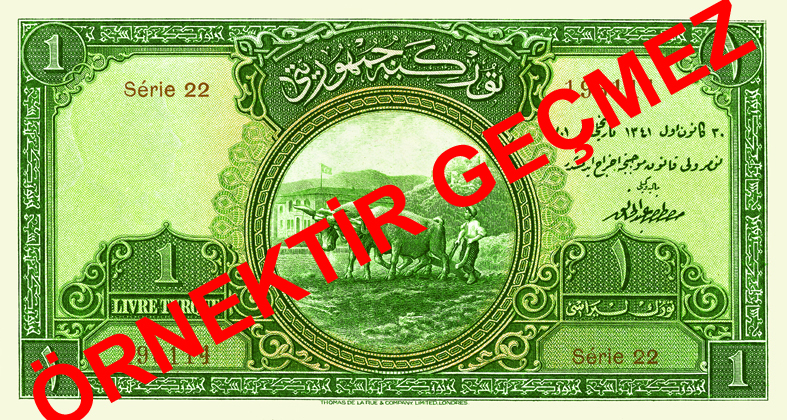
| Issue date | 05.12.1927 |
|---|---|
| Date of withdrawal | 25.04.1939 |
| End of redemption period | 24.04.1949 |
| Signatures | Mustafa Abdülhalik RENDA, Minister of Finance |
| Dimensions | 90x166 mm |
| Front design | House of Parliament, Citadel of Ankara, a ploughing farmer |
| Back design | Former Building of Prime Ministry |
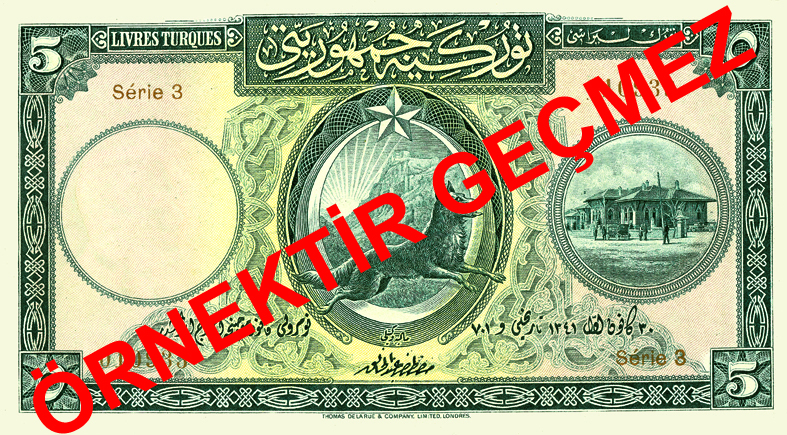
| Issue date | 05.12.1927 |
|---|---|
| Date of withdrawal | 05.10.1937 |
| End of redemption period | 14.10.1947 |
| Signatures | Mustafa Abdülhalik RENDA, Minister of Finance |
| Dimensions | 90x170 mm |
| Front design | The Citadel of Ankara, a grey-wolf and the House of Parliament |
| Back design | A bridge in Ankara |
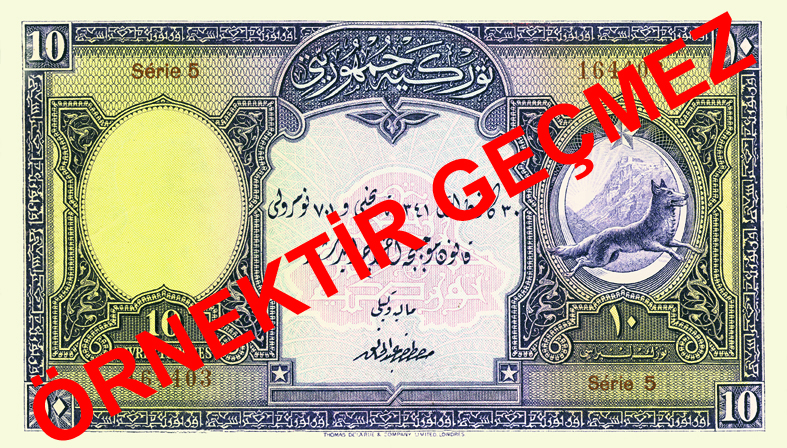
| Issue date | 05.12.1927 |
|---|---|
| Date of withdrawal | 16.05.1938 |
| End of redemption period | 15.05.1948 |
| Signatures | Mustafa Abdülhalik RENDA, Minister of Finance |
| Dimensions | 99x175 mm |
| Front design | The Citadel of Ankara and a grey-wolf |
| Back design | The Citadel of Ankara |
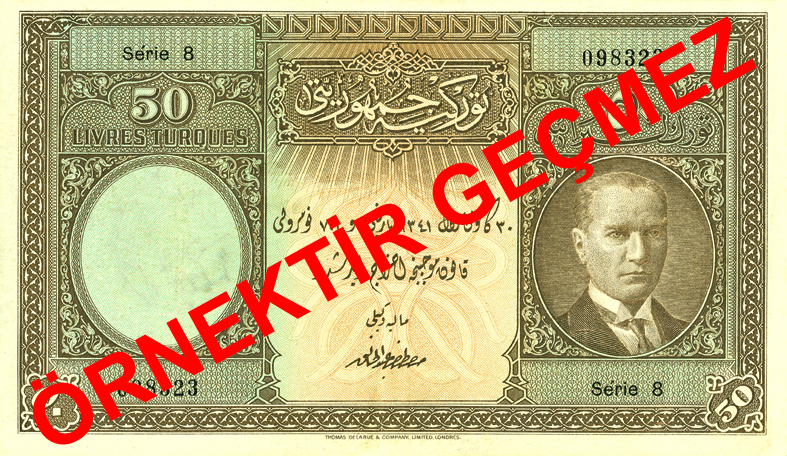
| Issue date | 05.12.1927 |
|---|---|
| Date of withdrawal | 01.04.1938 |
| End of redemption period | 31.03.1948 |
| Signatures | Mustafa Abdülhalik RENDA, Minister of Finance |
| Dimensions | 98x185 mm |
| Front design | A portrait of Atatürk on the right, and a pattern on the center |
| Back design | A view from Afyon |
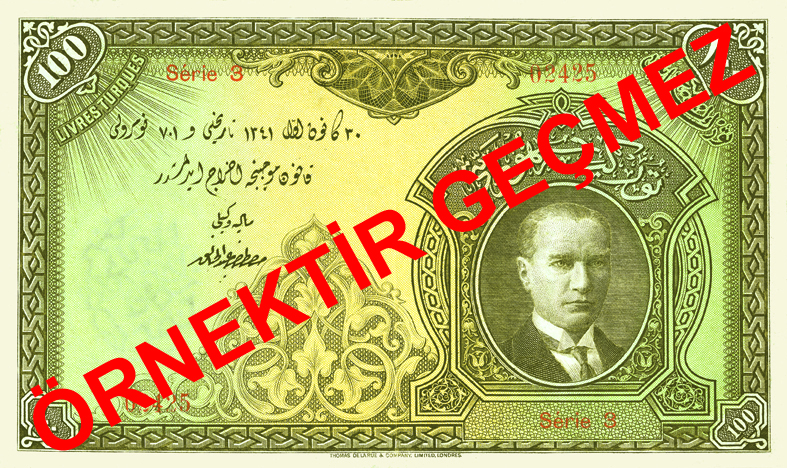
| Issue date | 05.12.1927 |
|---|---|
| Date of withdrawal | 01.03.1938 |
| End of redemption period | 29.02.1948 |
| Signatures | Mustafa Abdülhalik RENDA, Minister of Finance |
| Dimensions | 112x189 mm |
| Front design | A portrait of Atatürk on the right, and a pattern on the left |
| Back design | A view of a village |
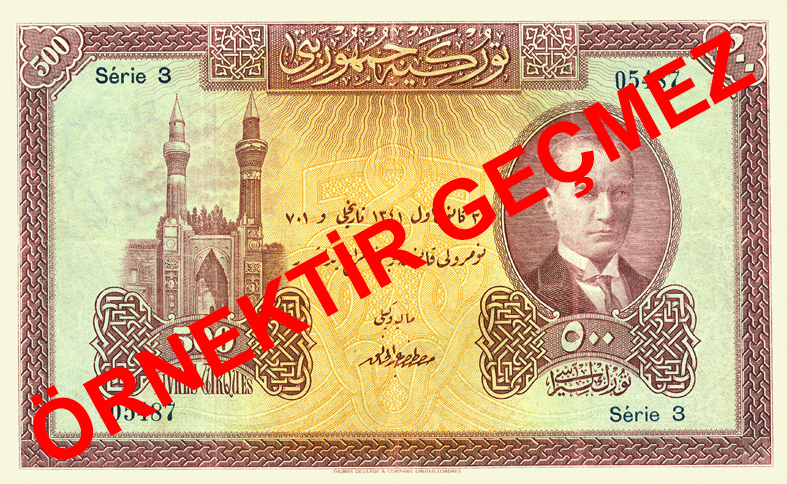
| Issue date | 05.12.1927 |
|---|---|
| Date of withdrawal | 15.06.1939 |
| End of redemption period | 14.06.1949 |
| Signatures | Mustafa Abdülhalik RENDA, Minister of Finance |
| Dimensions | 120x194 mm |
| Front design | A portrait of Atatürk on the right, and the picture of Gökmedrese in sivas on the left |
| Back design | A view from Sivas |
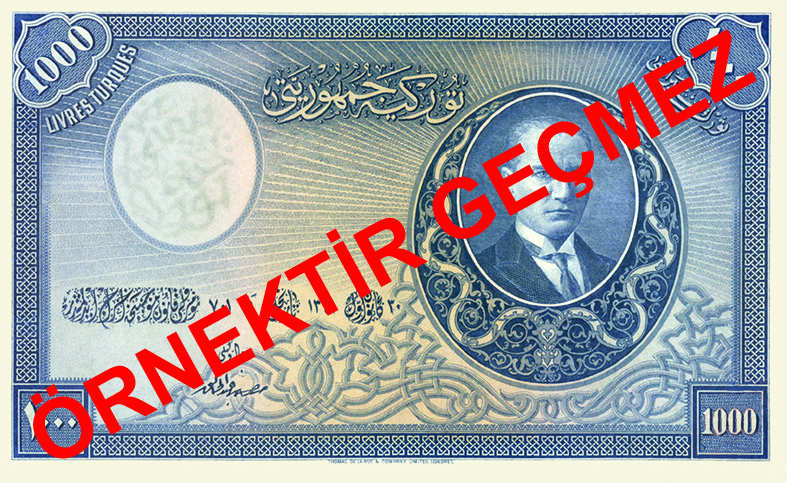
| Issue date | 05.12.1927 |
|---|---|
| Date of withdrawal | 15.06.1939 |
| End of redemption period | 14.06.1949 |
| Signatures | Mustafa Abdülhalik RENDA, Minister of Finance |
| Dimensions | 120x201 mm |
| Front design | A portrait of Atatürk |
| Back design |
A view from the railroad to Sakarya |
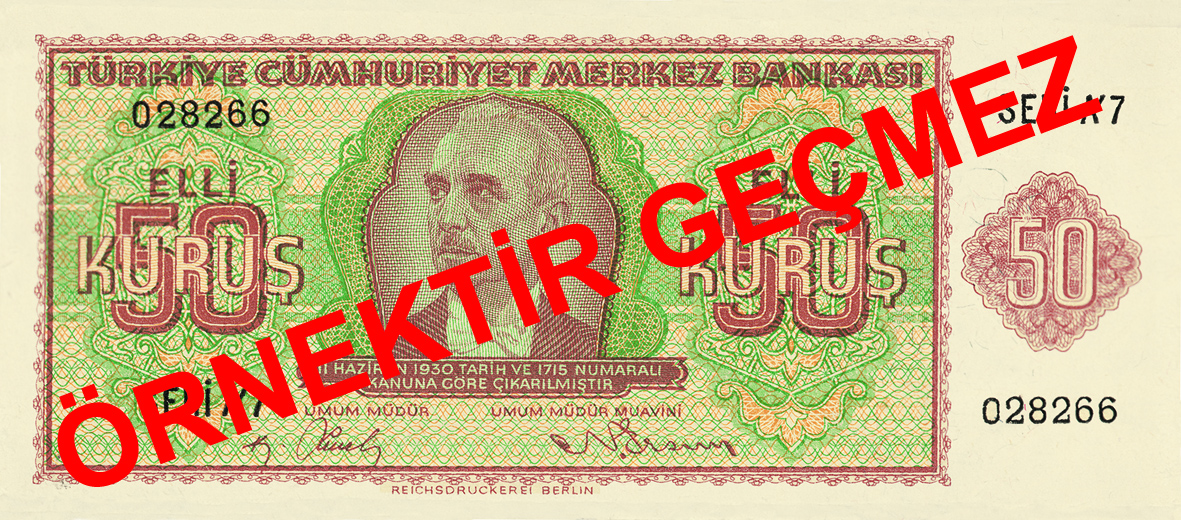
| Issue date | 26.06.1944 |
|---|---|
| Date of withdrawal | 01.08.1947 |
| End of redemption period | 01.08.1957 |
| Signatures | Kemal Zaim SUNEL, Nedim ERSUN |
| Dimensions | 55x125 mm |
| Front design | A portrait of İsmet İnönü |
| Back design | Former Head Office Building of the Central Bank of the Republic of Turkey in Ankara |
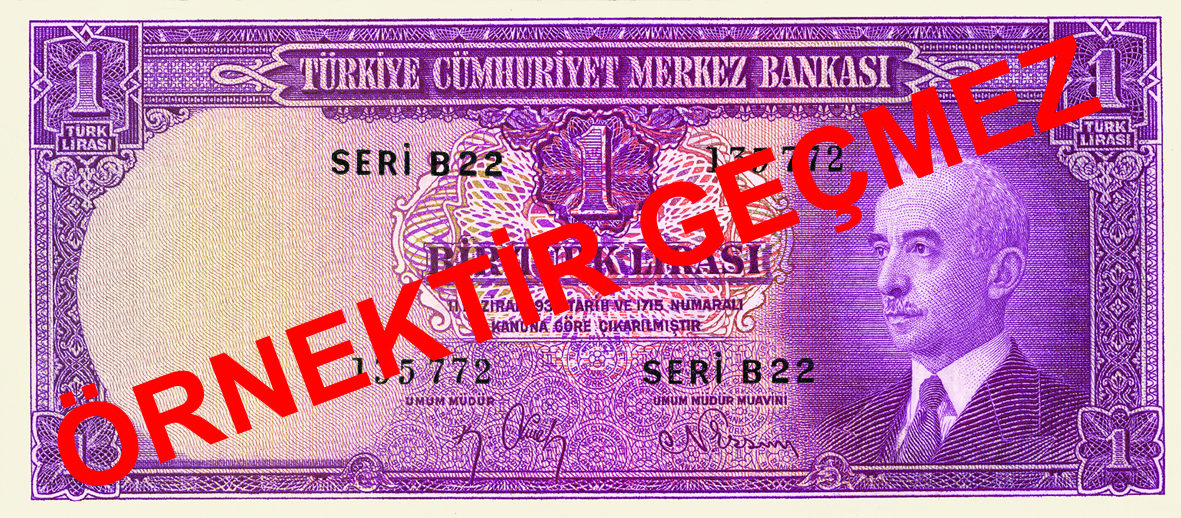
| Issue date | 25.04.1942 |
|---|---|
| Date of withdrawal | 01.08.1947 |
| End of redemption period | 01.08.1957 |
| Signatures | Kemal Zaim SUNEL, Nedim ERSUN |
| Dimensions | 60x135 mm |
| Front design | A portrait of İsmet İnönü |
| Back design | A view from Bosphorus |
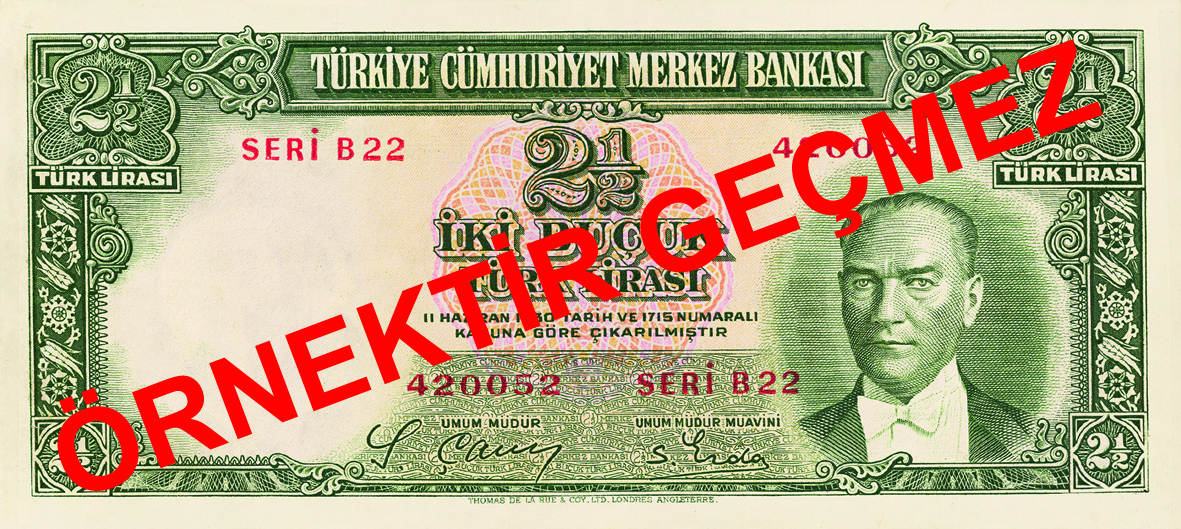
| Issue date | 25.04.1939 |
|---|---|
| Date of withdrawal | 15.07.1952 |
| End of redemption period | 15.07.1962 |
| Signatures | Selahattin Çam, Said Erda |
| Dimensions | 65x145 mm |
| Front design | A portrait of İsmet İnönü |
| Back design | Statue of Victory at Ulus Square in Ankara |
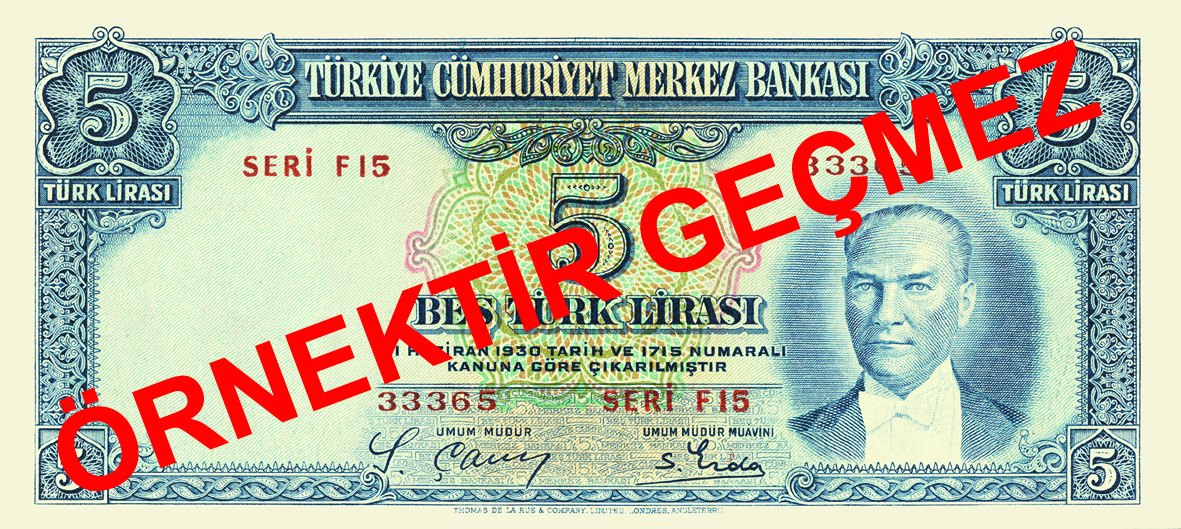
| Issue date | 15.10.1937 |
|---|---|
| Date of withdrawal | 10.11.1952 |
| End of redemption period | 15.07.1962 |
| Signatures | Selahattin Çam, Said Erda |
| Dimensions | 70x155 mm |
| Front design | A portrait of Atatürk |
| Back design | The Security Monument in Ankara |
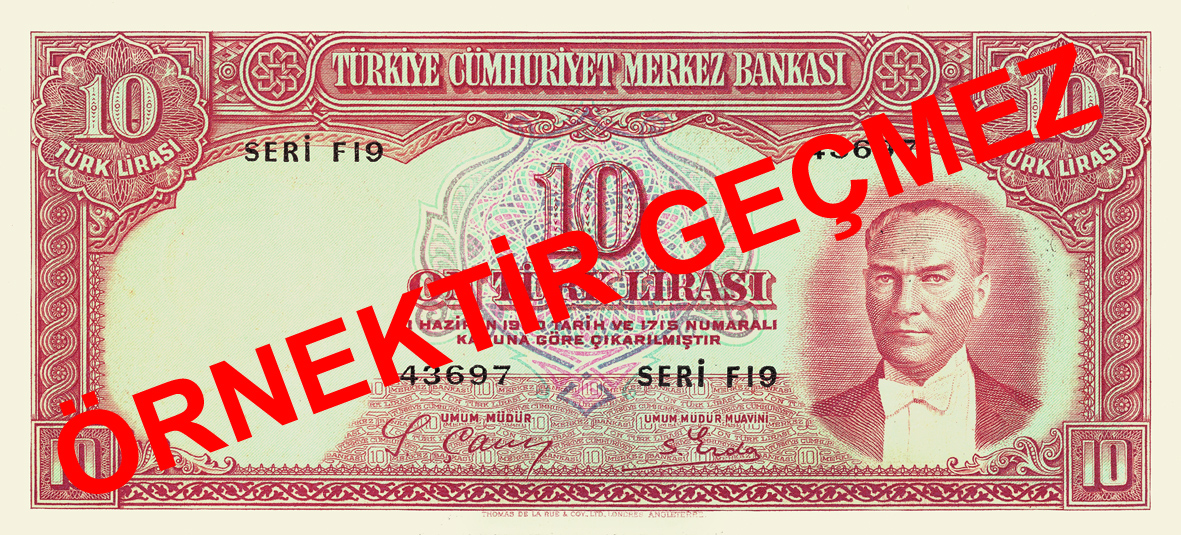
| Issue date | 16.05.1938 |
|---|---|
| Date of withdrawal | 02.06 1952 |
| End of redemption period | 02.06.1962 |
| Signatures | Selahattin Çam, Said Erda |
| Dimensions | 75x165 mm |
| Front design | A portrait of Atatürk |
| Back design | The Citadel of Ankara |

| Issue date | 01.04.1938 |
|---|---|
| Date of withdrawal | 02.06.1952 |
| End of redemption period | 02.06.1962 |
| Signatures | Selahattin Çam, Said Erda |
| Dimensions | 80x175 mm |
| Front design | A portrait of Atatürk |
| Back design | Angora goats |
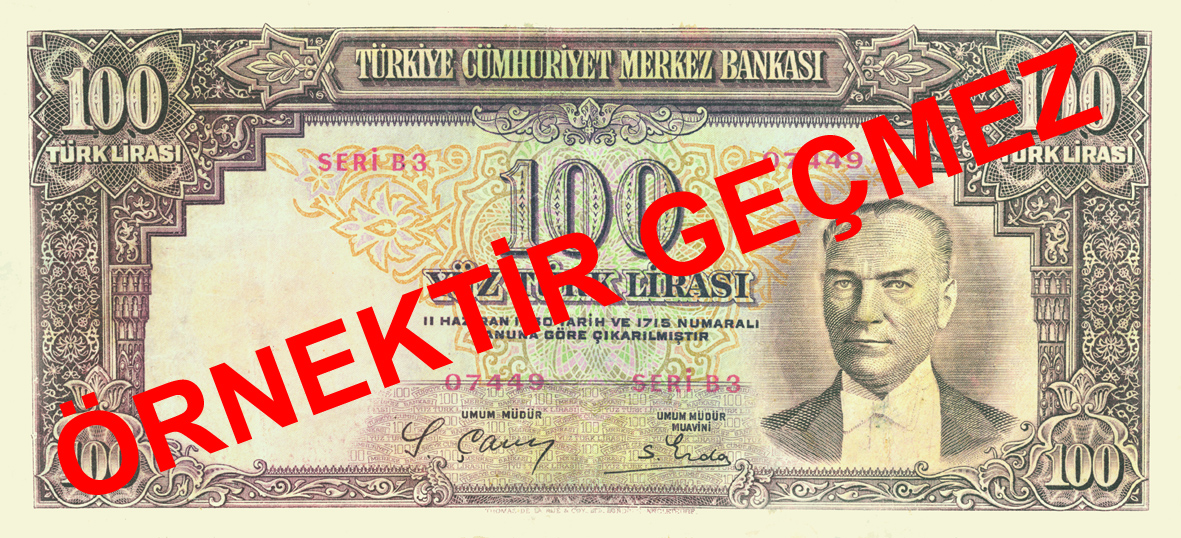
| Issue date | 01.03.1938 |
|---|---|
| Date of withdrawal | 15.10.1942 |
| End of redemption period | 15.10.1952 |
| Signatures | Selahattin Çam, Said Erda |
| Dimensions | 85x185 mm |
| Front design | A portrait of Atatürk |
| Back design | The Dardanelles |
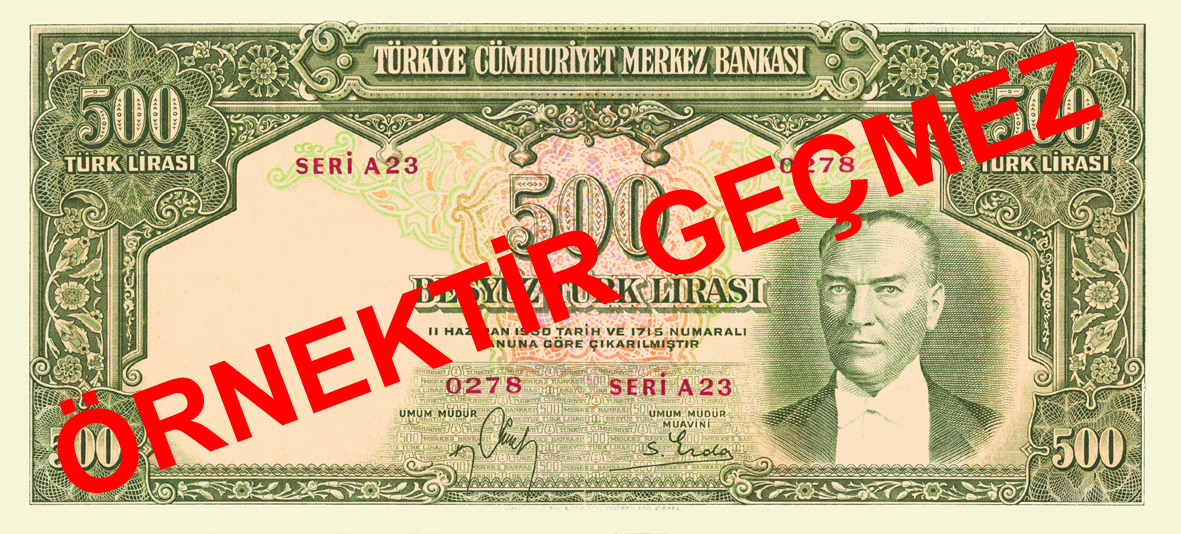
| Issue date | 15.06.1939 |
|---|---|
| Date of withdrawal | 24.04.1946 |
| End of redemption period | 24.04.1956 |
| Signatures | Kemal Zaim SUNEL, Said ERDA |
| Dimensions | 90x195 mm |
| Front design | A portrait of Atatürk |
| Back design | The fortress of Rumeli |
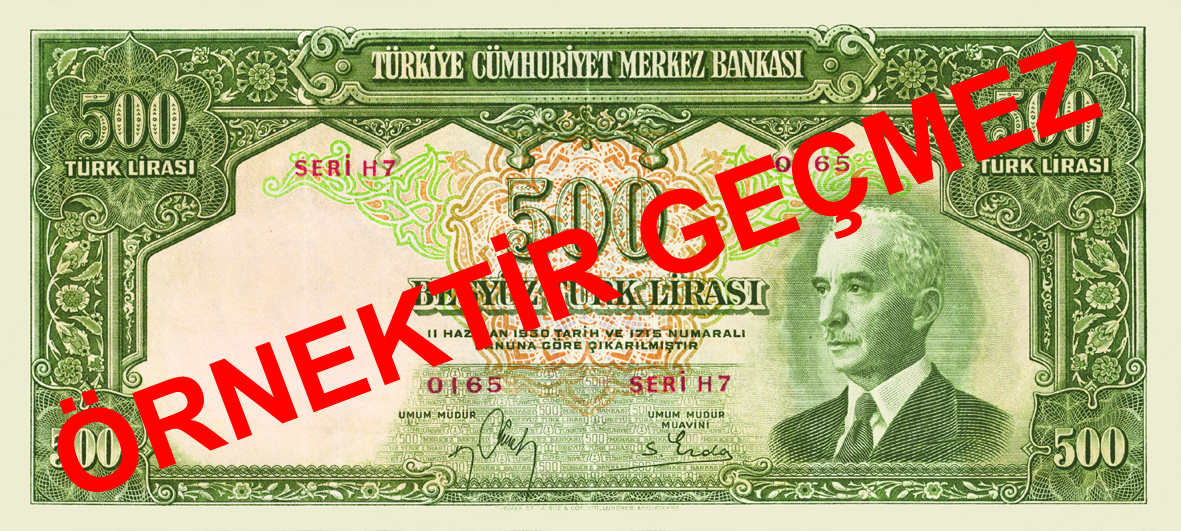
| Issue date | 15.06.1939 |
|---|---|
| Date of withdrawal | 24.04.1946 |
| End of redemption period | 24.04.1956 |
| Signatures | Kemal Zaim SUNEL, Said ERDA |
| Dimensions | 90x195 mm |
| Front design | A portrait of İsmet İnönü |
| Back design | The fortress of Rumeli |
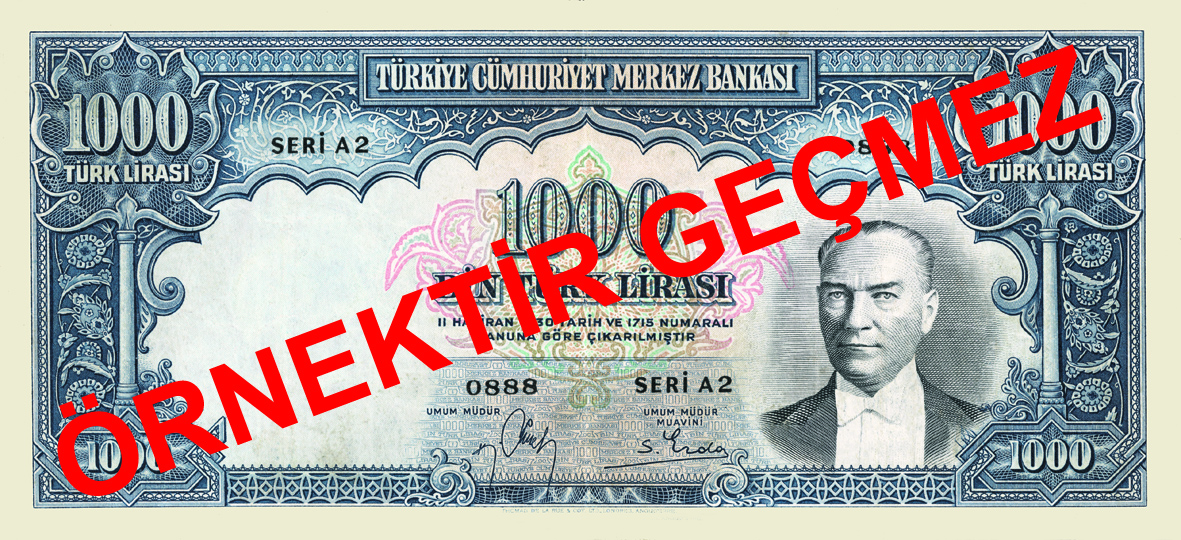
| Issue date | 15.06.1939 |
|---|---|
| Date of withdrawal | 24.04.1946 |
| End of redemption period | 24.04.1956 |
| Signatures | Kemal Zaim SUNEL, Said ERDA |
| Dimensions | 95x205 mm |
| Front design | A portrait of Atatürk |
| Back design | The Security Monument in Ankara |
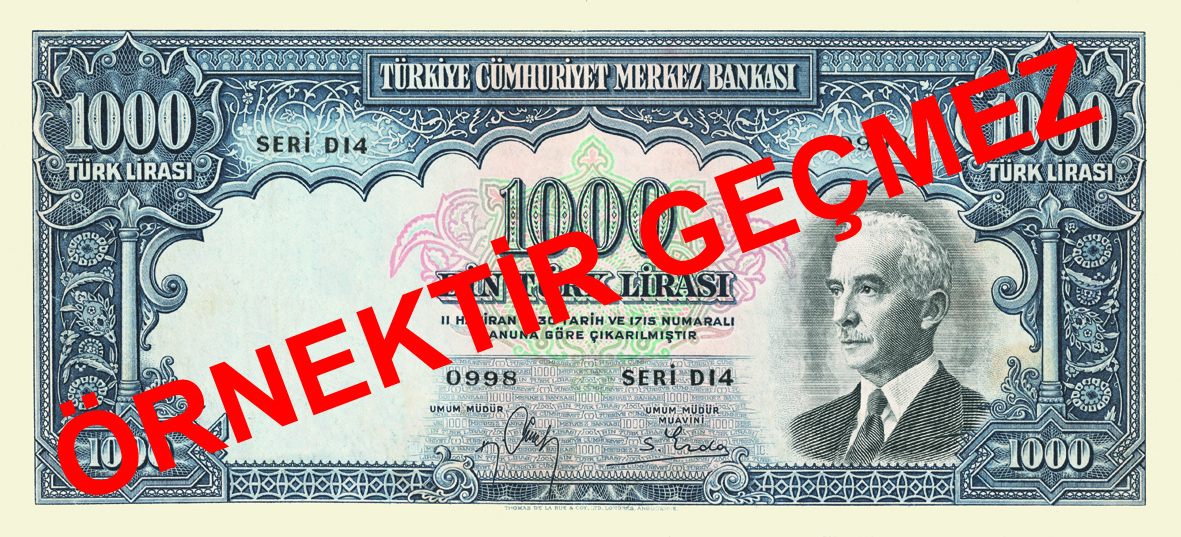
| Issue date | 18.11.1940 |
|---|---|
| Date of withdrawal | 24.04 1946 |
| End of redemption period | 24.04.1956 |
| Signatures | Kemal Zaim SUNEL, Said ERDA |
| Dimensions | 95x205 mm |
| Front design | A portrait of İsmet İnönü |
| Back design | The Security Monument in Ankara |
Series 2 banknotes featured buildings and monuments representing the values of the new Republic. Moreover, designs depicting the Ankara Castle and Ankara goat marked the new capital city of Ankara.
The 5 Turkish lira banknotes were the first banknotes circulated by the Central Bank of the Republic of Türkiye established to complement the country’s economic independence with political independence.
The Banknotes that Sank in the Port of Piraeus
In September 1939, amid growing concerns that the war in Europe could worsen, the Central Bank decided to make preparations for banknotes and reserves. In order to meet the need for banknotes in small denominations, with the consent of the Government, De La Rue[NK1] , the company which had printed banknotes in circulation then in Türkiye, was asked to make an offer. Nevertheless, marine transportation in the Mediterranean became impossible due to the war that broke out between Italy and France. Moreover, the plants that were due to print the banknotes were in the war zone. The De La Rue banknote printing facility in London was bombed by Germans. Meanwhile, it was decided by Türkiye to have 500 and 1,000 Turkish lira denominations featuring the portrait of İsmet İnönü. These banknotes were loaded on ships on 30 July 1940 and arrived in Istanbul through the Suez Canal. Afterwards, banknotes in 50 kuruş and 100 Turkish lira denominations were printed and set sail in October 1940.
The ship City of Roubaix carrying a cargo of the older design banknotes in 100 Turkish lira denomination and newly designed banknotes in 50 kuruş denomination sank in the Port of Piraeus in Greece five months after setting sail. After the accident, the local people collected the banknotes in the ship’s cargo. Therefore, the Prime Ministry issued an emergency announcement stating that those banknotes would not be circulated. The Greek authorities were contacted immediately and the banknotes saved from the ship and handed to Turkish authorities. In another incident, banknotes in 50 Turkish lira denomination, which were also printed in the UK, were damaged in an air raid in London and couldn’t be put into circulation.

The Series 3 banknotes, all of which featured the portrait of President İsmet İnönü, stayed in circulation between 1942 and 1947. The Series 3 banknotes, which were printed in six denominations: 2 ½, 10, 50, 100, 500 and 1,000 Turkish liras, were printed in the UK, Germany and USA.

| Issue date | 27.03.1947 |
|---|---|
| Date of withdrawal | 15.07.1952 |
| End of redemption period | 15.07.1962 |
| Signatures | Kemal Zaim SUNEL, Nedim ERSUN, Kamil KIBRIZLI |
| Dimensions | 65x145 mm |
| Front design | A portrait of İsmet İnönü |
| Back design | The House of Commons in Ankara |

| Issue date | 15.01.1942 |
|---|---|
| Date of withdrawal | 01.04.1950 |
| End of redemption period | 01.04.1960 |
| Signatures | Kemal Zaim SUNEL, Nedim ERSUN |
| Dimensions | 65x155 mm |
| Front design | A portrait of İsmet İnönü |
| Back design | Three Turkish village women in local costumes |

| Issue date | 25.04.1942 |
|---|---|
| Date of withdrawal | 01.12.1951 |
| End of redemption period | 01.12.1961 |
| Signatures | Kemal Zaim SUNEL, Nedim ERSUN |
| Dimensions | 80x175 mm |
| Front design | A portrait of İsmet İnönü |
| Back design | Angora goats |
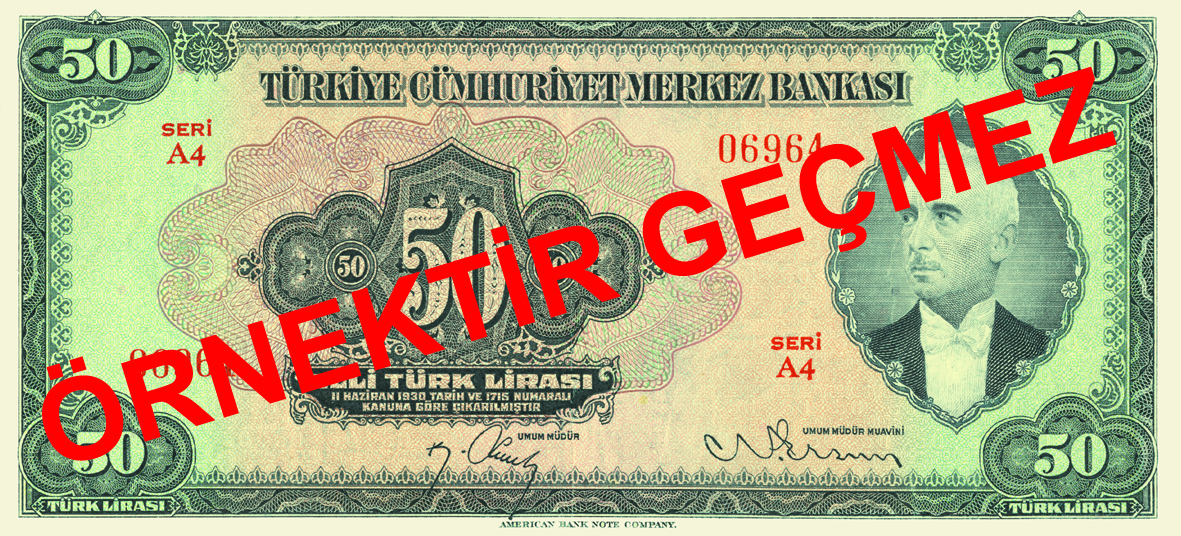
| Issue date | 17.02.1947 |
|---|---|
| Date of withdrawal | 01.12.1951 |
| End of redemption period | 01.12.1961 |
| Signatures | Kemal Zaim SUNEL, Nedim ERSUN |
| Dimensions | 80x175 mm |
| Front design | A portrait of İsmet İnönü |
| Back design | Angora goats |
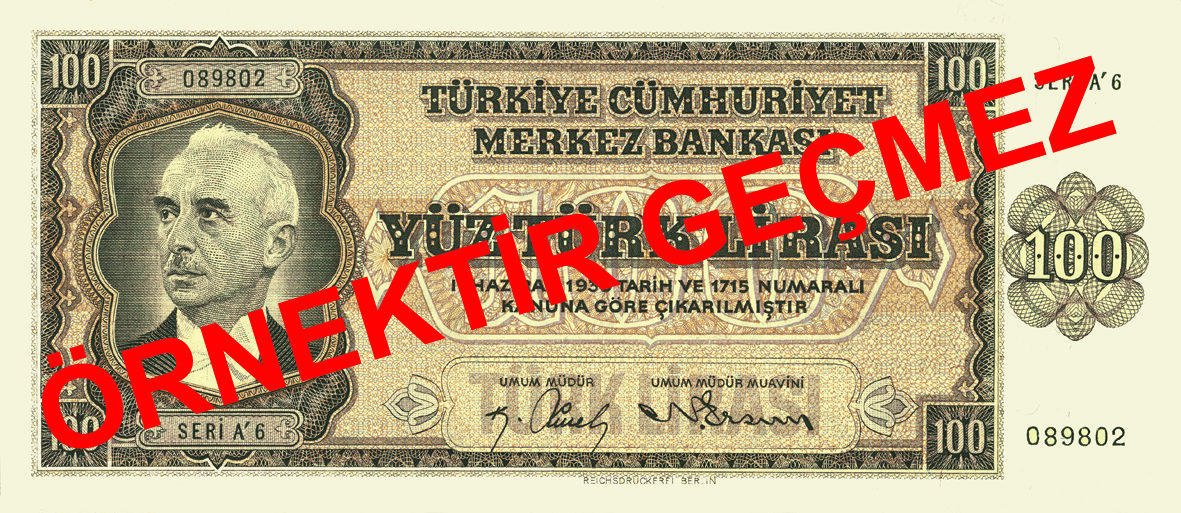
| Issue date | 15.08.1942 |
|---|---|
| Date of withdrawal | 25.04.1946 |
| End of redemption period | 09.08.1948 |
| Signatures | Kemal Zaim SUNEL, Nedim ERSUN |
| Dimensions | 75x175 mm |
| Front design | A portrait of İsmet İnönü |
| Back design | A girl holding grapes |
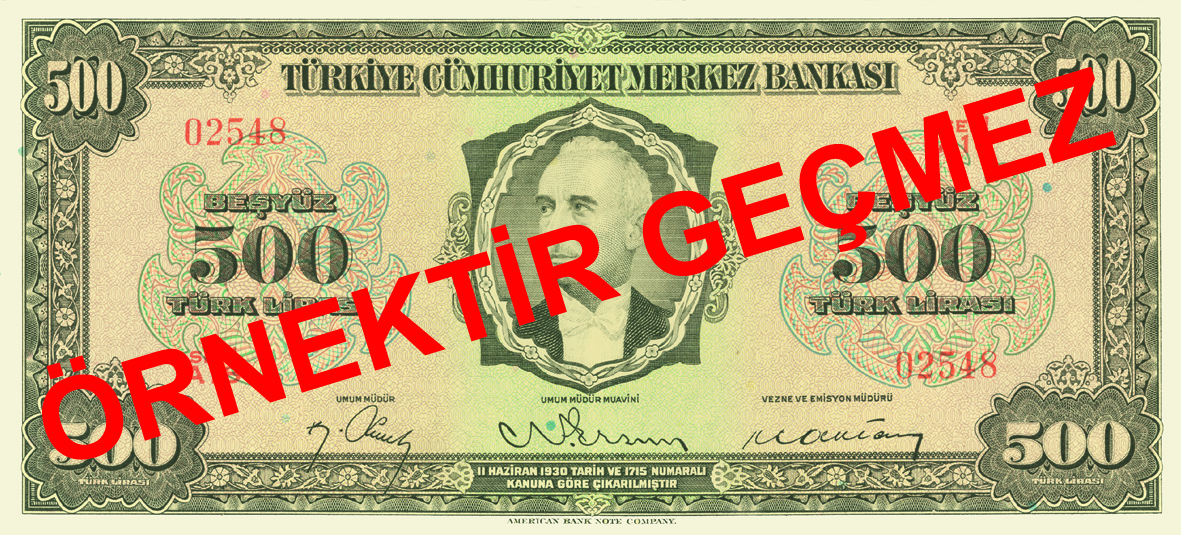
| Issue date | 24.04.1946 |
|---|---|
| Date of withdrawal | 15.04.1953 |
| End of redemption period | 15.04.1963 |
| Signatures | Kemal Zaim SUNEL, Nedim ERSUN, Fethi AKTAN |
| Dimensions | 85x185 mm |
| Front design | A portrait of İsmet İnönü |
| Back design | Students at the Technical School in Ankara |
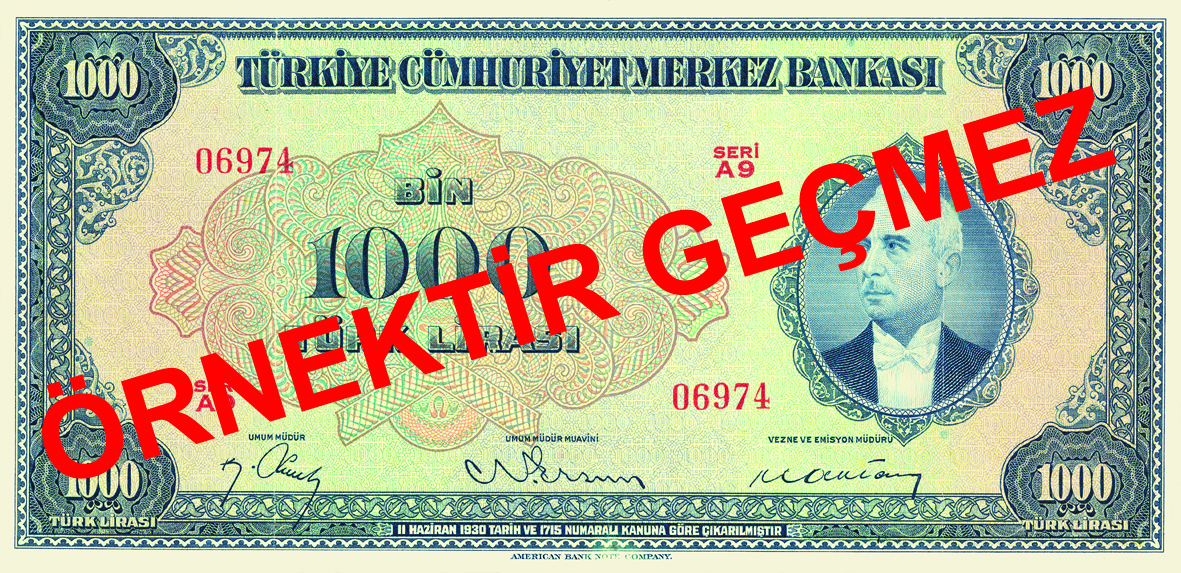
| Issue date | 24.04.1946 |
|---|---|
| Date of withdrawal | 15.04.1953 |
| End of redemption period | 15.04.1963 |
| Signatures | Kemal Zaim SUNEL, Nedim ERSUN, Fethi AKTAN |
| Dimensions | 95x195 mm |
| Front design | A portrait of İsmet İnönü |
| Back design | Scouts |
In the Series 3 banknotes, buildings and monuments used in Series 2 banknotes were replaced by figures of villagers, grapes that were one of the most important export items of Türkiye, students working on a machine representing industrialization, and figures of boy and girl scouts which was a very popular social activity in those years.
The 100 TL banknotes in this series were printed by the German banknote printer Reichsdruckerei in Berlin in four versions A, B, C and D. The total number of banknotes printed was 9 million. These banknotes were put into circulation on 15 August 1942. However, several years later, E, F, G, H and J versions of these banknotes were detected in the market. Therefore, the Central Bank made an emergency announcement rescinding these banknotes. Because of this incident, the Central Bank did not work with that banknote printing company again. Banknotes in 50, 500 and 1,000 Turkish lira denominations circulated between 1946- 1948 and all of the Series 4 banknotes were printed by the American Banknote Company.
The Series 4 banknotes had the least number of denominations and versions. This series was printed only in two denominations: 10 and 100 Turkish liras. The 10 Turkish lira banknotes had two versions and the 100 Turkish lira banknotes had one version. The obverse side of the banknotes featured President İsmet İnönü’s portrait and the reverse side featured historical places in Istanbul such as Sultan Ahmet Fountain and Rumeli Fortress. These banknotes were printed in the USA.

| Issue date | 17.02.1947 |
|---|---|
| Date of withdrawal | 02.06.1952 |
| End of redemption period | 02.06.1962 |
| Signatures | Kemal Zaim SUNEL, Nedim ERSUN |
| Dimensions | 95x195 mm |
| Front design | A portrait of İsmet İnönü |
| Back design | The Sultan Ahmet Fountain in İstanbul |
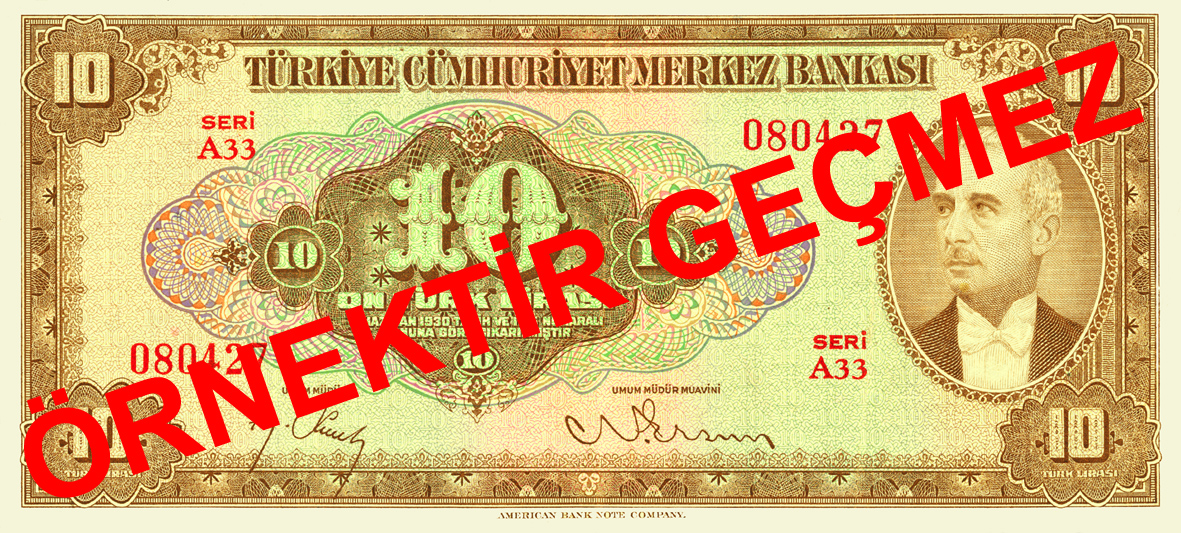
| Issue date | 15.09.1948 |
|---|---|
| Date of withdrawal | 02.06.1952 |
| End of redemption period | 02.06.1962 |
| Signatures | Kemal Zaim SUNEL, Nedim ERSUN |
| Dimensions | 75x165 mm |
| Front design | A portrait of İsmet İnönü |
| Back design | The Sultan Ahmet Fountain in İstanbul |
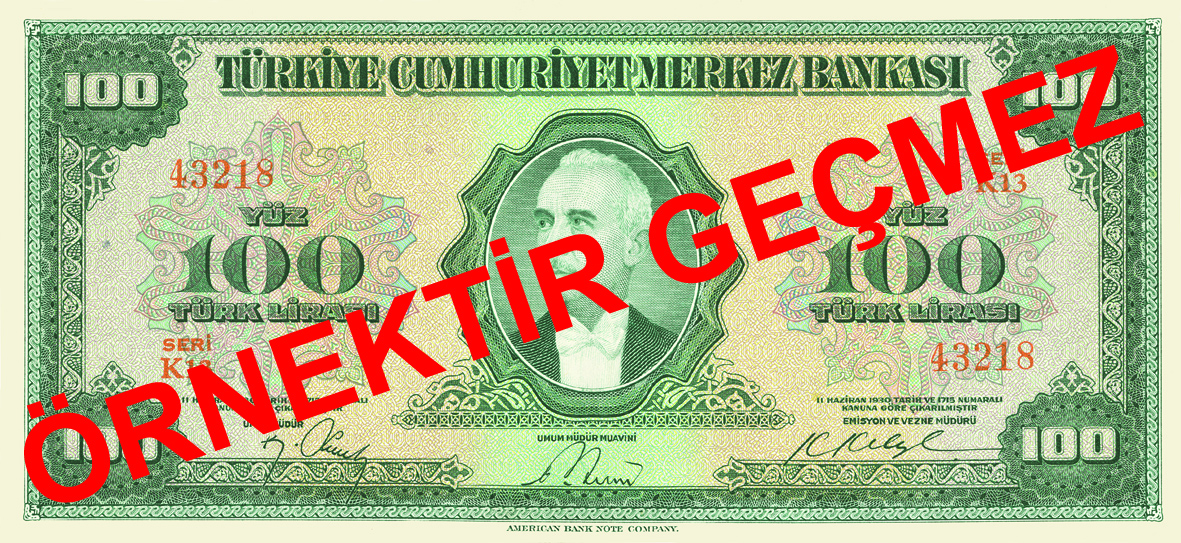
| Issue date | 18.07.1947 |
|---|---|
| Date of withdrawal | 10.10.1952 |
| End of redemption period | 10.10.1962 |
| Signatures | Kemal Zaim SUNEL, Sadi BEKTER, Kamil KIBRIZLI |
| Dimensions | 83x181 mm |
| Front design | A portrait of İsmet İnönü |
| Back design | The Fortress of Rumeli at Bosphorus |
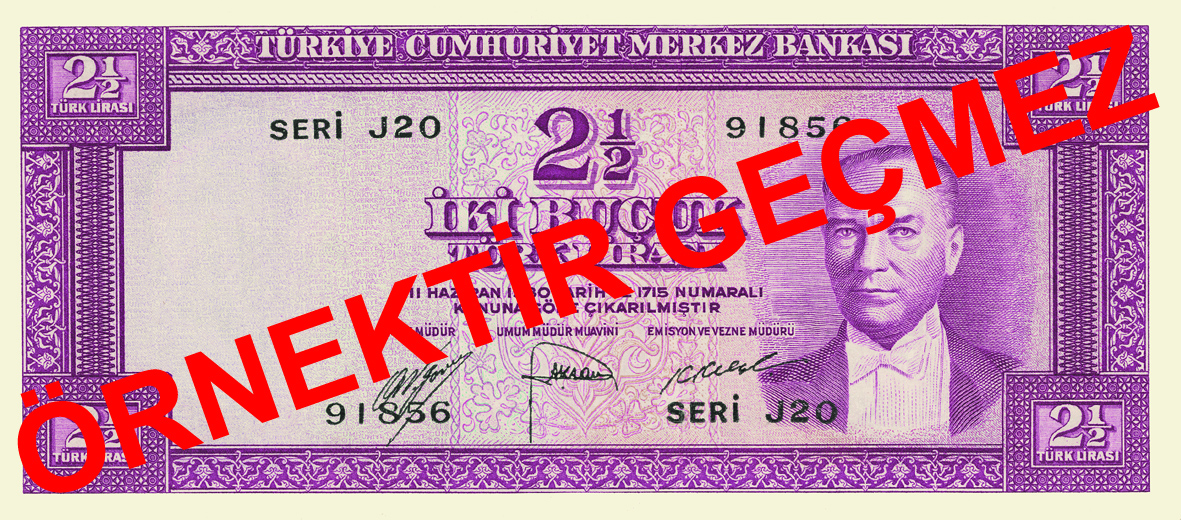
| Issue date | 15.07.1952 |
|---|---|
| Date of withdrawal | 20.10.1966 |
| End of redemption period | 20.10.1976 |
| Signatures | Osman Nuri GÖVER, Reşat AKSAN, Kamil KIBRIZLI |
| Dimensions | 65x145 mm |
| Front design | A portrait of Atatürk |
| Back design | Former Head Office Building of the Central Bank of the Republic of Turkey in Ankara |
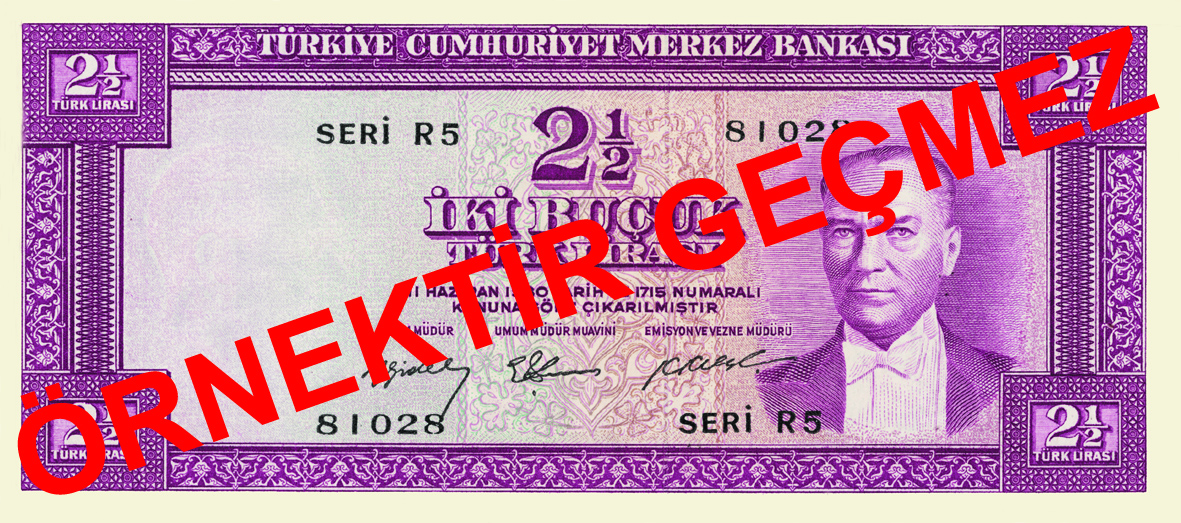
| Issue date | 03.01.1955 |
|---|---|
| Date of withdrawal | 20.10.1966 |
| End of redemption period | 20.10.1976 |
| Signatures | Nail GİDEL, Emir SENCER, Kamil KIBRIZLI |
| Dimensions | 65x145 mm |
| Front design | A portrait of Atatürk |
| Back design | Former Head Office Building of the Central Bank of the Republic of Turkey in Ankara |
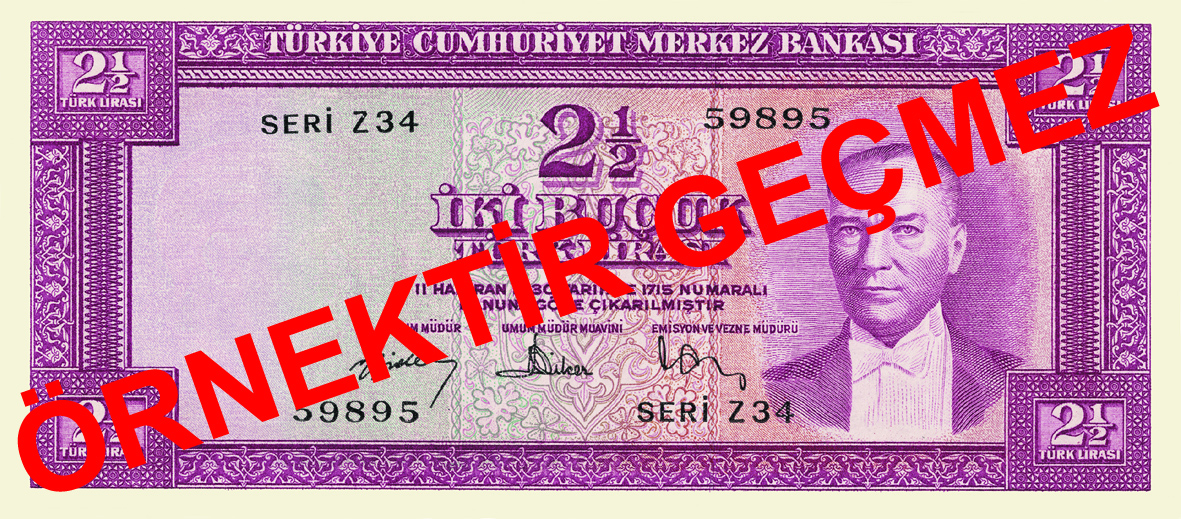
| Issue date | 01.07.1957 |
|---|---|
| Date of withdrawal | 20.10.1966 |
| End of redemption period | 20.10.1976 |
| Signatures | Nail GİDEL, Fikri DİKER, Ekrem SUNGAR |
| Dimensions | 65x145 mm |
| Front design | A portrait of Atatürk |
| Back design | Former Head Office Building of the Central Bank of the Republic of Turkey in Ankara |
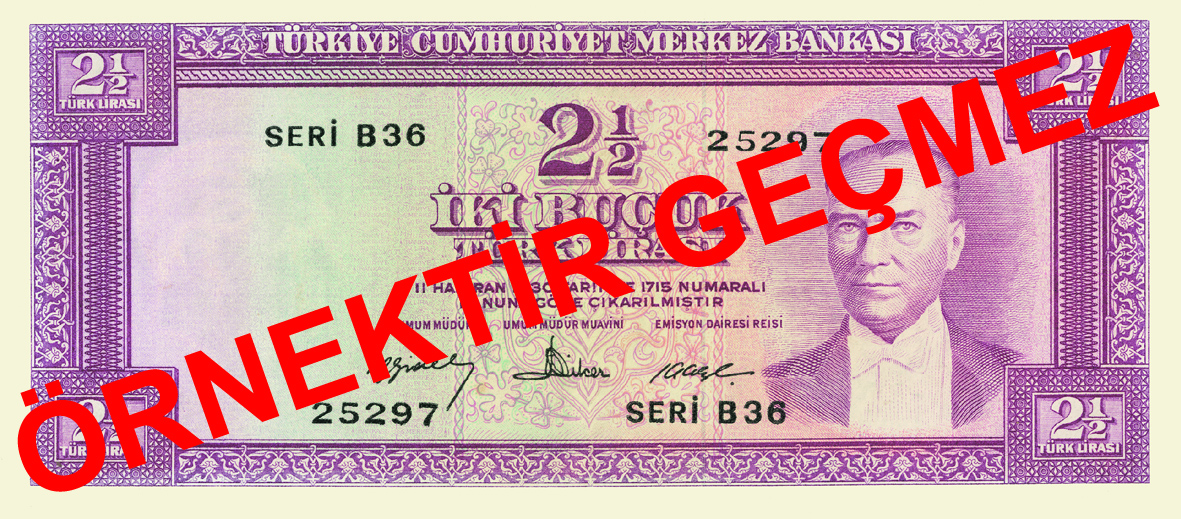
| Issue date | 15.02.1960 |
|---|---|
| Date of withdrawal | 20.10.1966 |
| End of redemption period | 20.10.1976 |
| Signatures | Nail GİDEL, Fikri DİKER, Kamil KIBRIZLI |
| Dimensions | 65x145 mm |
| Front design | A portrait of Atatürk |
| Back design | Former Head Office Building of the Central Bank of the Republic of Turkey in Ankara |
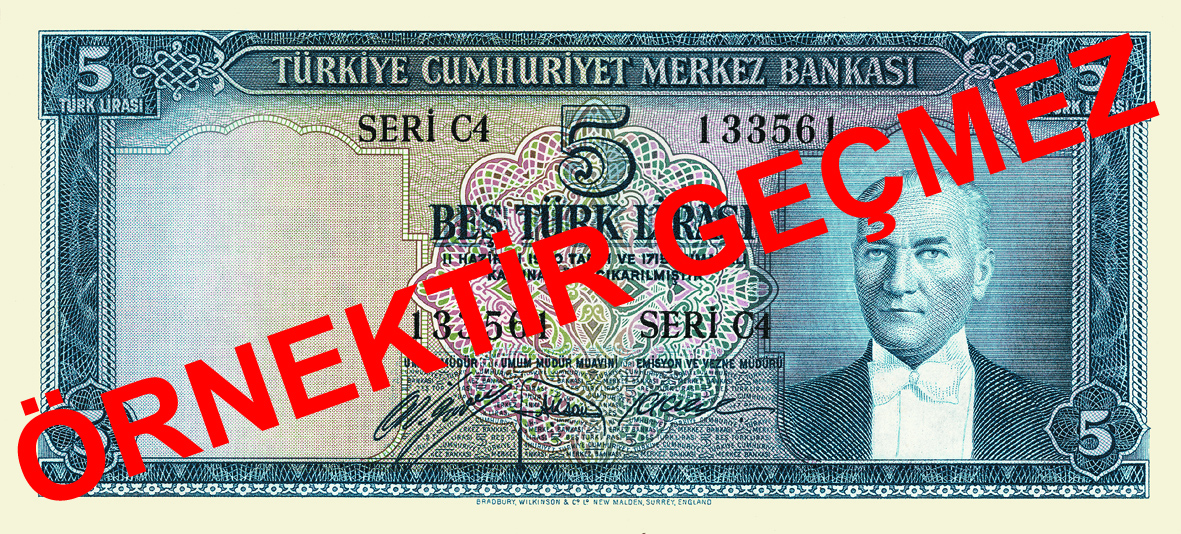
| Issue date | 10.11.1952 |
|---|---|
| Date of withdrawal | 08.01.1968 |
| End of redemption period | 08.01.1978 |
| Signatures | Osman Nuri GÖVER, Reşat AKSAN, Kamil KIBRIZLI |
| Dimensions | 68x150 mm |
| Front design | A portrait of Atatürk |
| Back design | Three Turkish girls with hazel-nut baskets |
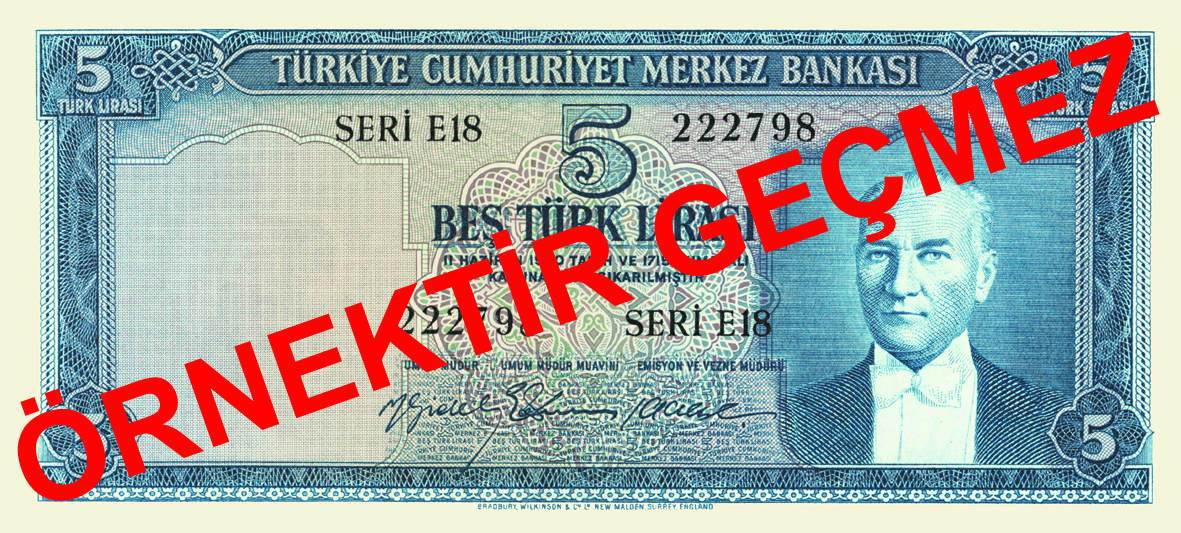
| Issue date | 08.06.1959 |
|---|---|
| Date of withdrawal | 08.01.1968 |
| End of redemption period | 08.01.1978 |
| Signatures | Nail GİDEL, Emir SENCER, Kamil KIBRIZLI |
| Dimensions | 68x150 mm |
| Front design | A portrait of Atatürk |
| Back design | Three Turkish girls with hazel-nut baskets |
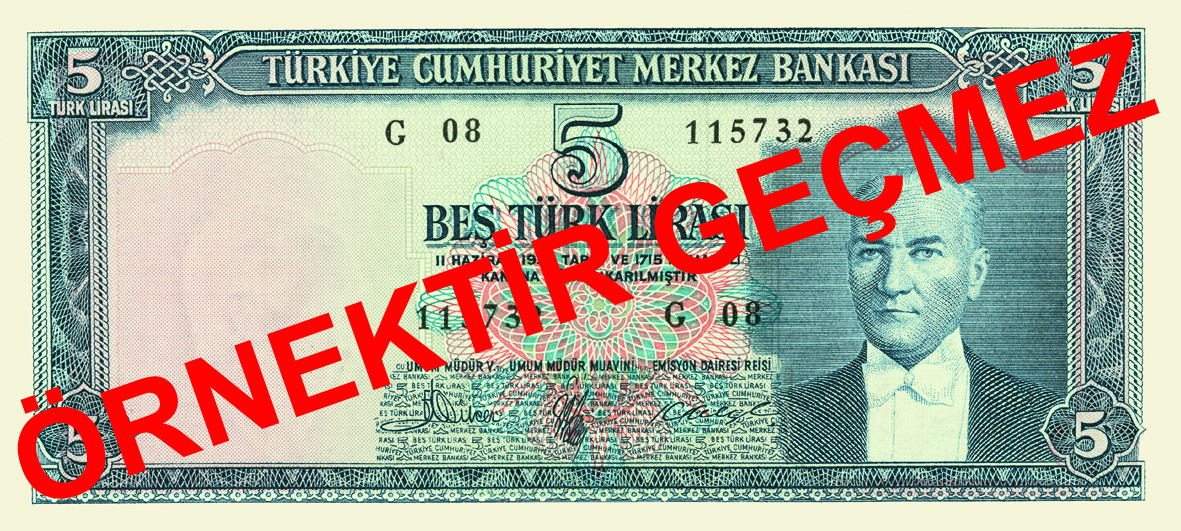
| Issue date | 25.10.1961 |
|---|---|
| Date of withdrawal | 08.01.1968 |
| End of redemption period | 08.01.1978 |
| Signatures | Fikri DİKER, Emin Ali SERİM, Kamil KIBRIZLI |
| Dimensions | 68x150 mm |
| Front design | A portrait of Atatürk |
| Back design | Three Turkish girls with hazel-nut baskets |
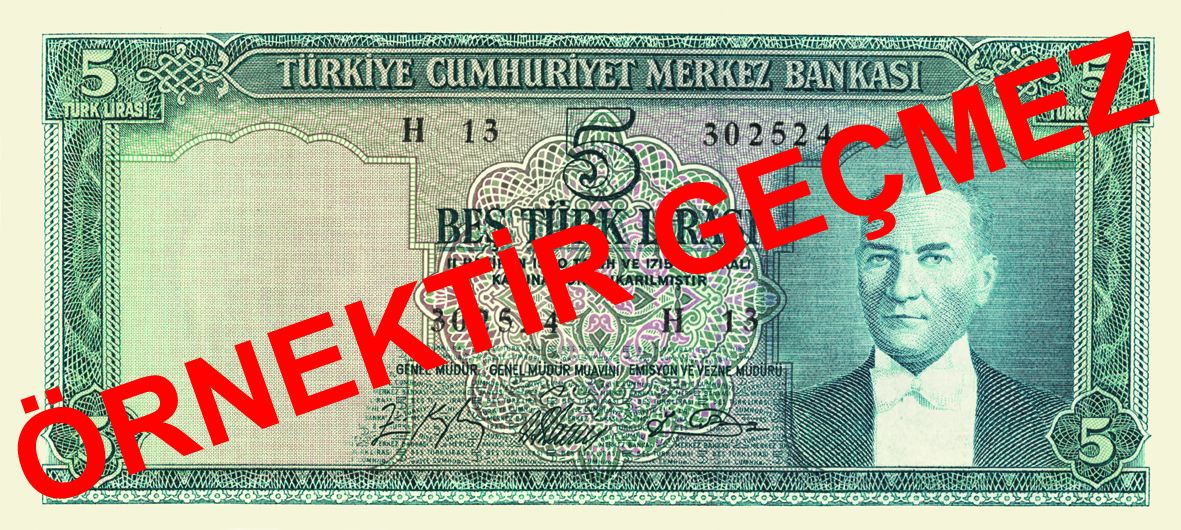
| Issue date | 04.01.1965 |
|---|---|
| Date of withdrawal | 08.01.1968 |
| End of redemption period | 08.01.1978 |
| Signatures | Ziya KAYLA, Emin Ali SERİM, Yahya ARSLANER |
| Dimensions | 68x150 mm |
| Front design | A portrait of Atatürk |
| Back design | Three Turkish girls with hazel-nut baskets |
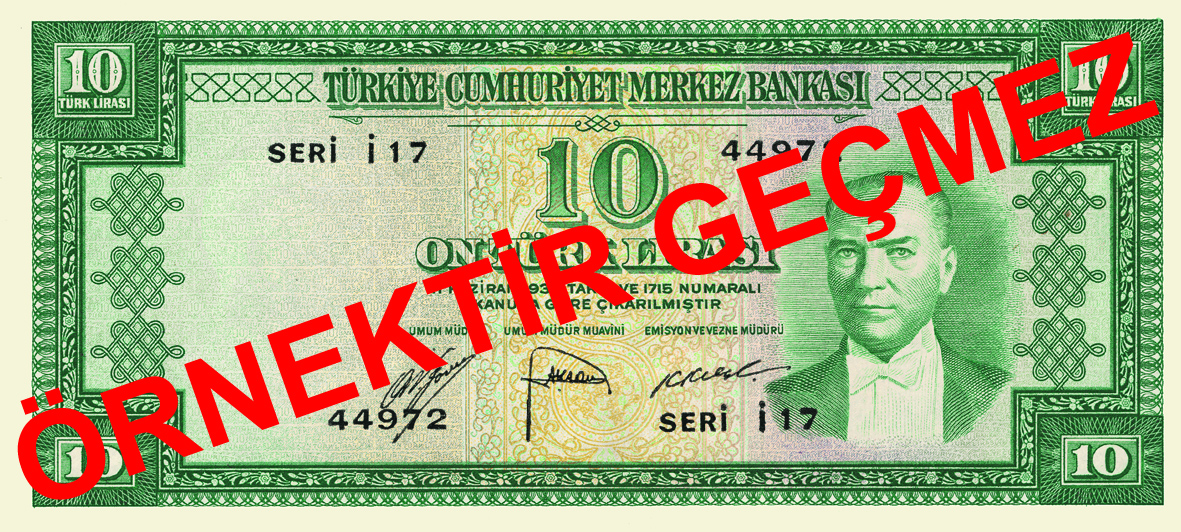
| Issue date | 02.06.1952 |
|---|---|
| Date of withdrawal | 04.07.1966 |
| End of redemption period | 04.07.1976 |
| Signatures | Osman Nuri GÖVER, Reşat AKSAN, Kamil KIBRIZLI |
| Dimensions | 71x155 mm |
| Front design | A portrait of Atatürk |
| Back design | The Bridge of Meric in Edirne |
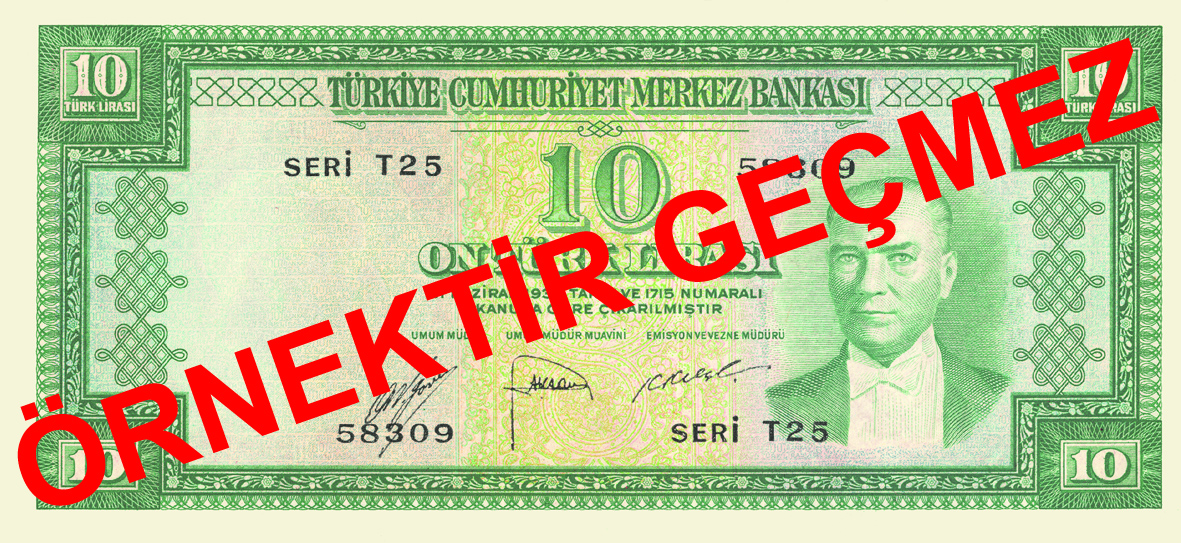
| Issue date | 26.10.1953 |
|---|---|
| Date of withdrawal | 04.07.1966 |
| End of redemption period | 04.07.1976 |
| Signatures | Osman Nuri GÖVER, Reşat AKSAN, Kamil KIBRIZLI |
| Dimensions | 71x155 mm |
| Front design | A portrait of Atatürk |
| Back design | The Bridge of Meric in Edirne |
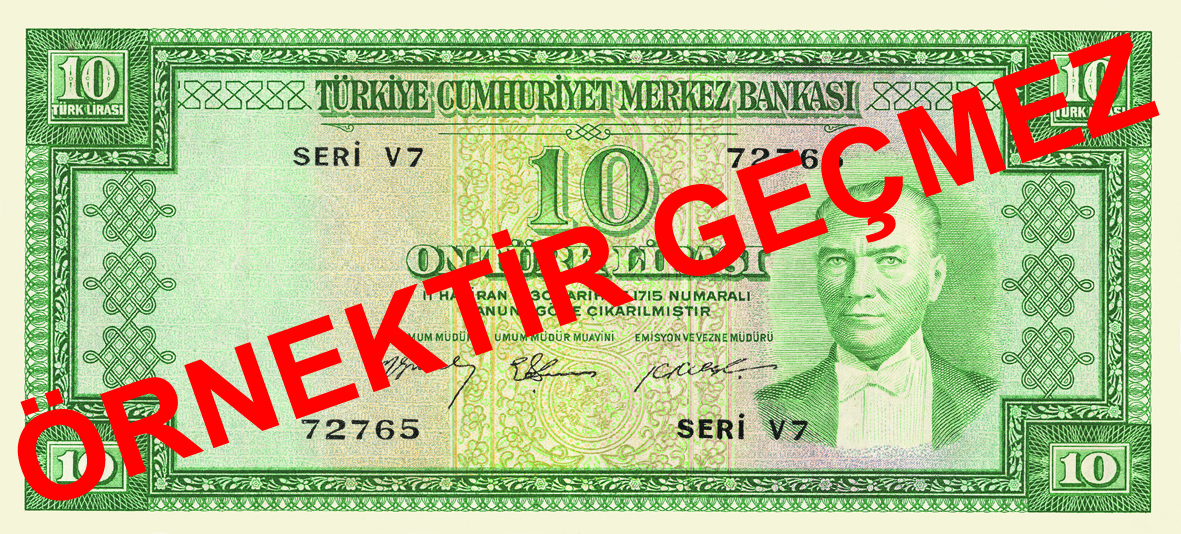
| Issue date | 24.03.1958 |
|---|---|
| Date of withdrawal | 04.07.1966 |
| End of redemption period | 04.07.1976 |
| Signatures | Nail GİDEL, Emir SENCER, Kamil KIBRIZLII |
| Dimensions | 71x155 mm |
| Front design | A portrait of Atatürk |
| Back design | The Bridge of Meric in Edirne |
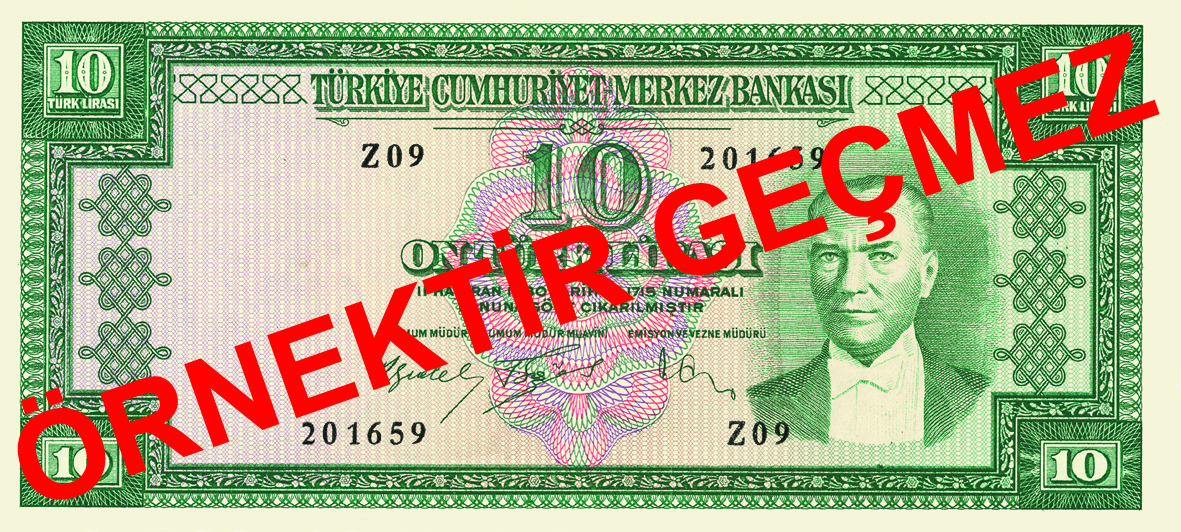
| Issue date | 25.04.1960 |
|---|---|
| Date of withdrawal | 04.07.1966 |
| End of redemption period | 04.07.1976 |
| Signatures | Nail GİDEL, Fikret SÖZER, Ekrem SUNGAR |
| Dimensions | 71x155 mm |
| Front design | A portrait of Atatürk |
| Back design | The Bridge of Meric in Edirne |

| Issue date | 15.05.1961 |
|---|---|
| Date of withdrawal | 04.07.1966 |
| End of redemption period | 04.07.1976 |
| Signatures | Nail GİDEL, Fikret SÖZER, Ekrem SUNGAR |
| Dimensions | 71x155 mm |
| Front design | A portrait of Atatürk |
| Back design | The Bridge of Meric in Edirne |
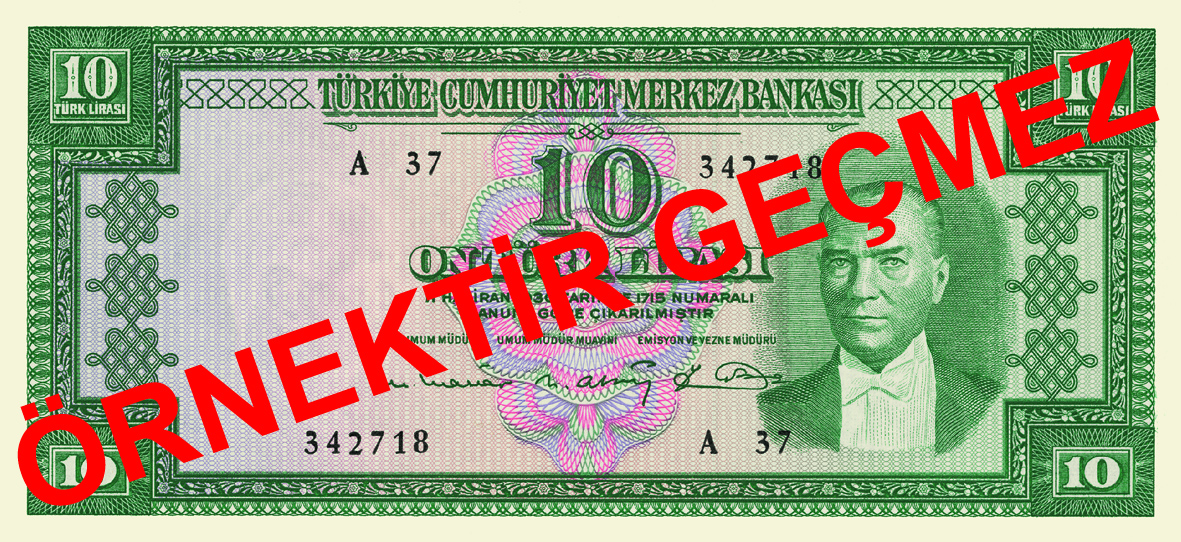
| Issue date | 15.05.1961 |
|---|---|
| Date of withdrawal | 04.07.1966 |
| End of redemption period | 04.07.1976 |
| Signatures | Nail GİDEL, Fikret SÖZER, Ekrem SUNGAR |
| Dimensions | 71x155 mm |
| Front design | A portrait of Atatürk |
| Back design | The Bridge of Meric in Edirne |
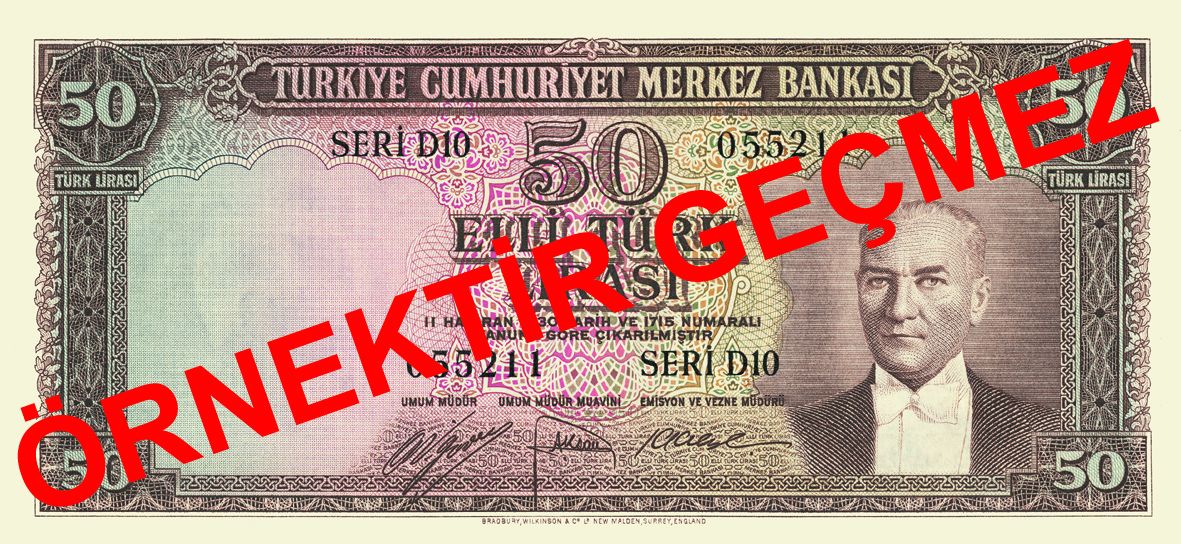
| Issue date | 01.12.1951 |
|---|---|
| Date of withdrawal | 07.05.1979 |
| End of redemption period | 07.05.1989 |
| Signatures | Osman Nuri GÖVER, Reşat AKSAN, Kamil KIBRIZLI |
| Dimensions | 74x160 mm |
| Front design | A portrait of Atatürk |
| Back design | A figure from the Statue of Victory at Ulus Square in Ankara |
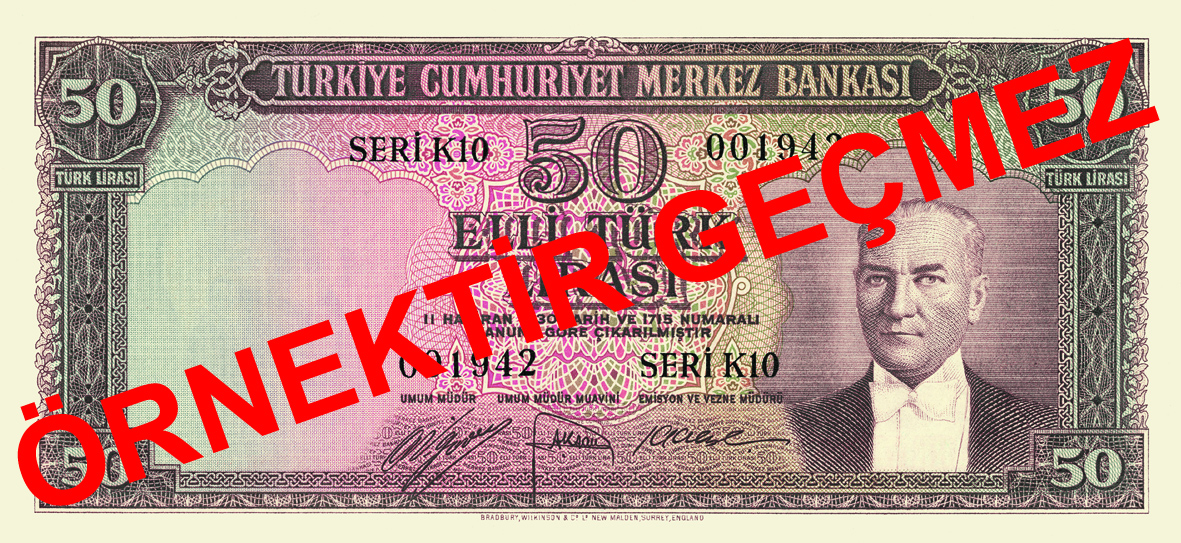
| Issue date | 02.02.1953 |
|---|---|
| Date of withdrawal | 07.05.1979 |
| End of redemption period | 07.05.1989 |
| Signatures | Osman Nuri GÖVER, Reşat AKSAN, Kamil KIBRIZLI |
| Dimensions | 74x160 mm |
| Front design | A portrait of Atatürk |
| Back design | A figure from the Statue of Victory at Ulus Square in Ankara |

| Issue date | 15.10.1956 |
|---|---|
| Date of withdrawal | 07.05.1979 |
| End of redemption period | 07.05.1989 |
| Signatures | Nail GİDEL, Emir SENCER, Kamil KIBRIZLI |
| Dimensions | 74x160 mm |
| Front design | A portrait of Atatürk |
| Back design | A figure from the Statue of Victory at Ulus Square in Ankara |
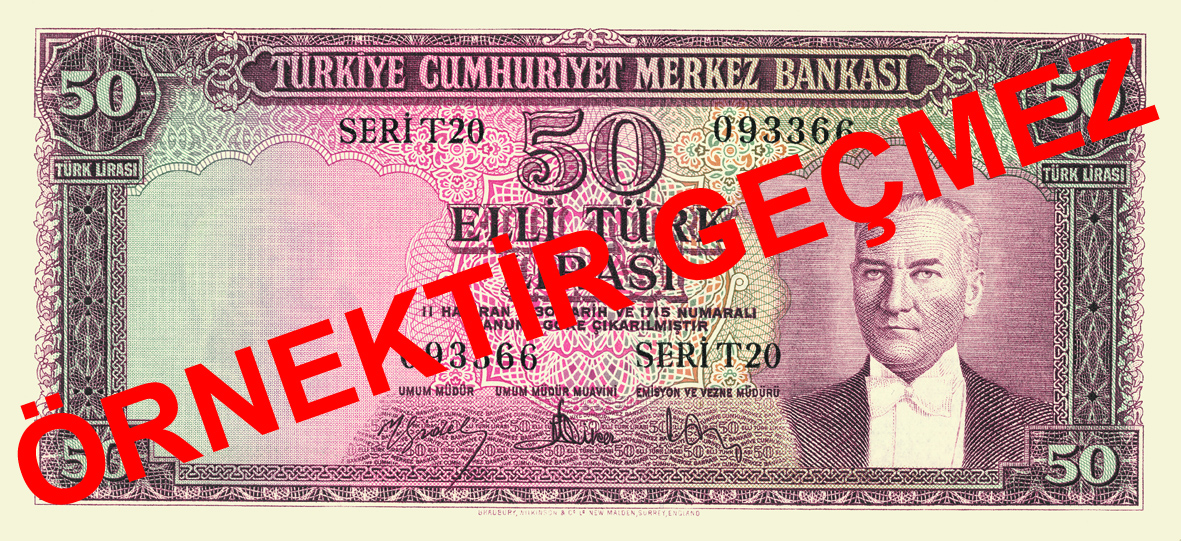
| Issue date | 01.10.1957 |
|---|---|
| Date of withdrawal | 07.05.1979 |
| End of redemption period | 07.05.1989 |
| Signatures | Nail GİDEL, Fikri DİKER, Ekrem SUNGAR |
| Dimensions | 74x160 mm |
| Front design | A portrait of Atatürk |
| Back design | A figure from the Statue of Victory at Ulus Square in Ankara |
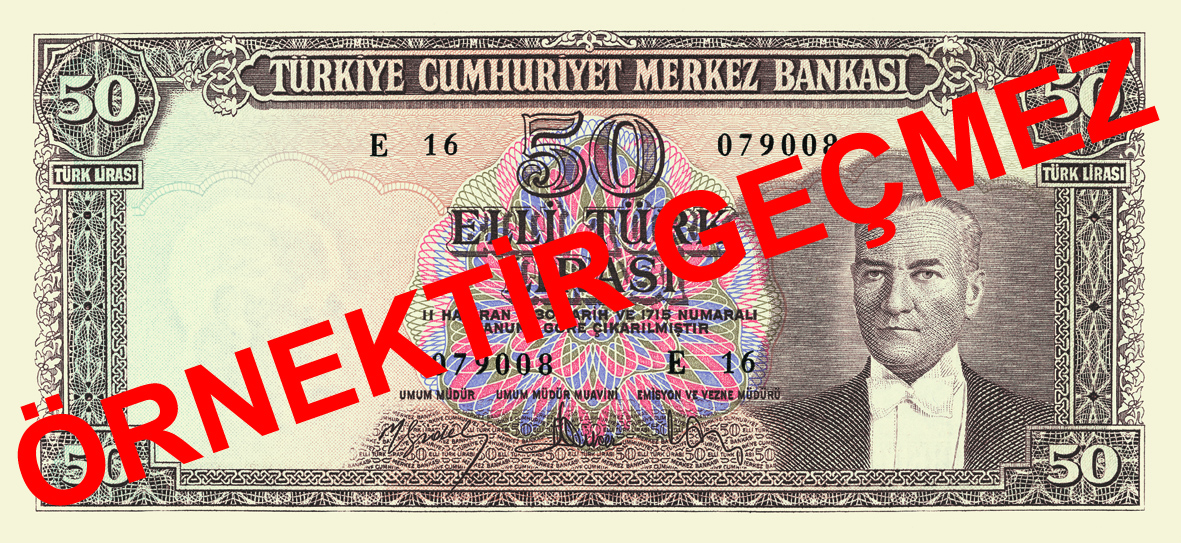
| Issue date | 15.02.1960 |
|---|---|
| Date of withdrawal | 07.05.1979 |
| End of redemption period | 07.05.1989 |
| Signatures | Nail GİDEL, Fikri DİKER, Ekrem SUNGAR |
| Dimensions | 74x160 mm |
| Front design | A portrait of Atatürk |
| Back design | A figure from the Statue of Victory at Ulus Square in Ankara |
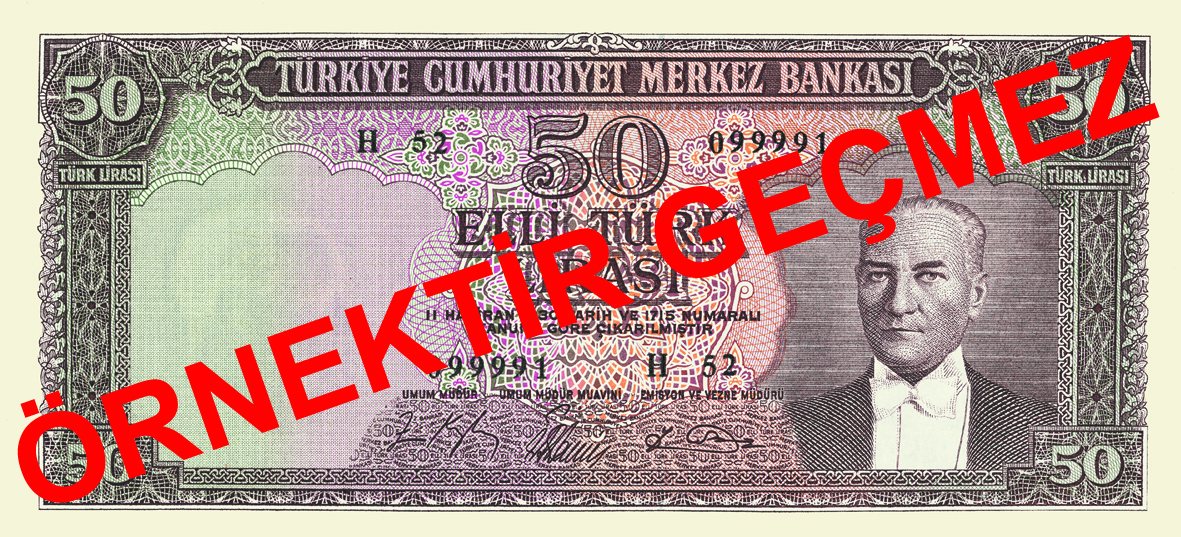
| Issue date | 01.06.1964 |
|---|---|
| Date of withdrawal | 07.05.1979 |
| End of redemption period | 07.05.1989 |
| Signatures | Ziya KAYLA, Emin Ali SERİM, Yahya ARSLANER |
| Dimensions | 74x160 mm |
| Front design | A portrait of Atatürk |
| Back design | A figure from the Statue of Victory at Ulus Square in Ankara |
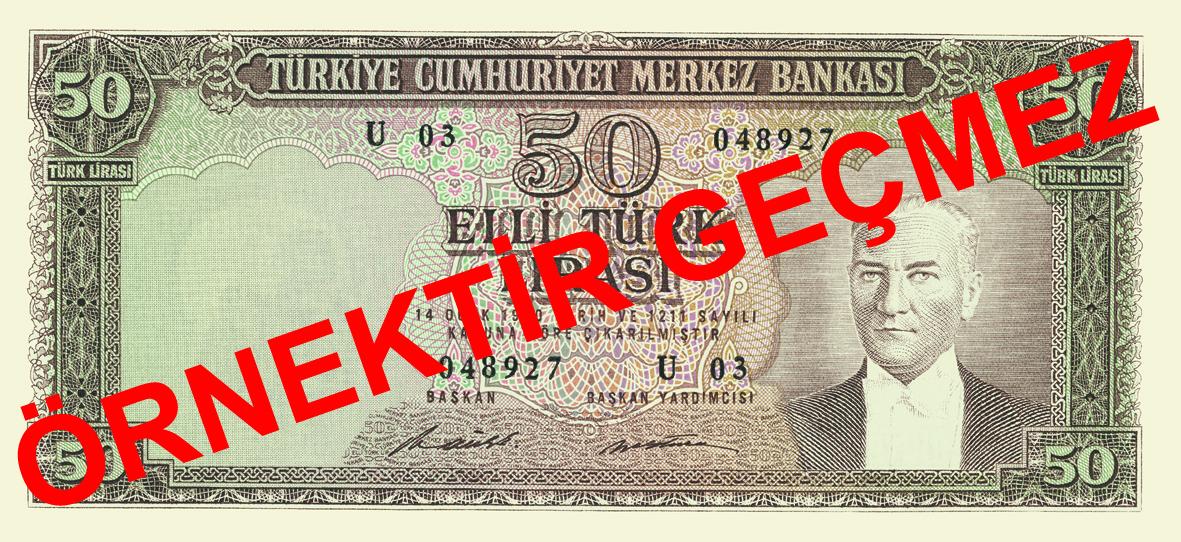
| Issue date | 02.08.1971 |
|---|---|
| Date of withdrawal | 07.05.1979 |
| End of redemption period | 07.05.1989 |
| Signatures | Naim TALU, Nevzat ALPTÜRK |
| Dimensions | 74x160 mm |
| Front design | A portrait of Atatürk |
| Back design | A figure from the Statue of Victory at Ulus Square in Ankara |
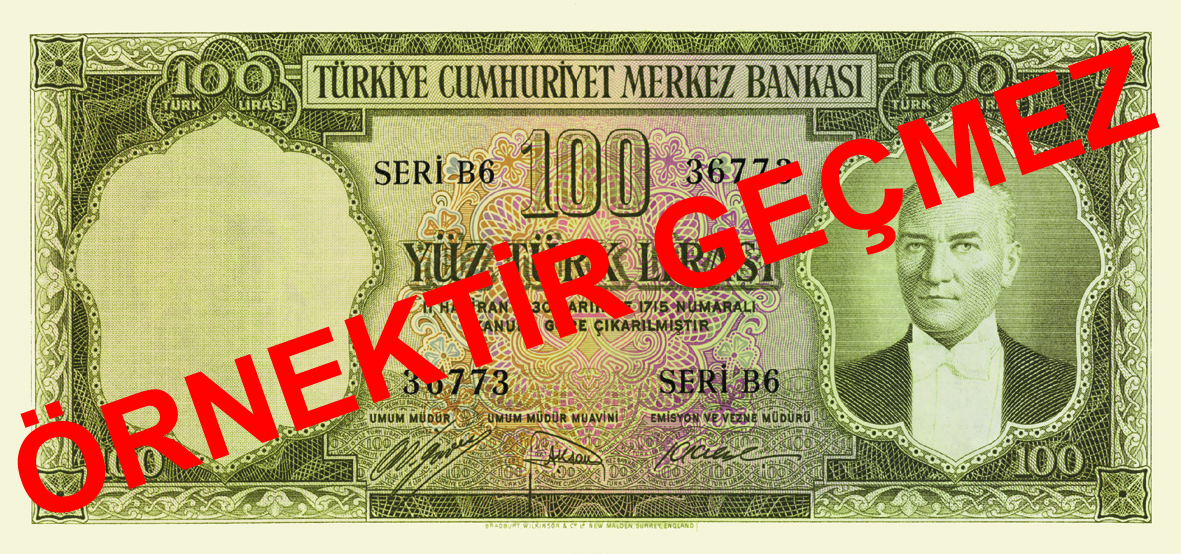
| Issue date | 10.10.1952 |
|---|---|
| Date of withdrawal | 12.04.1976 |
| End of redemption period | 12.04.1986 |
| Signatures | Osman Nuri GÖVER, Reşat AKSAN, Kamil KIBRIZLI |
| Dimensions | 80x170 mm |
| Front design | A portrait of Atatürk |
| Back design | A view from The Youth Park in Ankara |
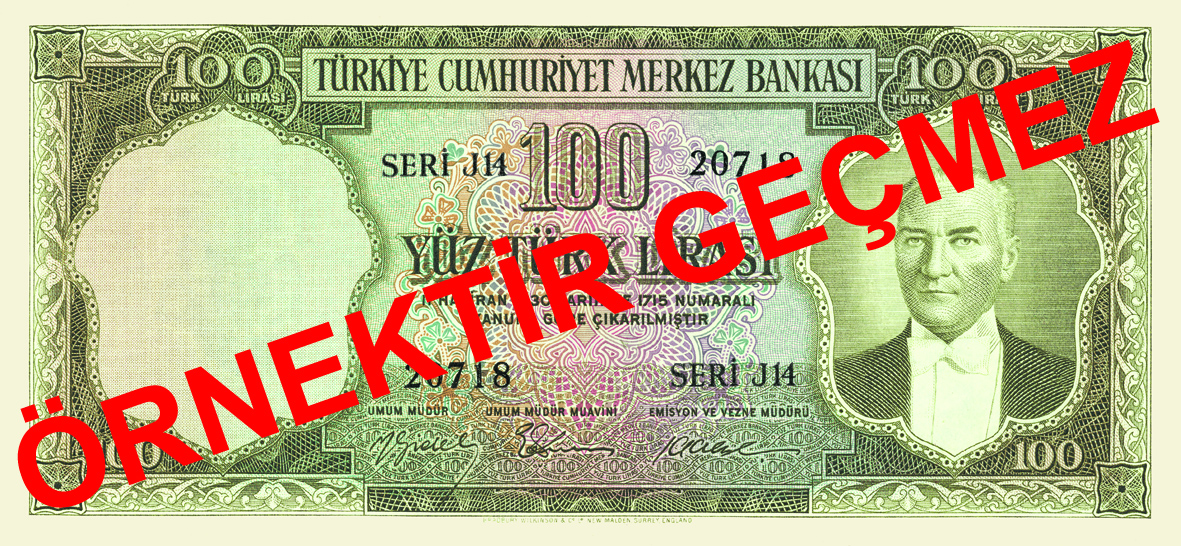
| Issue date | 02.07.1956 |
|---|---|
| Date of withdrawal | 12.04.1976 |
| End of redemption period | 12.04.1986 |
| Signatures | Nail GİDEL, Emir SENCER, Kamil KIBRIZLI |
| Dimensions | 80x170 mm |
| Front design | A portrait of Atatürk |
| Back design | A view from The Youth Park in Ankara |

| Issue date | 04.08.1958 |
|---|---|
| Date of withdrawal | 12.04.1976 |
| End of redemption period | 12.04.1986 |
| Signatures | Nail GİDEL, Emir SENCER, Kamil KIBRIZLI |
| Dimensions | 80x170 mm |
| Front design | A portrait of Atatürk |
| Back design | A view from The Youth Park in Ankara |
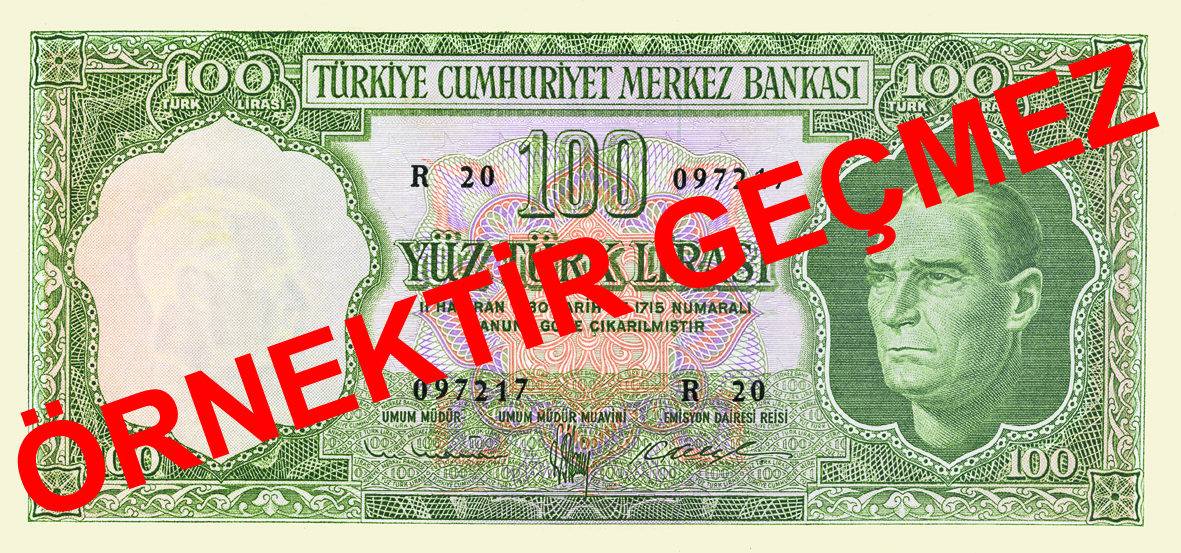
| Issue date | 15.03.1962 |
|---|---|
| Date of withdrawal | 12.04.1976 |
| End of redemption period | 12.04.1986 |
| Signatures | Münir MOSTAR, Emin Ali SERİM, Kamil KIBRIZLI |
| Dimensions | 80x170 mm |
| Front design | A portrait of Atatürk |
| Back design | A view from The Youth Park in Ankara |

| Issue date | 01.10.1964 |
|---|---|
| Date of withdrawal | 12.04.1976 |
| End of redemption period | 12.04.1986 |
| Signatures | Ziya KAYLA, Emin Ali SERİM, Yahya ARSLANER |
| Dimensions | 80x170 mm |
| Front design | A portrait of Atatürk |
| Back design | A view from The Youth Park in Ankara |
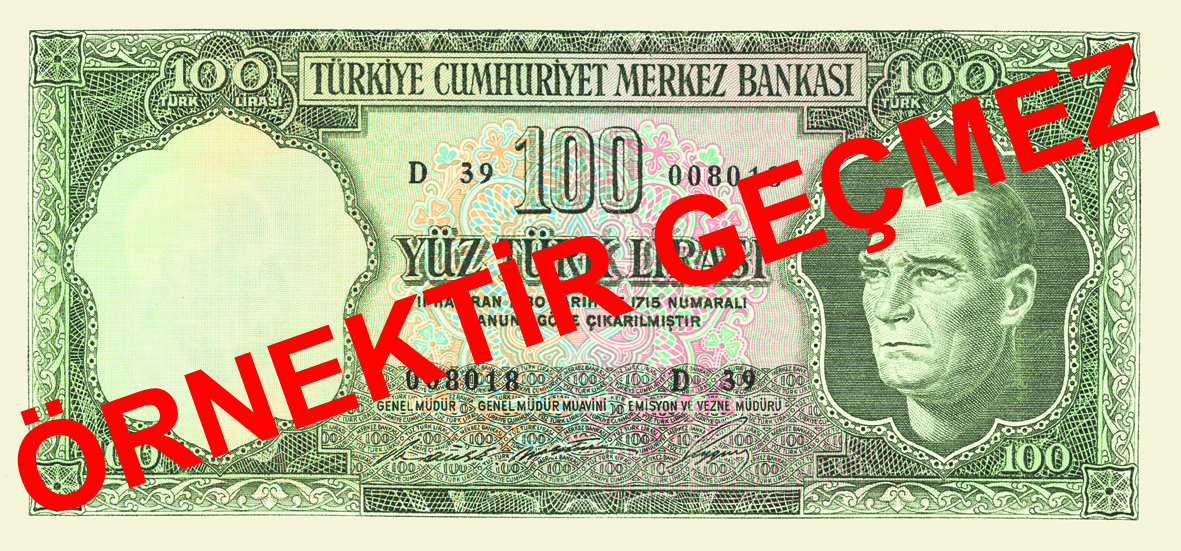
| Issue date | 17.03.1969 |
|---|---|
| Date of withdrawal | 12.04.1976 |
| End of redemption period | 12.04.1986 |
| Signatures | Naim TALU, Nevzat ALPTÜRK, Rıza UYGURER |
| Dimensions | 80x170 mm |
| Front design | A portrait of Atatürk |
| Back design | A view from The Youth Park in Ankara |

| Issue date | 15.04.1953 |
|---|---|
| Date of withdrawal | 01.09.1976 |
| End of redemption period | 01.09.1986 |
| Signatures | Osman Nuri GÖVER, Reşat AKSAN, Kamil KIBRIZLI |
| Dimensions | 80x170 mm |
| Front design | A portrait of Atatürk |
| Back design | The Sultan Ahmet Mosque, the Obelix and the Hippodrome in İstanbul |
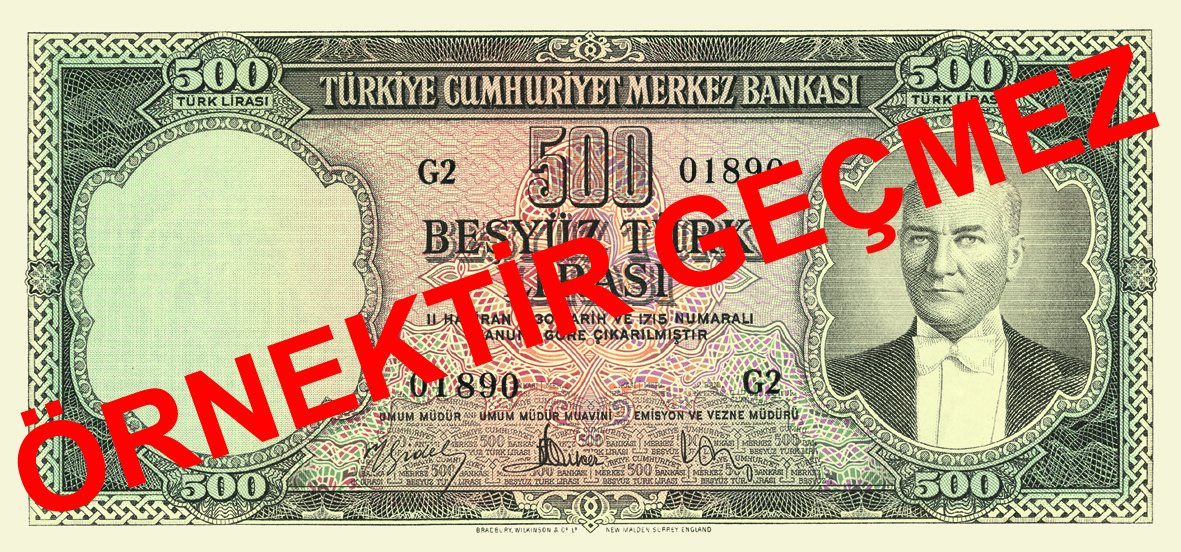
| Issue date | 16.02.1959 |
|---|---|
| Date of withdrawal | 01.09.1976 |
| End of redemption period | 01.09.1986 |
| Signatures | Nail GİDEL, Fikri DİKER, Ekrem SUNGAR |
| Dimensions | 80x170 mm |
| Front design | A portrait of Atatürk |
| Back design | The Sultan Ahmet Mosque, the Obelix and the Hippodrome in İstanbul |
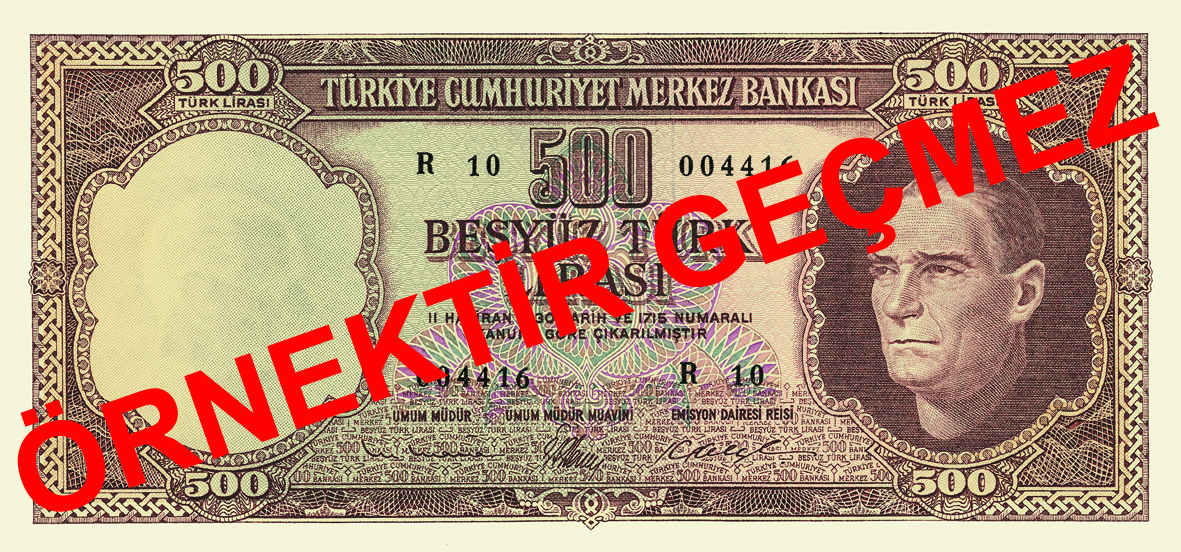
| Issue date | 01.12.1962 |
|---|---|
| Date of withdrawal | 01.09.1976 |
| End of redemption period | 01.09.1986 |
| Signatures | Nail GİDEL, Fikri DİKER, Ekrem SUNGAR |
| Dimensions | 80x170 mm |
| Front design | A portrait of Atatürk |
| Back design | The Sultan Ahmet Mosque, the Obelix and the Hippodrome in İstanbul |

| Issue date | 03.06.1968 |
|---|---|
| Date of withdrawal | 01.09.1976 |
| End of redemption period | 01.09.1986 |
| Signatures | Naim TALU, Nevzat ALPTÜRK, Rıza UYGURER |
| Dimensions | 80x170 mm |
| Front design | A portrait of Atatürk |
| Back design | The Sultan Ahmet Mosque, the Obelix and the Hippodrome in İstanbul |
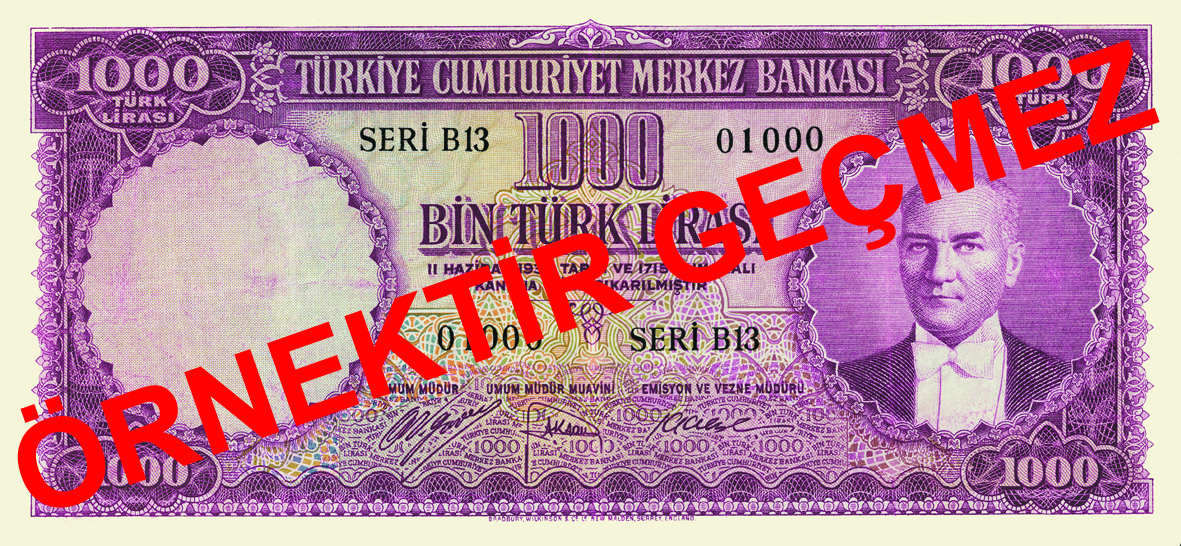
| Issue date | 15.04.1953 |
|---|---|
| Date of withdrawal | 07.05.1979 |
| End of redemption period | 07.05.1989 |
| Signatures | Osman Nuri GÖVER, Reşat AKSAN, Kamil KIBRIZLI |
| Dimensions | 80x170 mm |
| Front design | A portrait of Atatürk |
| Back design | A view of Bosphorous from the Fortress of Rumeli in İstanbul |
The Series 5 Banknotes, which were printed in seven denominations in 2, 50, 5, 10, 50, 100, 500 and 1,000 Turkish liras and in 32 versions, remained in circulation between 1951 and 1971[NK1] . The efforts to establish a banknote printing plant started in the late 1930s but were interrupted because of World War II and the issue of establishing a banknote printing plant affiliated to the CBRT could not be addressed until the early 1950s. In 1951, efforts started again, and the Banknote Printing Plant was finished and started producing banknotes in 1958. The first banknotes printed in Türkiye were the 100 Turkish lira banknotes of E5 series in version III. The other banknotes within this series were printed in the USA, the UK and Germany before the establishment of the Banknote Printing Plant. The famous 1,000 Turkish lira banknotes, which were not very common in circulation because of the high value and referred to as “The Purple Thousand”, were in the E5 series.
The banknotes issued after the foundation of the new Turkish Republic featured symbols and achievements of the new State. Starting with the E3 series, Turkish banknotes featured historical places, state buildings and important Turkish historical characters. The last denomination of E3 series, the 1,000 Turkish lira banknotes featured the Bosphorus Bridge (renamed as 15 July Martyrs’ Bridge in 2016) that was built between 1970 and 1973 and opened on the 50th anniversary of the Republic. The Bridge, which unites Asia and Europe, was the 4th longest suspension bridge in the world at the time it was finished.
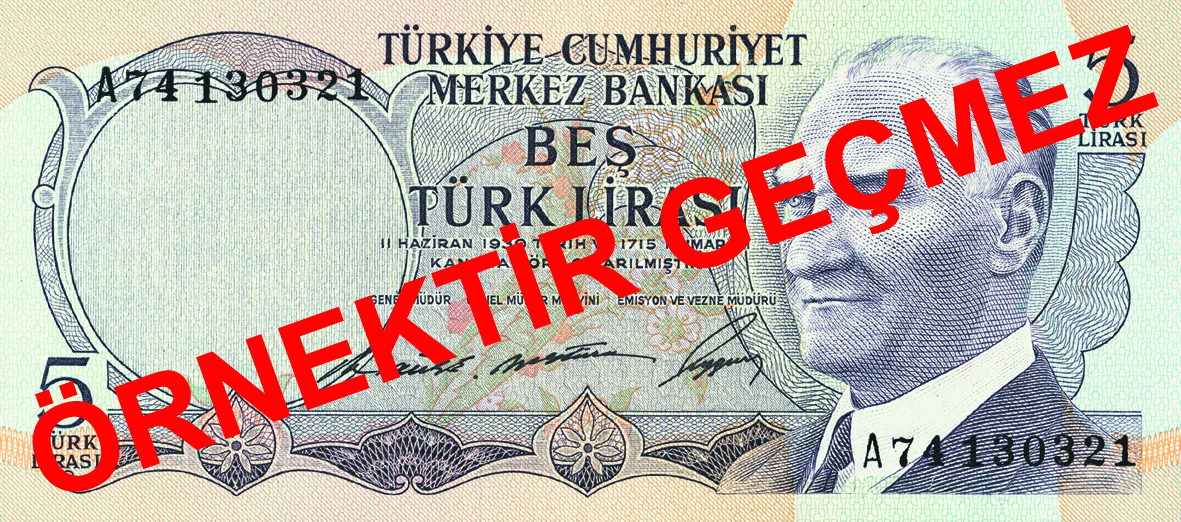
| Issue date | 08.01.1968 |
|---|---|
| Date of withdrawal | 16.05.1983 |
| End of redemption period | 16.05.1993 |
| Signatures | Naim TALU, Nevzat ALPTÜRK, Rıza UYGURER |
| Dimensions | 68x150 mm |
| Front design | A portrait of Atatürk |
| Back design | Manavgat Waterfall in Antalya |

| Issue date | 20.09.1976 |
|---|---|
| Date of withdrawal | 16.05.1983 |
| End of redemption period | 16.05.1993 |
| Signatures | Dr. Tayyar SADIKLAR, Naci TİBET |
| Dimensions | 68x150 mm |
| Front design | A portrait of Atatürk |
| Back design | Manavgat Waterfall in Antalya |
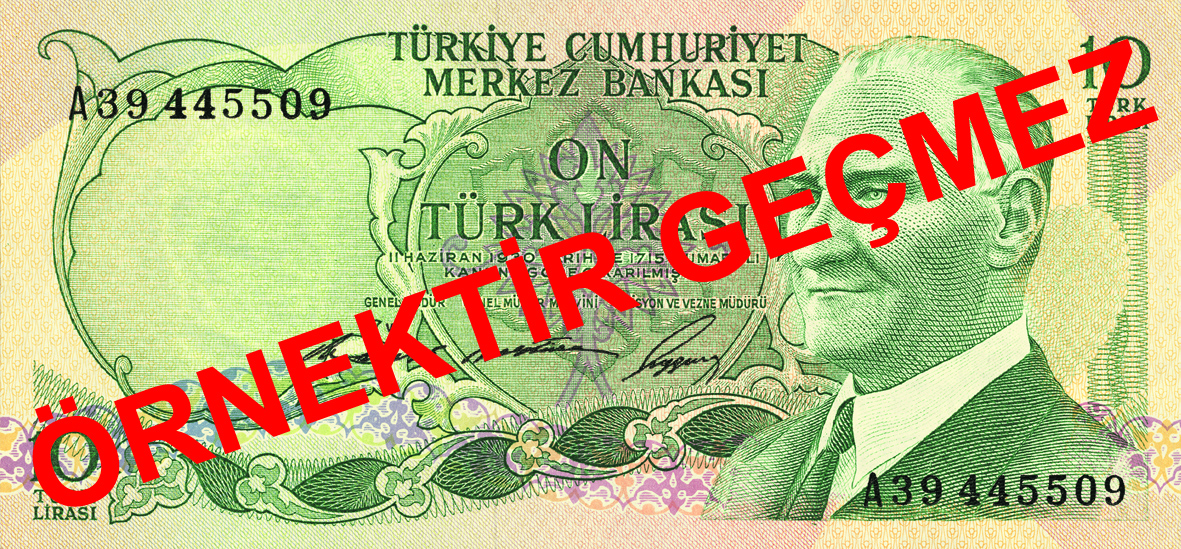
| Issue date | 04.07.1966 |
|---|---|
| Date of withdrawal | 21.09.1981 |
| End of redemption period | 21.09.1991 |
| Signatures | Naim TALU, Nevzat ALPTÜRK, Rıza UYGURER |
| Dimensions | 65x140 mm |
| Front design | A portrait of Atatürk |
| Back design | The Maiden's Tower on Bosphorus in İstanbul |
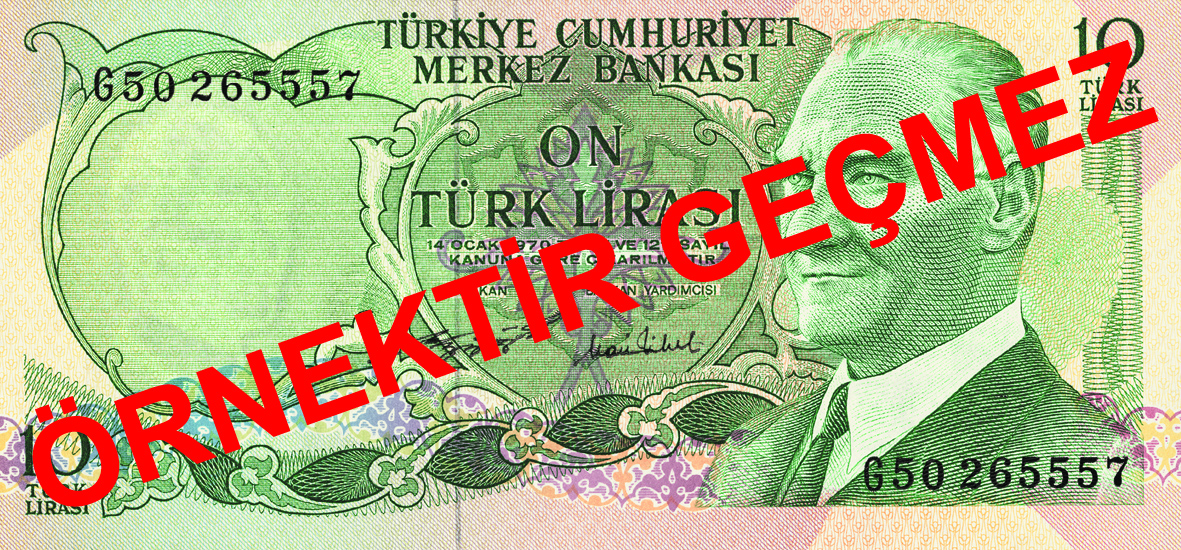
| Issue date | 07.04.1975 |
|---|---|
| Date of withdrawal | 21.09.1981 |
| End of redemption period | 21.09.1991 |
| Signatures | Memduh GÜPGÜPOĞLU, Naci TİBET |
| Dimensions | 65x140 mm |
| Front design | A portrait of Atatürk |
| Back design | The Maiden's Tower on Bosphorus in İstanbul |

| Issue date | 15.06.1966 |
|---|---|
| Date of withdrawal | 21.08.1987 |
| End of redemption period | 21.08.1997 |
| Signatures | Ziya KAYLA, Emin Ali SERİM, Yahya ARSLANER |
| Dimensions | 66x143 mm |
| Front design | A portrait of Atatürk |
| Back design | The Mausoleum of Atatürk in Ankara |
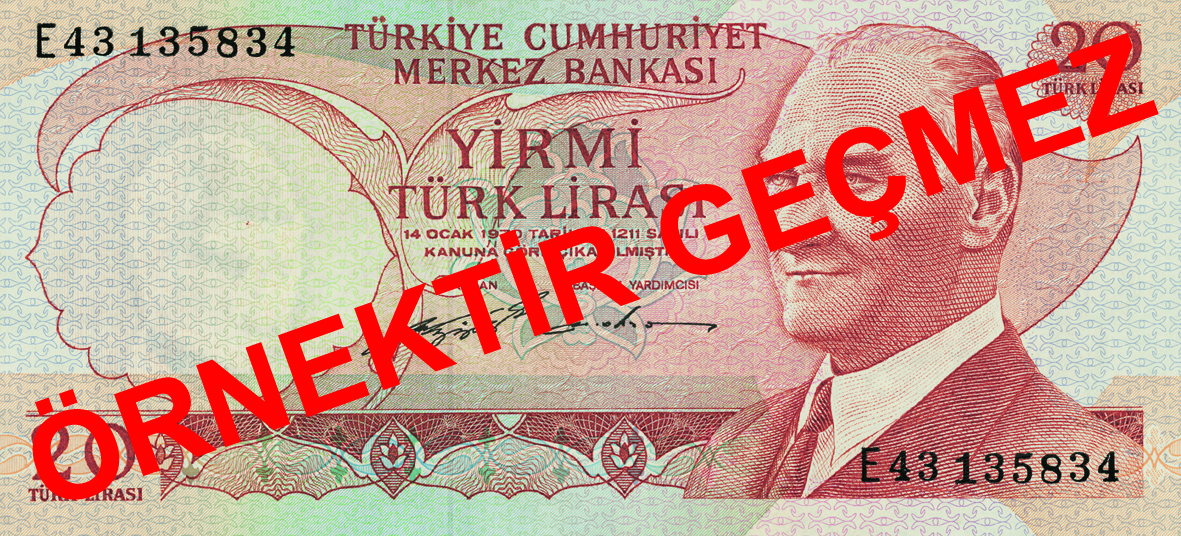
| Issue date | 24.06.1974 |
|---|---|
| Date of withdrawal | 21.08.1987 |
| End of redemption period | 21.08.1997 |
| Signatures | Memduh GÜPGÜPOĞLU, Numan AKSOY |
| Dimensions | 66x143 mm |
| Front design | A portrait of Atatürk |
| Back design | The Mausoleum of Atatürk in Ankara |
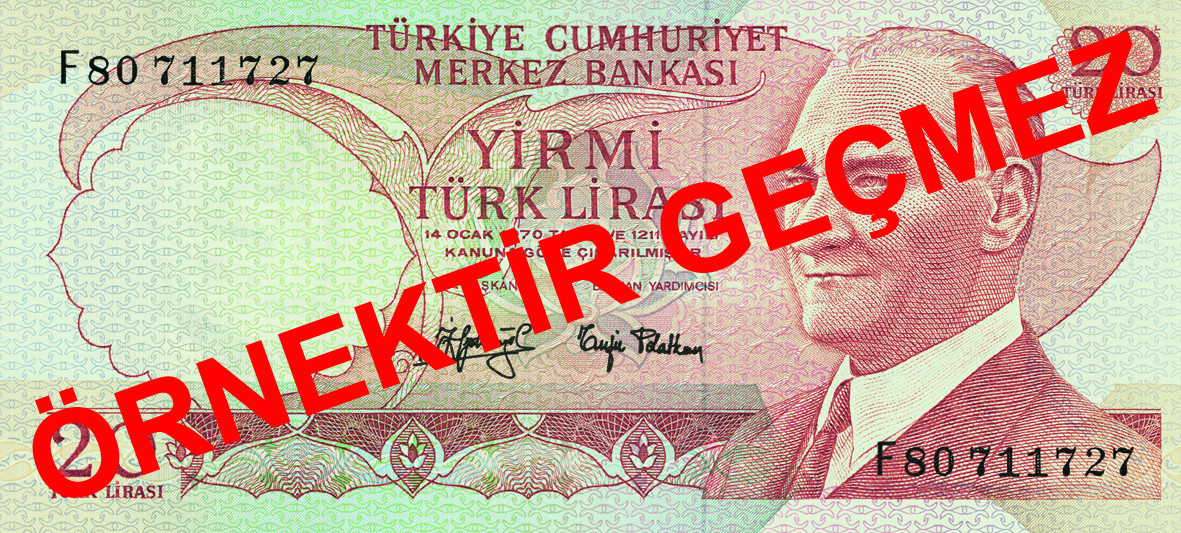
| Issue date | 29.08.1979 |
|---|---|
| Date of withdrawal | 21.08.1987 |
| End of redemption period | 21.08.1997 |
| Signatures | İ. Hakkı AYDINOĞLU, Tanju POLATKAN |
| Dimensions | 66x143 mm |
| Front design | A portrait of Atatürk |
| Back design | The Mausoleum of Atatürk in Ankara |
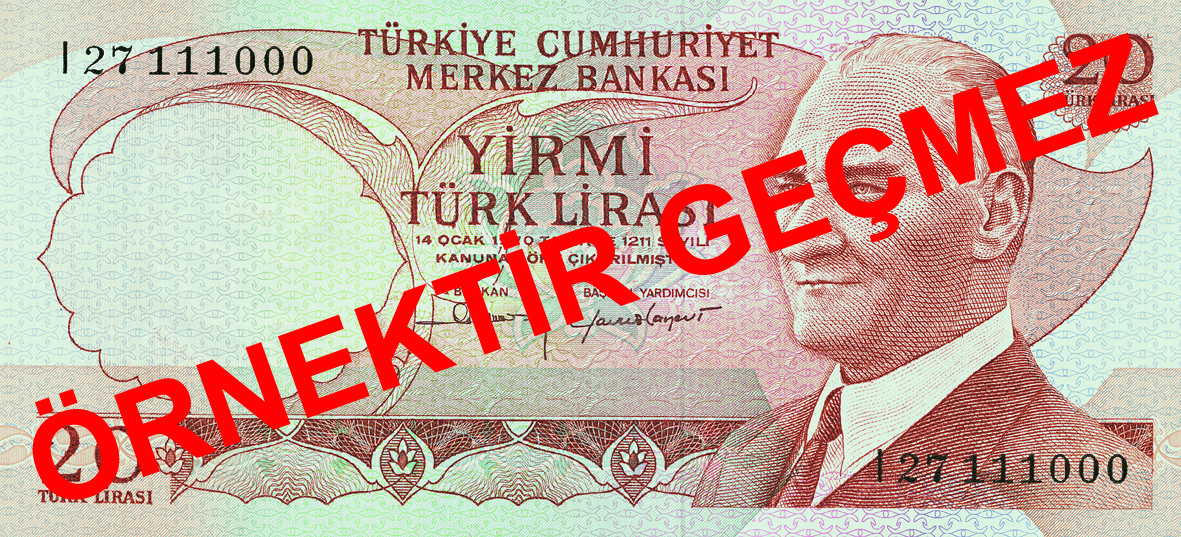
| Issue date | 30.05.1983 |
|---|---|
| Date of withdrawal | 21.08.1987 |
| End of redemption period | 21.08.1997 |
| Signatures | Osman ŞIKLAR, Yavuz CANEVİ |
| Dimensions | 66x143 mm |
| Front design | A portrait of Atatürk |
| Back design | The Mausoleum of Atatürk in Ankara |

| Issue date | 09.04.1976 |
|---|---|
| Date of withdrawal | 21.08.1987 |
| End of redemption period | 21.08.1997 |
| Signatures | Numan AKSOY, Yahya ARSLANER |
| Dimensions | 71x160 mm |
| Front design | A portrait of Atatürk |
| Back design | The Marble Fountain in Topkapı Palace in İstanbul |
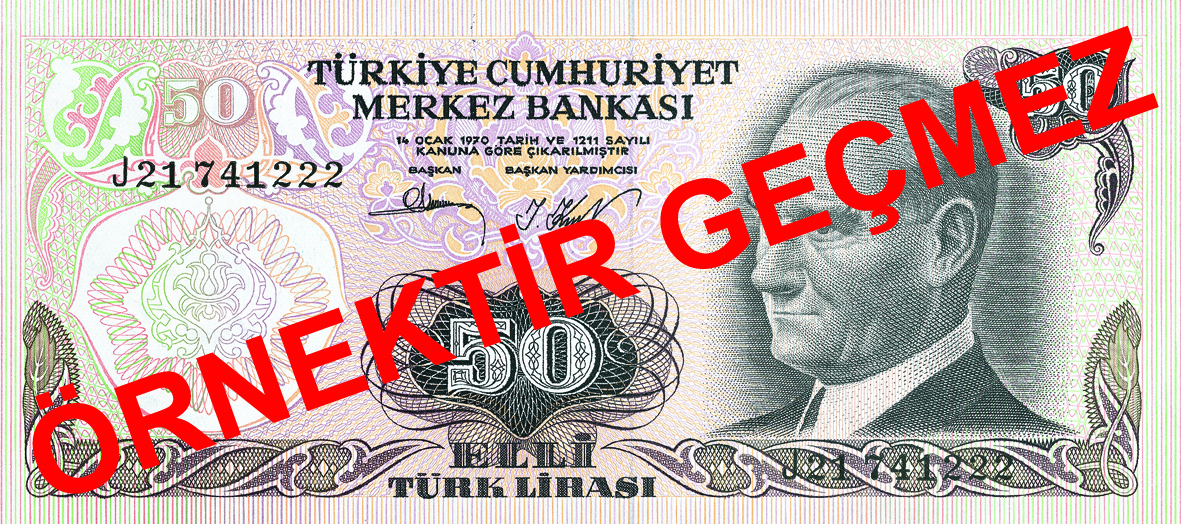
| Issue date | 04.04.1983 |
|---|---|
| Date of withdrawal | 21.08.1987 |
| End of redemption period | 21.08.1997 |
| Signatures | Osman ŞIKLAR, İbrahim KURT |
| Dimensions | 71x160 mm |
| Front design | A portrait of Atatürk |
| Back design | The Marble Fountain in Topkapı Palace in İstanbul |
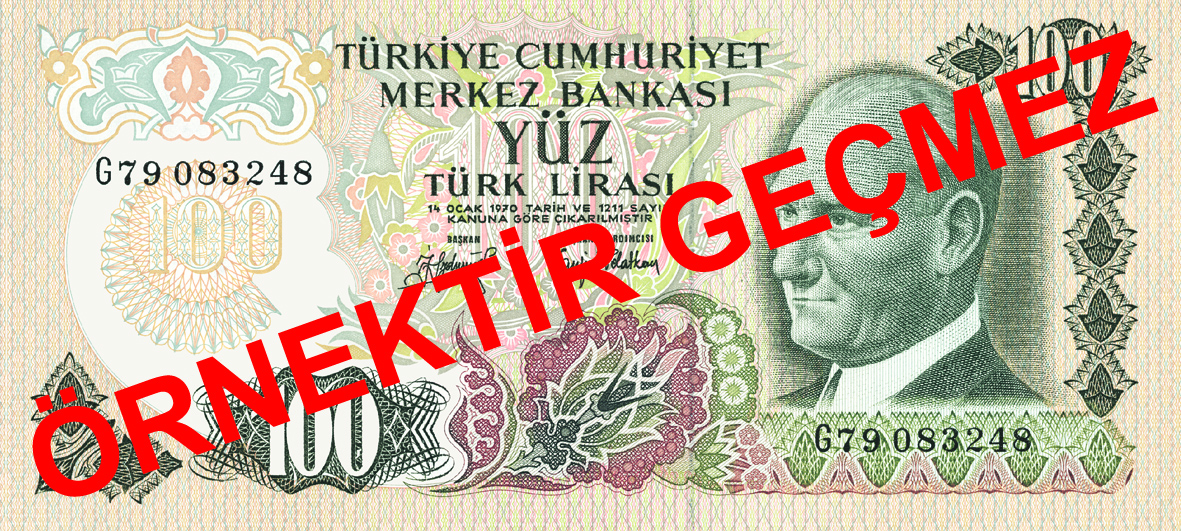
| Issue date | 24.09.1979 |
|---|---|
| Date of withdrawal | 05.05.1986 |
| End of redemption period | 05.05.1996 |
| Signatures | İ. Hakkı AYDINOĞLU, Tanju POLATKAN |
| Dimensions | 77x170 mm |
| Front design | A portrait of Atatürk |
| Back design | The Mount Ararat in Ağrı |
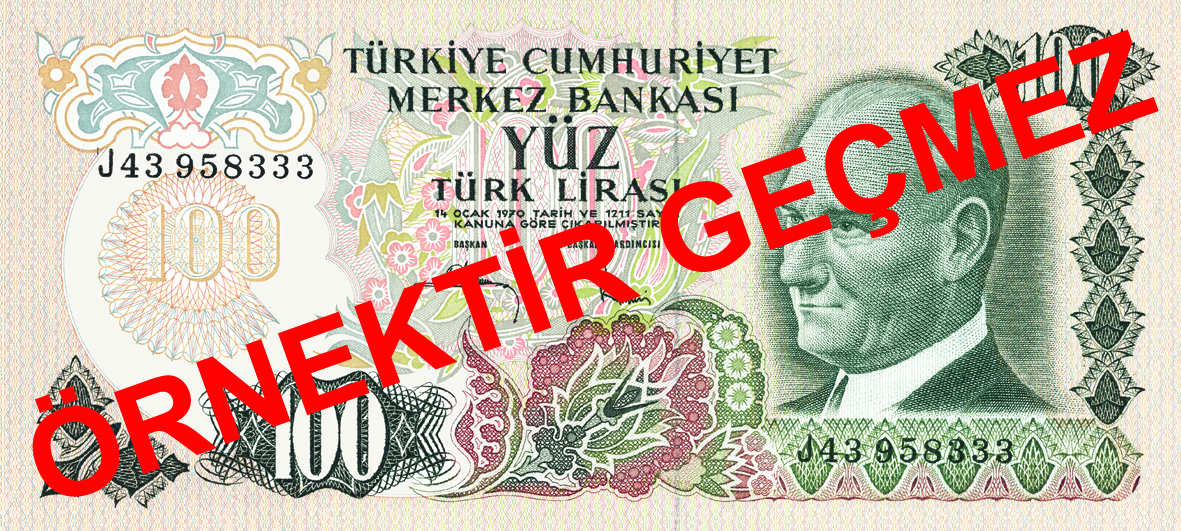
| Issue date | 20.06.1983 |
|---|---|
| Date of withdrawal | 05.05.1986 |
| End of redemption period | 05.05.1996 |
| Signatures | Osman ŞIKLAR, Ruhi HASESKİ |
| Dimensions | 77x170 mm |
| Front design | A portrait of Atatürk |
| Back design | The Mount Ararat in Ağri |
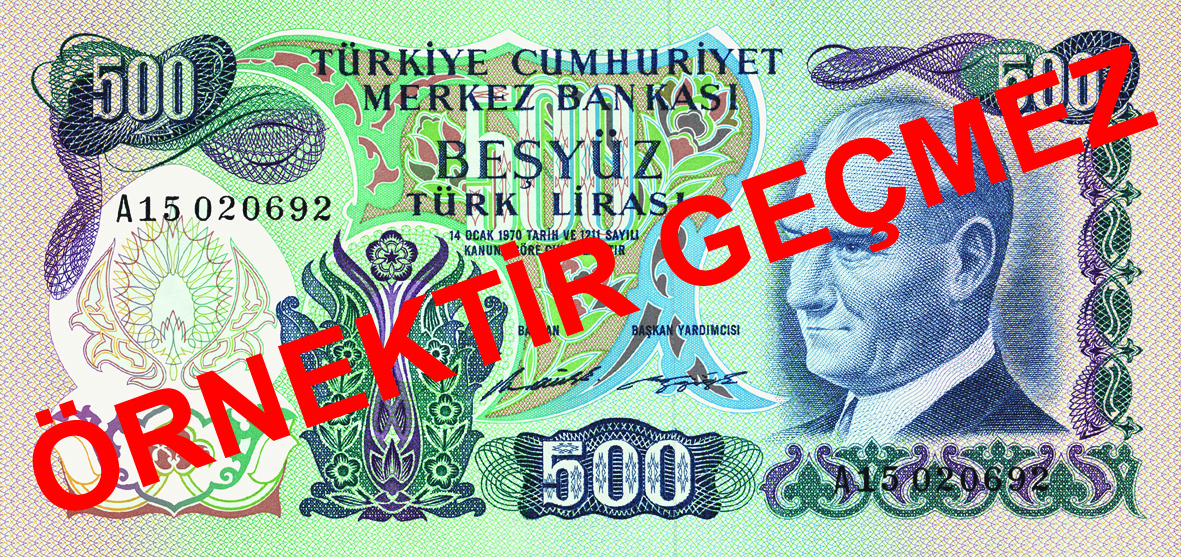
| Issue date | 01.09.1971 |
|---|---|
| Date of withdrawal | 15.06.1984 |
| End of redemption period | 15.06.1994 |
| Signatures | Naim TALU, Memduh GÜPGÜPOĞLU |
| Dimensions | 80x170 mm |
| Front design | A portrait of Atatürk |
| Back design | The Main Gate of İstanbul University |
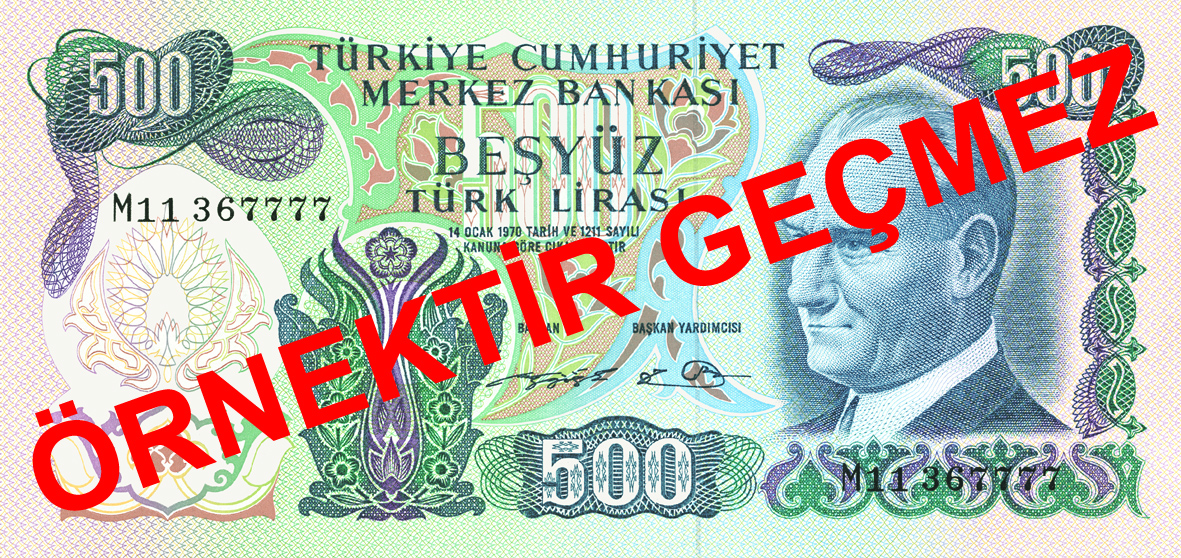
| Issue date | 09.09.1974 |
|---|---|
| Date of withdrawal | 15.06.1984 |
| End of redemption period | 15.06.1994 |
| Signatures | Memduh GÜPGÜPOĞLU, Yahya ARSLANER |
| Dimensions | 80x170 mm |
| Front design | A portrait of Atatürk |
| Back design | The Main Gate of İstanbul University |
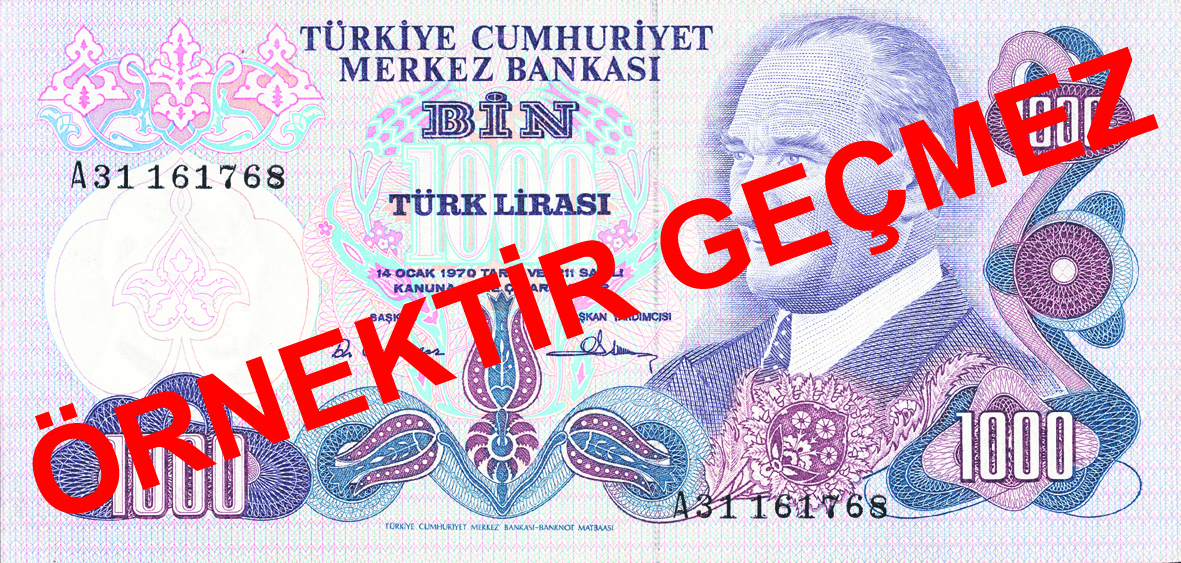
| Issue date | 29.05.1978 |
|---|---|
| Date of withdrawal | 29.09.1986 |
| End of redemption period | 29.09.1996 |
| Signatures | Dr. Tayyar SADIKLAR, Osman ŞIKLAR |
| Dimensions | 82x170 mm |
| Front design | A portrait of Atatürk |
| Back design | A view from Bosphorus |
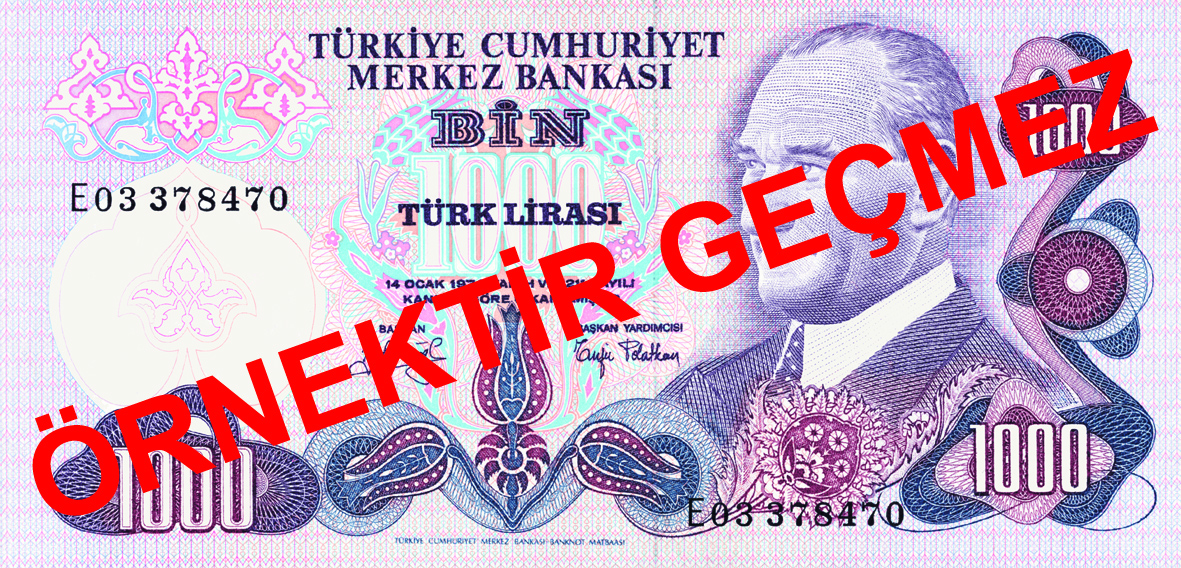
| Issue date | 17.12.1979 |
|---|---|
| Date of withdrawal | 29.09.1986 |
| End of redemption period | 29.09.1996 |
| Signatures | İ. Hakkı AYDINOĞLU, Tanju POLATKAN |
| Dimensions | 82x170 mm |
| Front design | A portrait of Atatürk |
| Back design | A view from Bosphorus |
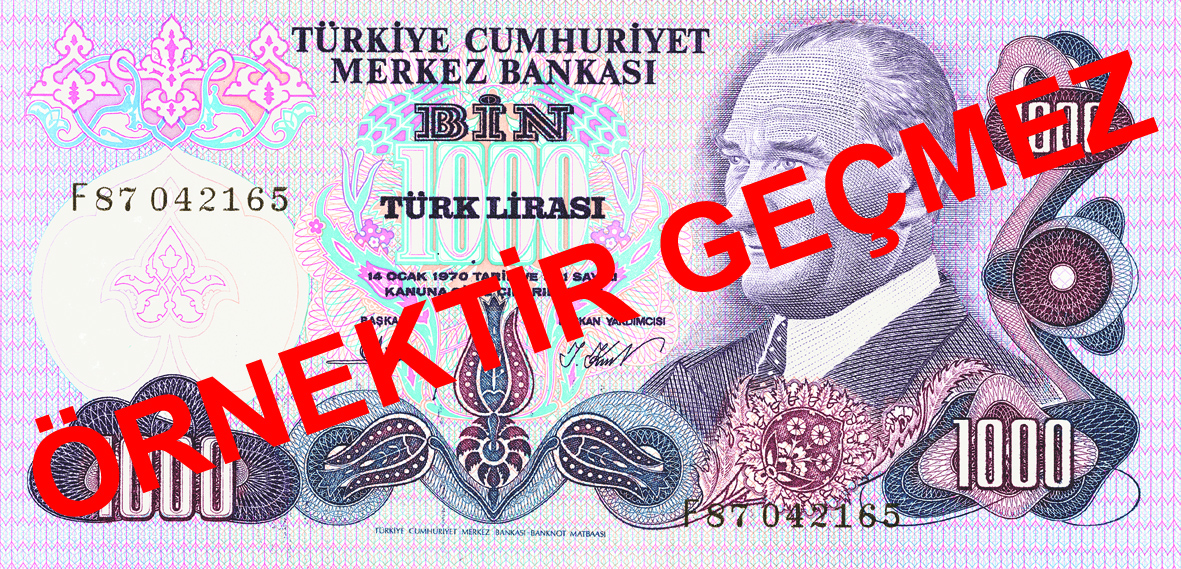
| Issue date | 10.06.1981 |
|---|---|
| Date of withdrawal | 29.09.1986 |
| End of redemption period | 29.09.1996 |
| Signatures | Osman ŞIKLAR, İbrahim KURT |
| Dimensions | 82x170 mm |
| Front design | A portrait of Atatürk |
| Back design | A view from Bosphorus |

All of the E7 series banknotes were printed in Türkiye. Banknotes in this series started to be put into circulation in 1979.
The E7 series banknotes were printed in 15 denominations of 10, 100, 500, 1,000, 5,000, 10,000, 20,000, 50,000, 100,000, 250,000, 500,000, 1,000,000, 5,000,000, 10,000,000 and 20,000,000 Turkish liras and in 36 versions.
On the reverse sides of the banknotes in E7 series, there are portraits of Turkish historical characters such as Fatih the Conqueror, Sinan the Architect, Rumî and Mehmet Akif Ersoy, the poet of the Turkish national anthem. The banknotes also feature historically important monuments and buildings such as the Monumental Tomb of Atatürk and the Çanakkale Martyrs’ Memorial.
The E7 series banknotes also featured important projects that were completed in the Republican Era. For instance, the 5,000 Turkish lira banknote had a picture of Afşin-Elbistan Thermal Power Plant; the 1,000,000 Turkish lira banknote had the Ataturk Dam in Şanlıurfa; and 20,000 had a picture of the Central Bank’s Head Office building on the reverse sides.
The 20,000,000 Turkish lira banknote in E7 series was the highest denomination Turkish banknote ever printed.
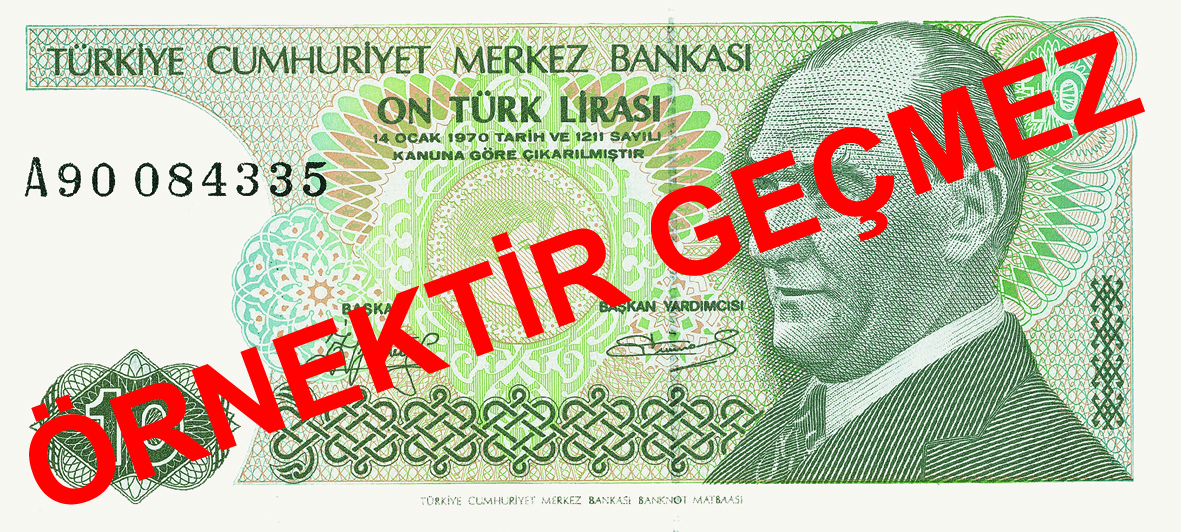
| Issue date | 25.12.1979 |
|---|---|
| Date of withdrawal | 21.08.1987 |
| End of redemption period | 21.08.1997 |
| Signatures | İ. Hakki AYDINOĞLU, Vural GÜNAL |
| Dimensions | 55x122 mm |
| Front design | A portrait of Atatürk |
| Back design | A group of young students giving flowers to Atatürk |
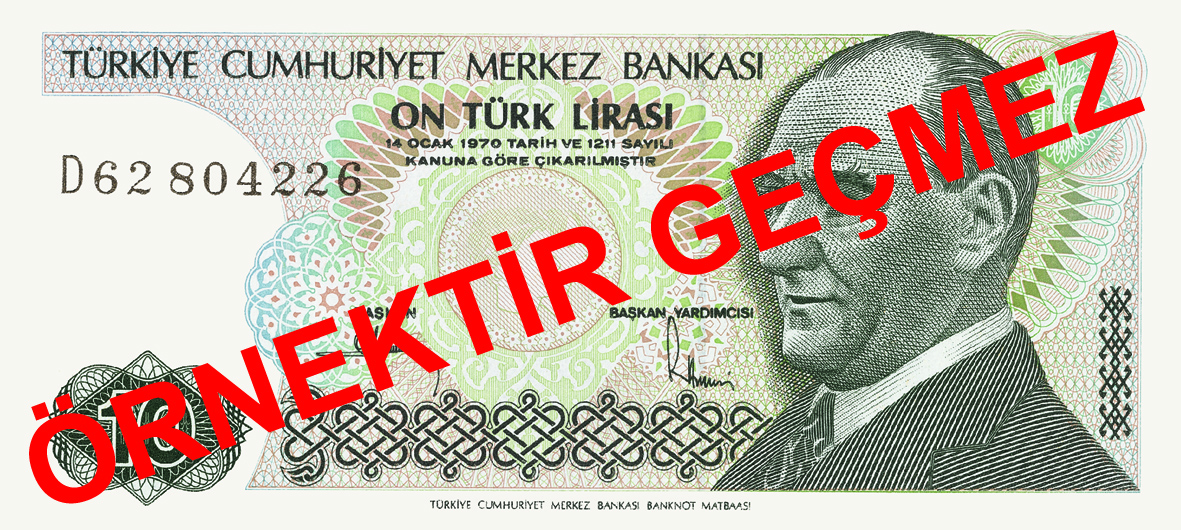
| Issue date | 15.11.1982 |
|---|---|
| Date of withdrawal | 21.08.1987 |
| End of redemption period | 21.08.1997 |
| Signatures | İ. Hakki AYDINOĞLU, Vural GÜNAL |
| Dimensions | 55x122 mm |
| Front design | A portrait of Atatürk |
| Back design | A group of young students giving flowers to Atatürk |
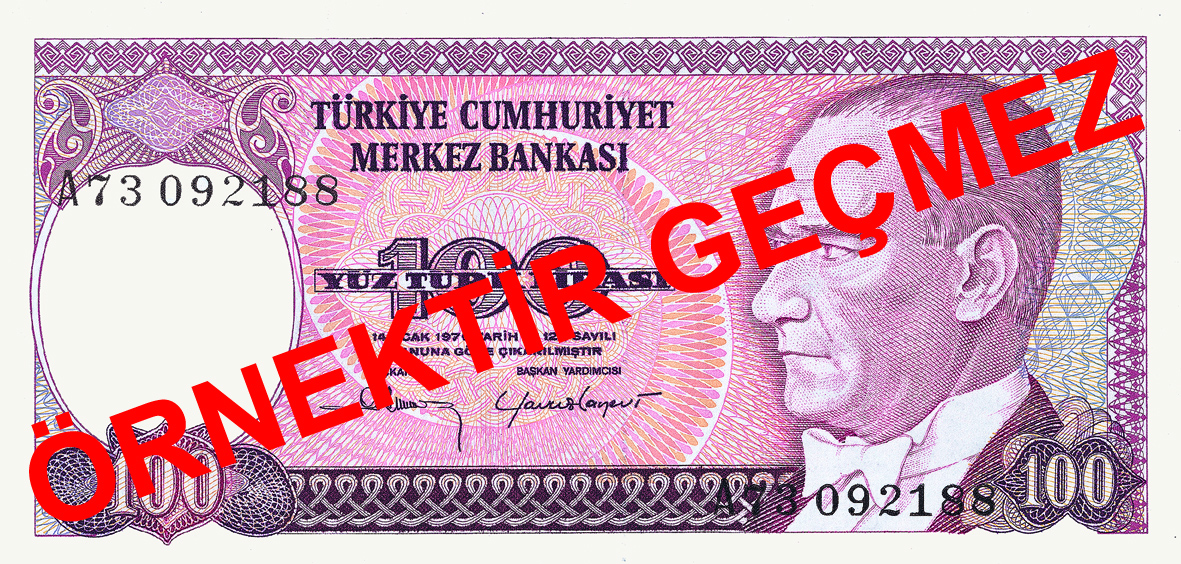
| Issue date | 26.12.1983 |
|---|---|
| Date of withdrawal | 21.08.1989 |
| End of redemption period | 21.08.1999 |
| Signatures | Osman ŞIKLAR, Yavuz CANEVİ |
| Dimensions | 63x131 mm |
| Front design | A portrait of Atatürk |
| Back design | Fort of Ankara, a portrait of Mehmet Akif Ersoy, and his home in Ankara (now museum) the first two quatrains of Turkish National Anthem |
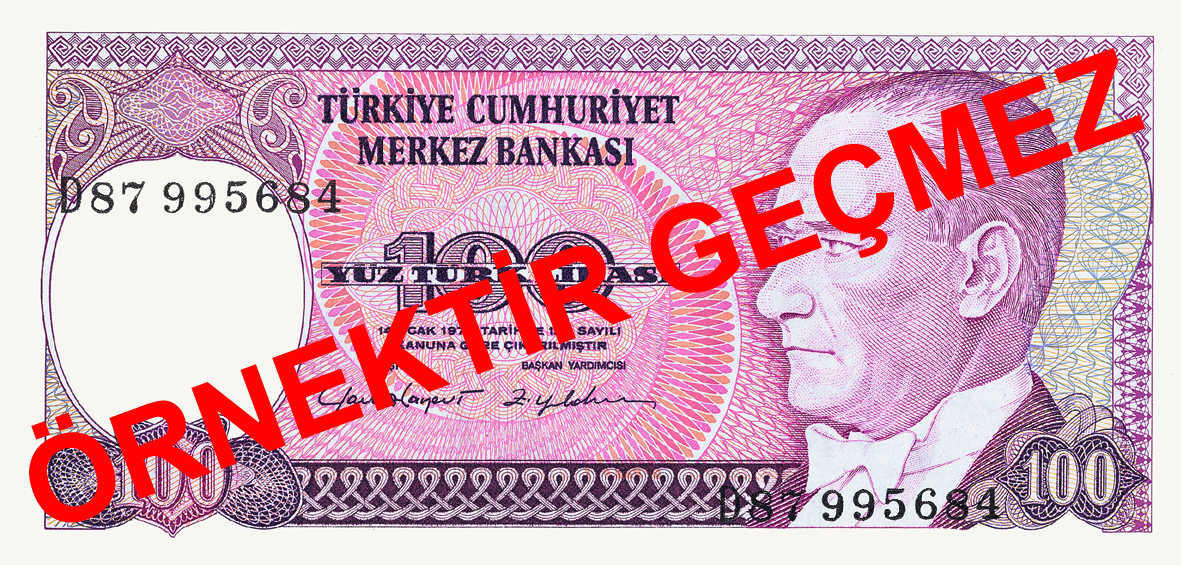
| Issue date | 17.09.1984 |
|---|---|
| Date of withdrawal | 21.08.1989 |
| End of redemption period | 21.08.1999 |
| Signatures | Yavuz CANEVİ, Zekeriya YILDIRIM |
| Dimensions | 63x131 mm |
| Front design | A portrait of Atatürk |
| Back design | Fort of Ankara, a portrait of Mehmet Akif Ersoy, and his home in Ankara (now museum) the first two quatrains of Turkish National Anthem |
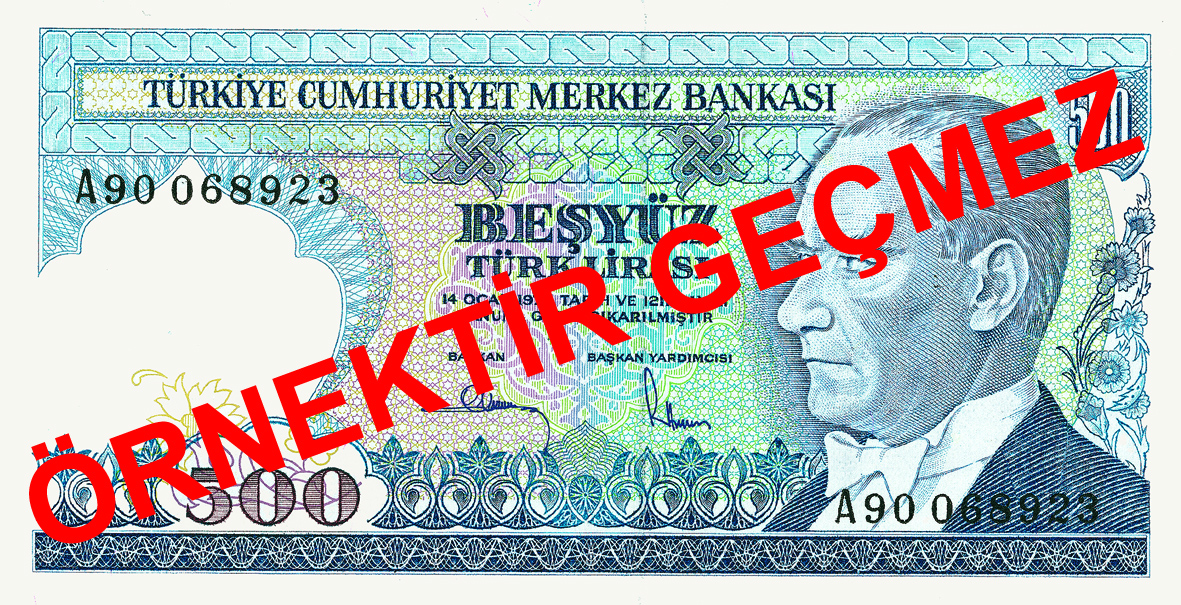
| Issue date | 01.07.1983 |
|---|---|
| Date of withdrawal | 21.08.1989 |
| End of redemption period | 21.08.1999 |
| Signatures | Osman ŞIKLAR, Ruhi HASESKİ |
| Dimensions | 72x140 mm |
| Front design | A portrait of Atatürk |
| Back design | The Clock Tower in Izmir |
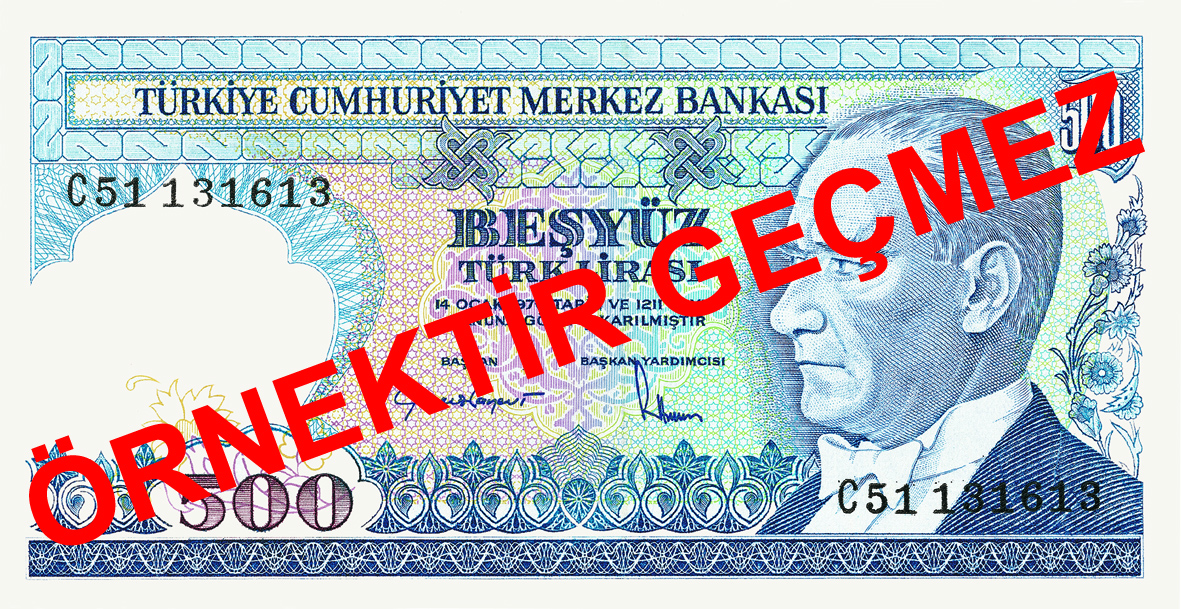
| Issue date | 21.05.1984 |
|---|---|
| Date of withdrawal | 21.08.1989 |
| End of redemption period | 21.08.1999 |
| Signatures | Yavuz CANEVİ, Ruhi HASESKİ |
| Dimensions | 72x140 mm |
| Front design | A portrait of Atatürk |
| Back design | The Clock Tower in Izmir |

| Issue date | 31.03.1986 |
|---|---|
| Date of withdrawal | 03.08.1992 |
| End of redemption period | 03.08.2002 |
| Signatures | Yavuz CANEVİ, İbrahim KURT |
| Dimensions | 72x140 mm |
| Front design | A portrait of Atatürk |
| Back design | A portrait of Fatih Sultan Mehmet ( The Conqueror ) and a view from Istanbul |
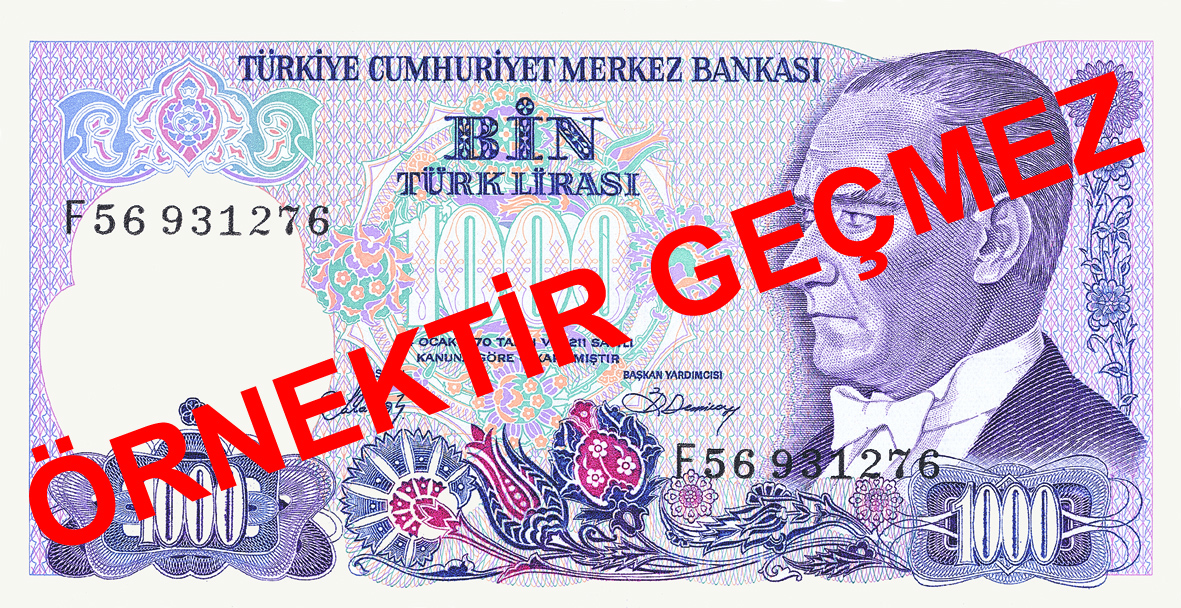
| Issue date | 19.02.1988 |
|---|---|
| Date of withdrawal | 03.08.1992 |
| End of redemption period | 03.08.2002 |
| Signatures | Dr. Rüşdü SARACOGLU, Bediz DEMİRAY |
| Dimensions | 72x140 mm |
| Front design | A portrait of Atatürk |
| Back design | A portrait of Fatih Sultan Mehmet ( The Conqueror ) and a view from Istanbul |
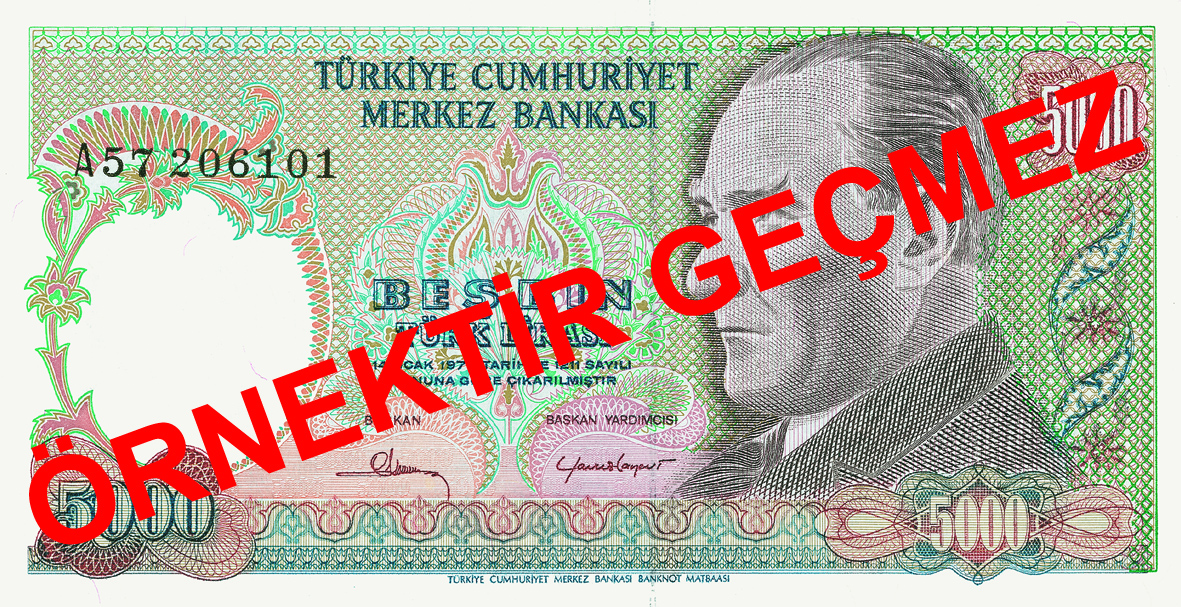
| Issue date | 02.11.1981 |
|---|---|
| Date of withdrawal | 31.01.1994 |
| End of redemption period | 31.01.2004 |
| Signatures | Osman ŞIKLAR, Yavuz CANEVİ |
| Dimensions | 72x140 mm |
| Front design | A portrait of Atatürk |
| Back design | Mevlana Museum in Konya and a figure of Mevlana |
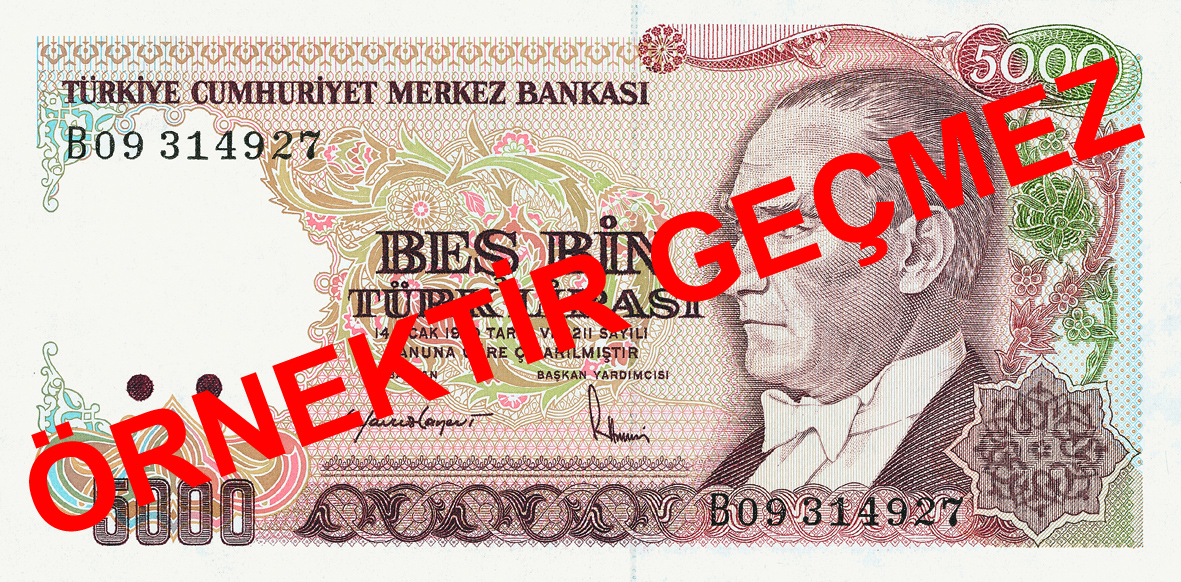
| Issue date | 29.07.1985 |
|---|---|
| Date of withdrawal | 31.01.1994 |
| End of redemption period | 31.01.2004 |
| Signatures | Yavuz CANEVİ, Ruhi HASESKİ |
| Dimensions | 72x146 mm |
| Front design | A portrait of Atatürk |
| Back design | Mevlana Museum in Konya and a figure of Mevlana |
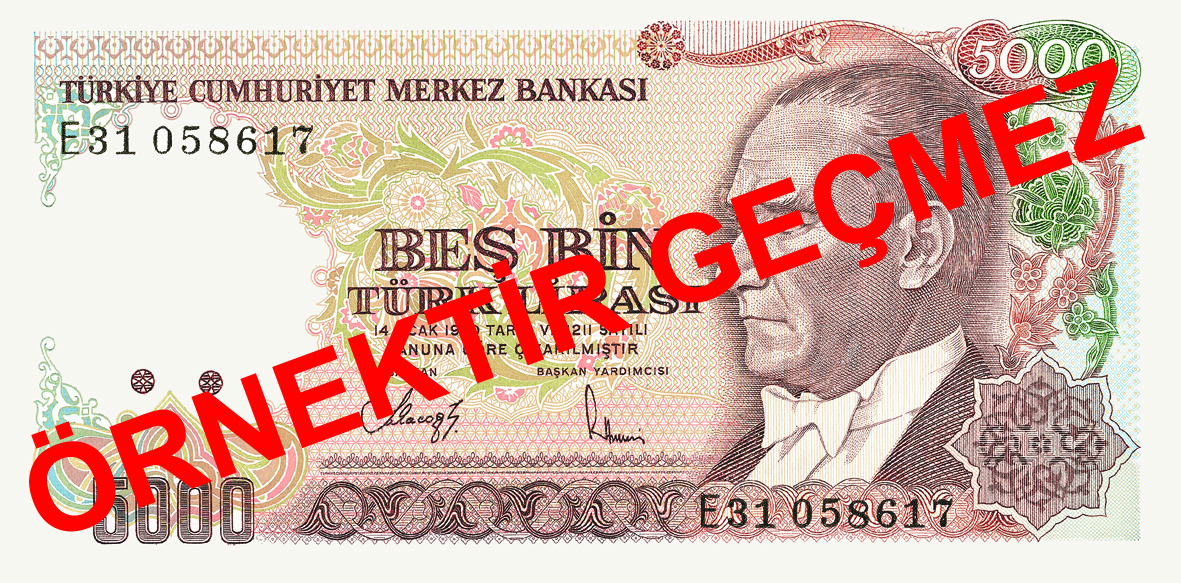
| Issue date | 13.06.1988 |
|---|---|
| Date of withdrawal | 31.01.1994 |
| End of redemption period | 31.01.2004 |
| Signatures | Dr. Rüşdü SARACOGLU, Ruhi HASESKİ |
| Dimensions | 72x146 mm |
| Front design | A portrait of Atatürk |
| Back design | Mevlana Museum in Konya and a figure of Mevlana |
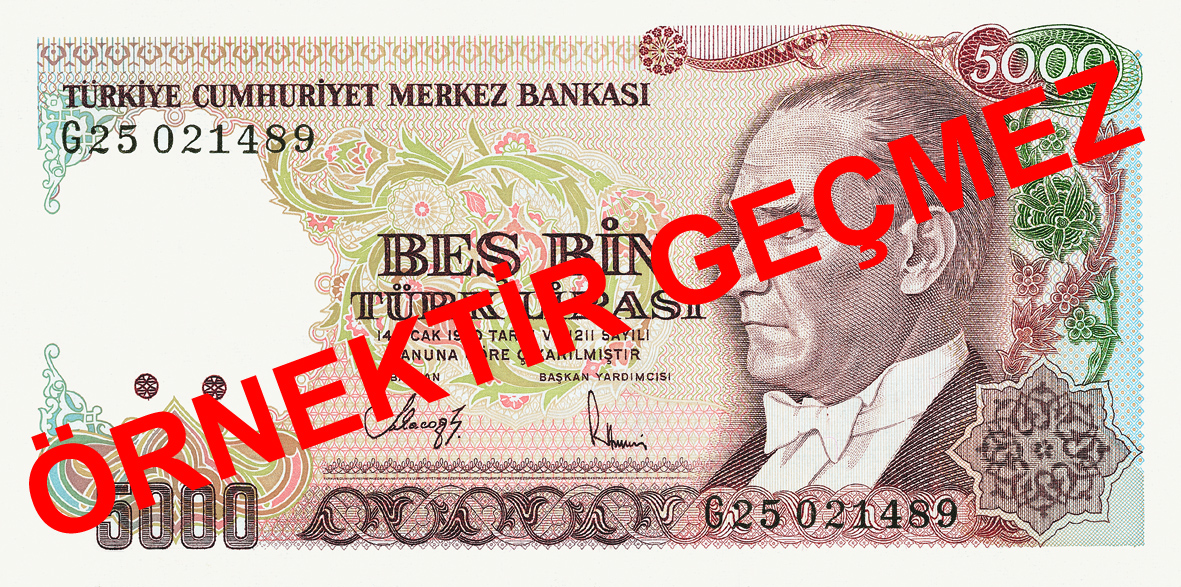
| Issue date | 28.05.1990 |
|---|---|
| Date of withdrawal | 31.01.1994 |
| End of redemption period | 31.01.2004 |
| Signatures | Dr. Rüşdü SARACOGLU, Ruhi HASESKİ |
| Dimensions | 72x146 mm |
| Front design | A portrait of Atatürk |
| Back design | Afsin-Elbistan Thermic Power Station |
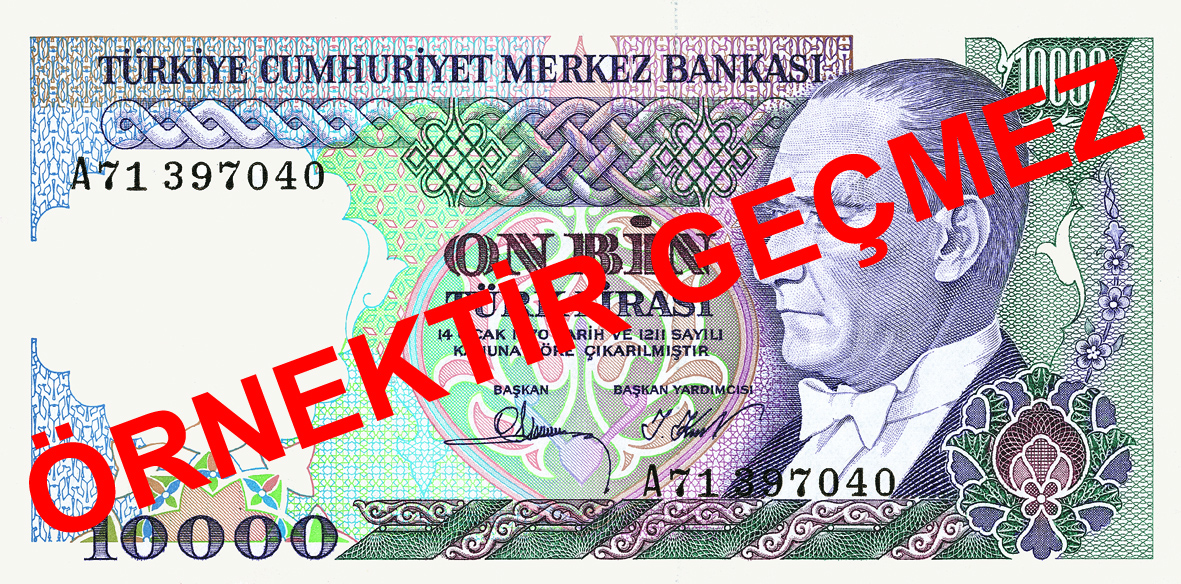
| Issue date | 25.10.1982 |
|---|---|
| Date of withdrawal | 15.12.1995 |
| End of redemption period | 15.12.2005 |
| Signatures | Osman ŞIKLAR, İbrahim KURT |
| Dimensions | 72x146 mm |
| Front design | A portrait of Atatürk |
| Back design | A portrait of Architect Sinan and his work of art Selimiye Mosque in Edirne |
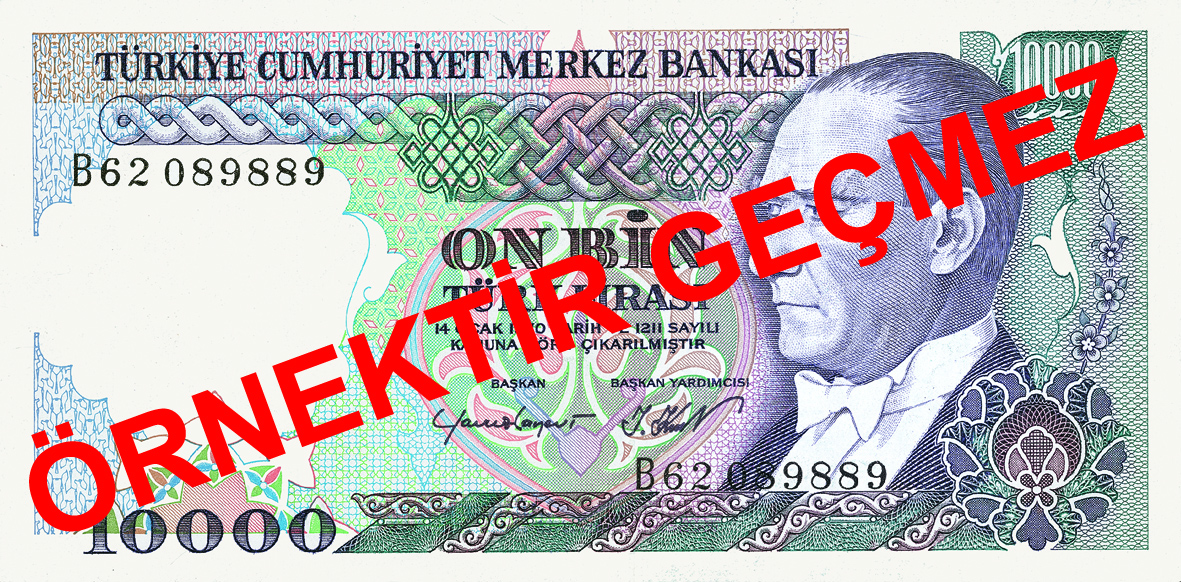
| Issue date | 13.04.1984 |
|---|---|
| Date of withdrawal | 15.12.1995 |
| End of redemption period | 15.12.2005 |
| Signatures | Yavuz CANEVİ, İbrahim KURT |
| Dimensions | 72x146 mm |
| Front design | A portrait of Atatürk |
| Back design | A portrait of Architect Sinan and his work of art Selimiye Mosque in Edirne |
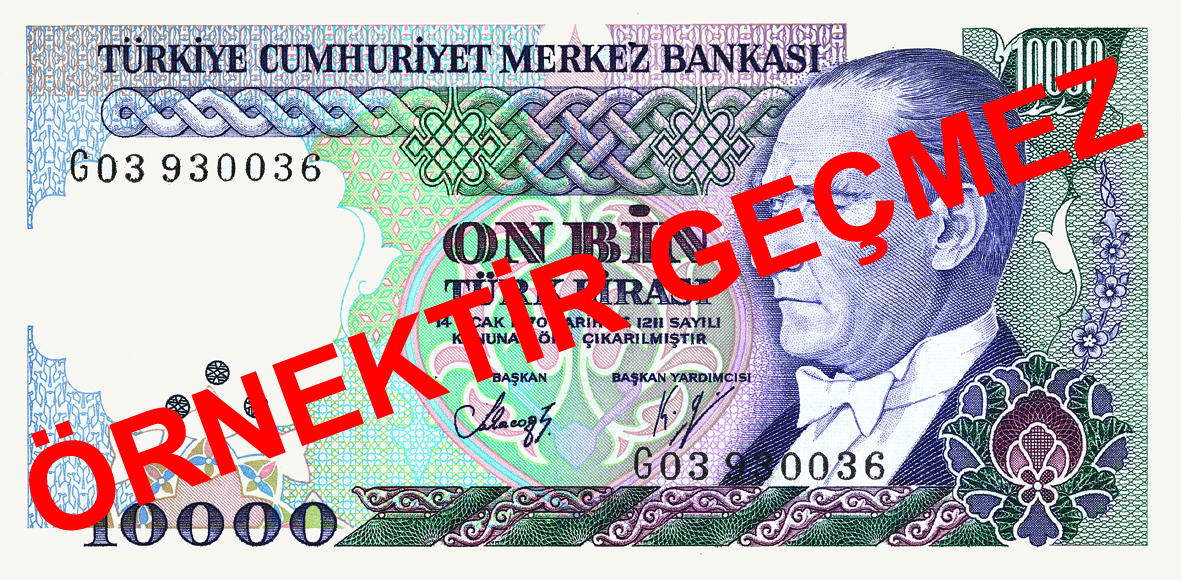
| Issue date | 24.01.1989 |
|---|---|
| Date of withdrawal | 15.12.1995 |
| End of redemption period | 15.12.2005 |
| Signatures | Dr. Rüşdü SARACOGLU, Kadir GÜNAY |
| Dimensions | 72x146 mm |
| Front design | A portrait of Atatürk |
| Back design | A portrait of Architect Sinan and his work of art Selimiye Mosque in Edirne |
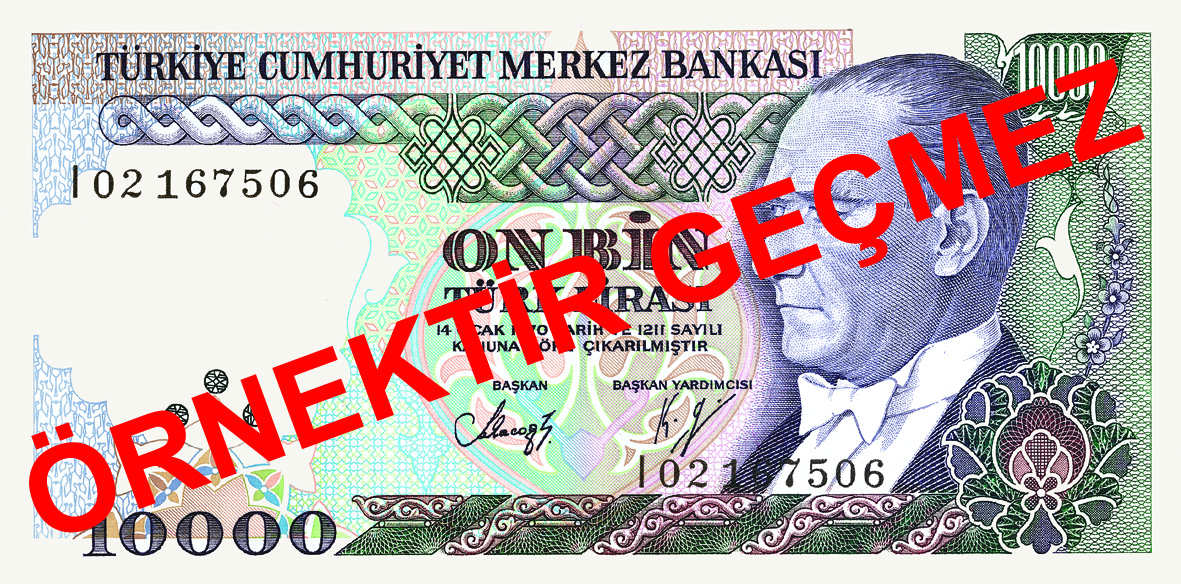
| Issue date | 22.02.1993 |
|---|---|
| Date of withdrawal | 15.12.1995 |
| End of redemption period | 15.12.2005 |
| Signatures | Dr. Rüşdü SARACOGLU, Kadir GÜNAY |
| Dimensions | 72x146 mm |
| Front design | A portrait of Atatürk |
| Back design | A portrait of Architect Sinan and his work of art Selimiye Mosque in Edirne |
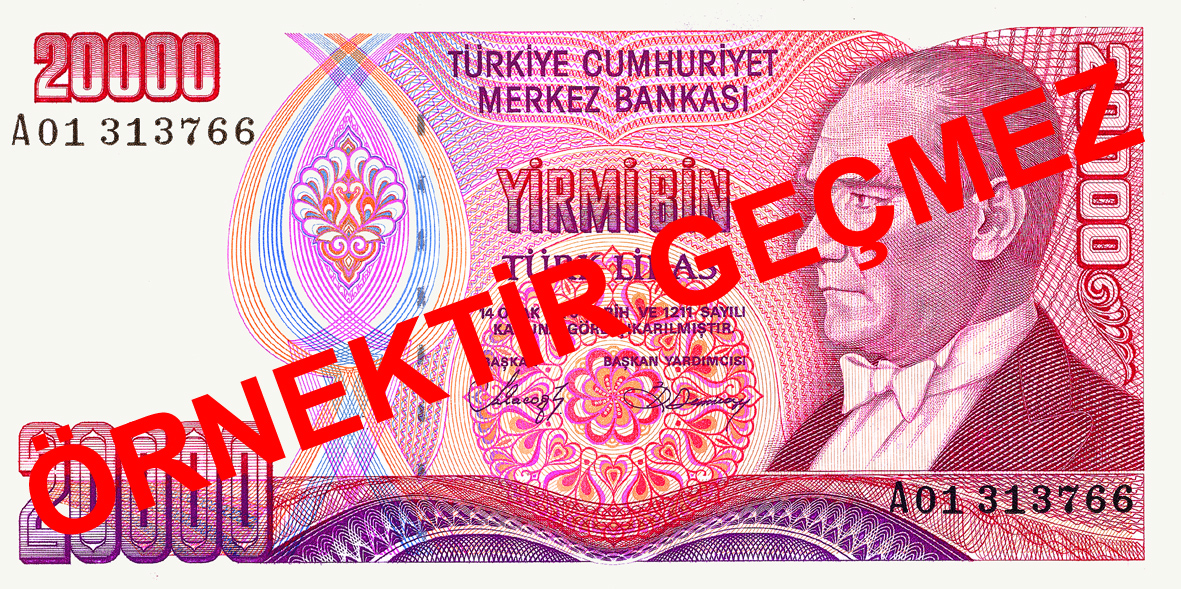
| Issue date | 09.05.1988 |
|---|---|
| Date of withdrawal | 09.09.1997 |
| End of redemption period | 09.09.2007 |
| Signatures | Dr. Rüşdü SARACOGLU, Bediz DEMİRAY |
| Dimensions | 76x152 mm |
| Front design | A portrait of Atatürk |
| Back design | New Head Office Building of Central Bank in Ankara |
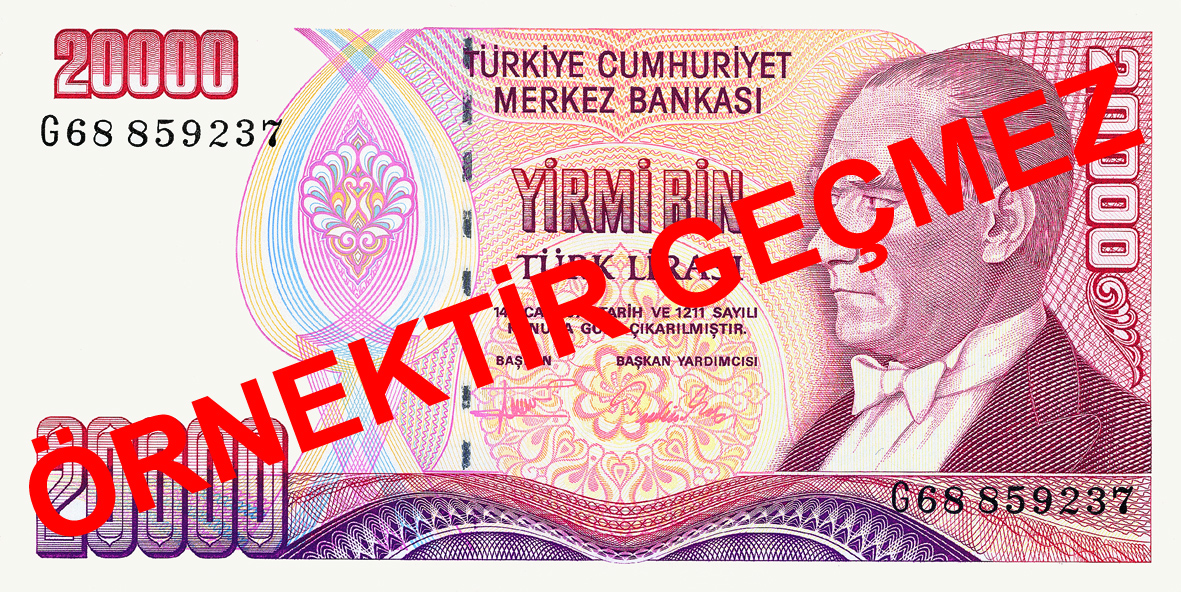
| Issue date | 03.04.1995 |
|---|---|
| Date of withdrawal | 09.09.1997 |
| End of redemption period | 09.09.2007 |
| Signatures | Ş. Yaman TÖRÜNER, Nedim USTA |
| Dimensions | 76x152 mm |
| Front design | A portrait of Atatürk |
| Back design | New Head Office Building of Central Bank in Ankara |
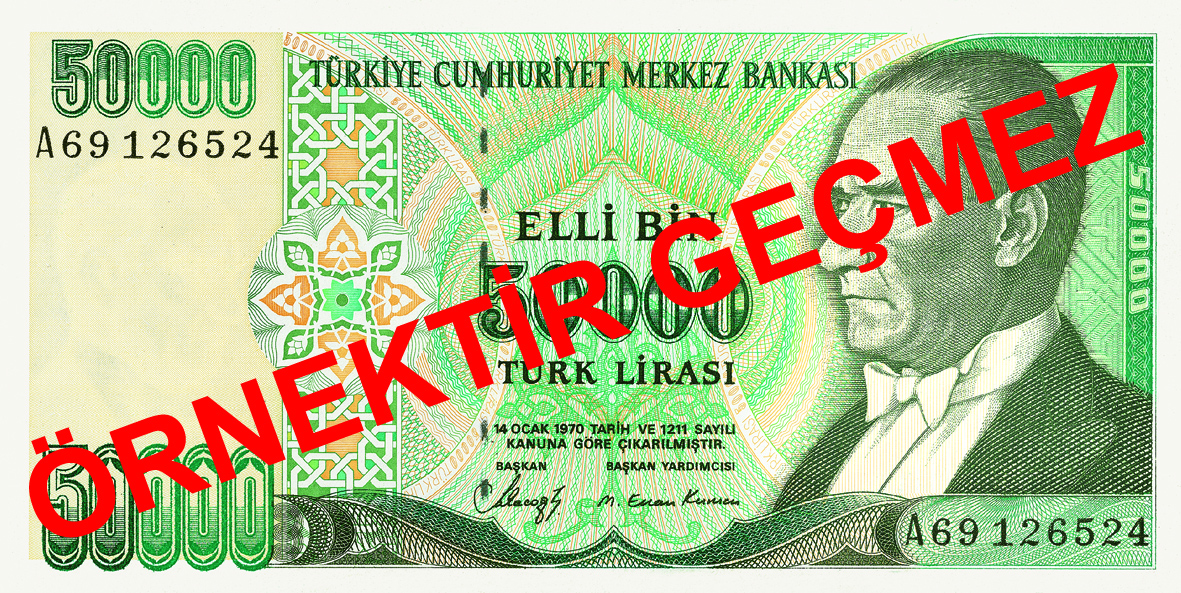
| Issue date | 15.05.1989 |
|---|---|
| Date of withdrawal | 05.11.1999 |
| End of redemption period | 04.11.2009 |
| Signatures | Dr. Rüşdü SARACOGLU, Dr. M. Ercan KUMCU |
| Dimensions | 76x152 mm |
| Front design | A portrait of Atatürk |
| Back design | House of Parliament in Ankara |
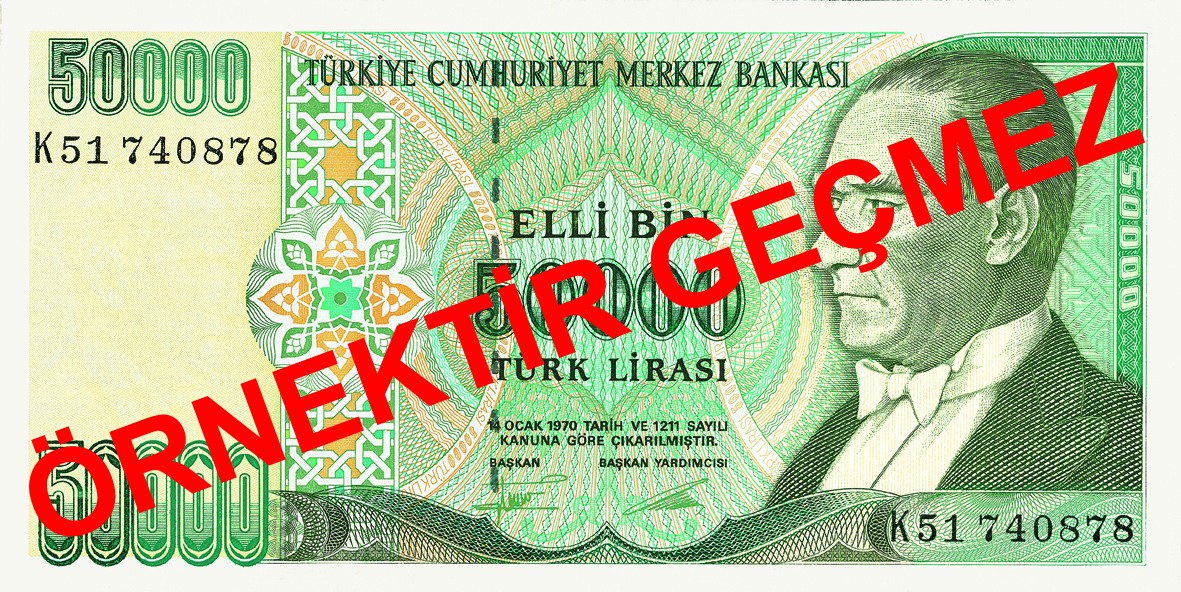
| Issue date | 20.02.1995 |
|---|---|
| Date of withdrawal | 05.11.1999 |
| End of redemption period | 04.11.2009 |
| Signatures | Ş. Yaman TÖRÜNER, Osman Cavit ERTAN |
| Dimensions | 76x152 mm |
| Front design | A portrait of Atatürk |
| Back design | House of Parliament in Ankara |
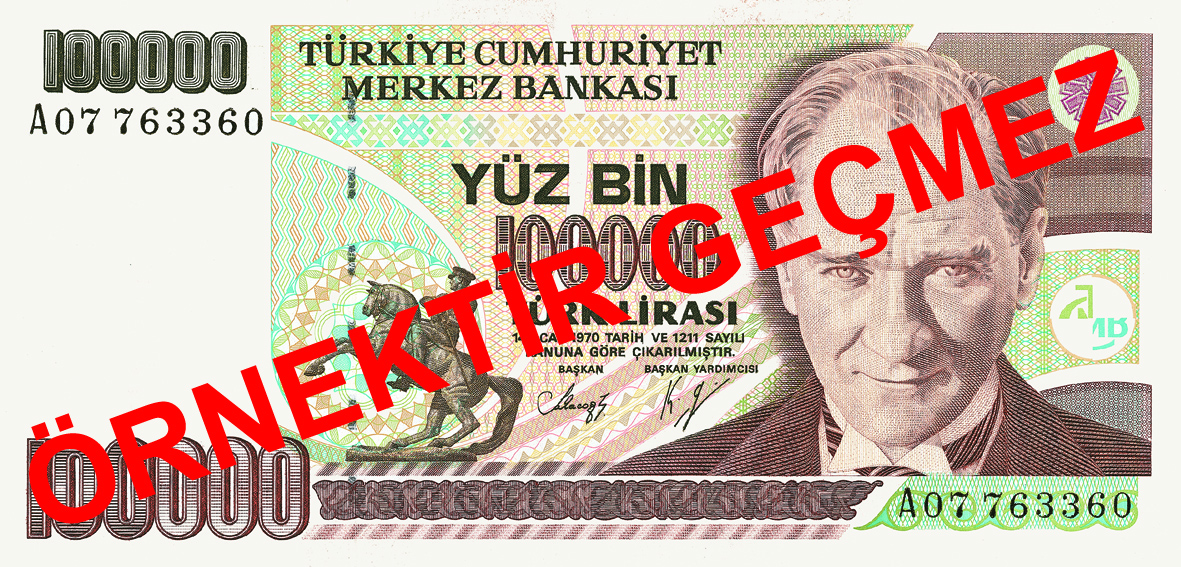
| Issue date | 11.11.1991 |
|---|---|
| Date of withdrawal | 5.11.2001 |
| End of redemption period | 04.11.2009 |
| Signatures | Dr. Rüşdü SARACOGLU, Kadir GÜNAY |
| Dimensions | 76x158 mm |
| Front design | A portrait of Atatürk on the right and the figure of Atatürk Statue in Samsun on the left |
| Back design | A group of young students giving flowers to Atatürk |

| Issue date | 15.07.1994 |
|---|---|
| Date of withdrawal | 5.11.2001 |
| End of redemption period | 4.11.2011 |
| Signatures | Ş. Yaman TÖRÜNER, Osman Cavit ERTAN |
| Dimensions | 76x158 mm |
| Front design | A portrait of Atatürk on the right and the figure of Atatürk Statue in Samsun on the left |
| Back design | A group of young students giving flowers to Atatürk |
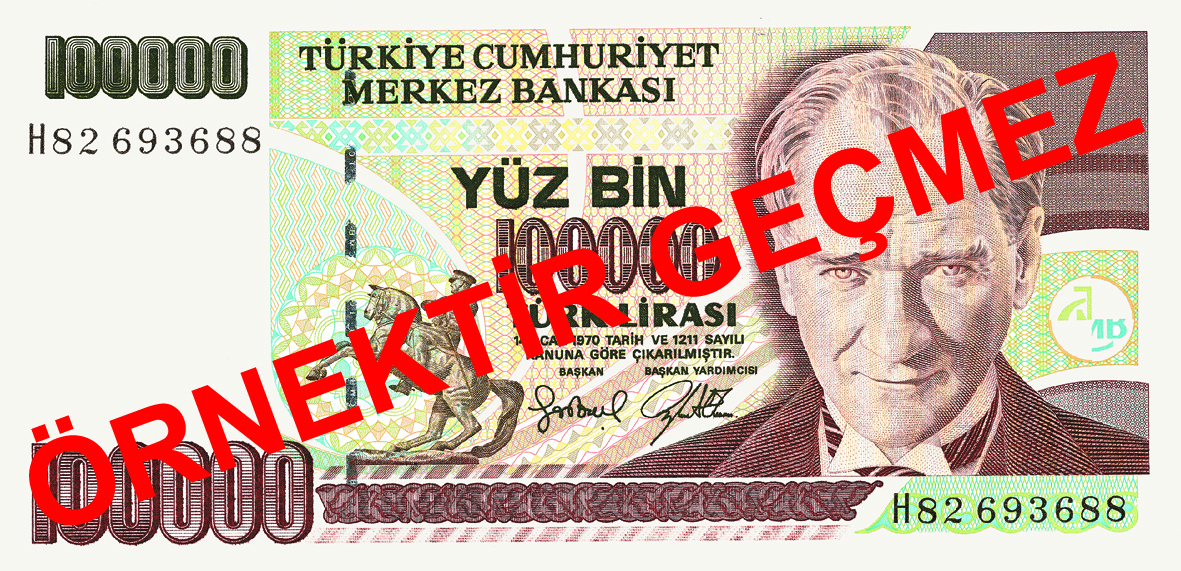
| Issue date | 12.08.1996 |
|---|---|
| Date of withdrawal | 5.11.2001 |
| End of redemption period | 4.11.2011 |
| Signatures | Gazi ERÇEL, Aykut EKZEN |
| Dimensions | 76x158 mm |
| Front design | A portrait of Atatürk on the right and the figure of Atatürk Statue in Samsun on the left |
| Back design | A group of young students giving flowers to Atatürk |
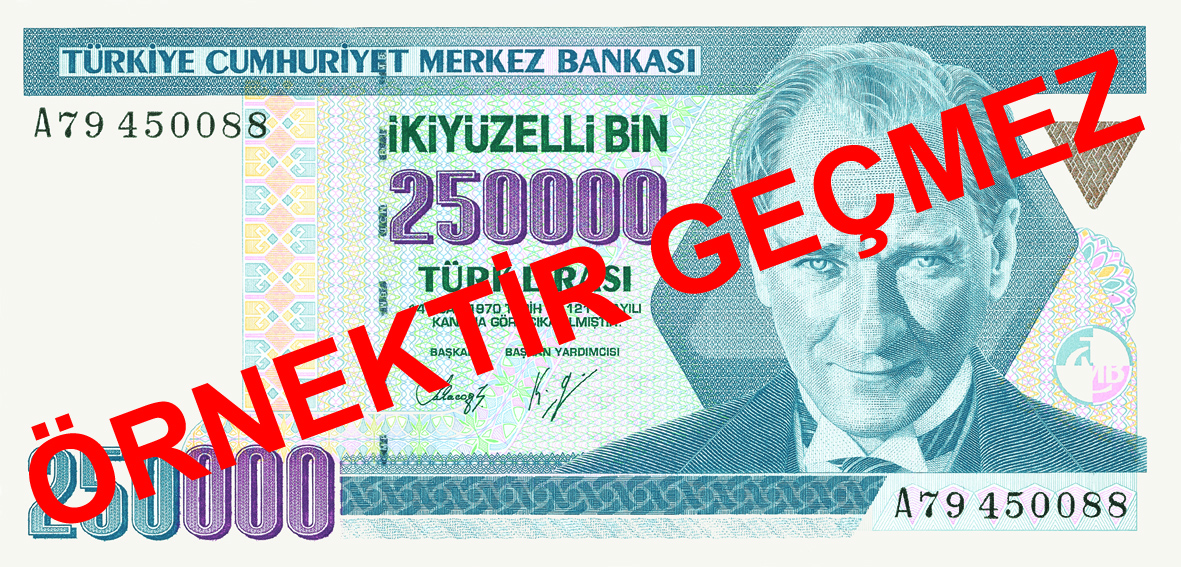
| Issue date | 02.10.1992 |
|---|---|
| Date of withdrawal | 1.1.2006 |
| End of redemption period | 31.12.2015 |
| Signatures | Dr. Rüşdü SARACOGLU, Kadir GÜNAY |
| Dimensions | 76x158 mm |
| Front design | A portrait of Atatürk |
| Back design | The historical Red Tower in Alanya |

| Issue date | 02.10.1995 |
|---|---|
| Date of withdrawal | 1.1.2006 |
| End of redemption period | 31.12.2015 |
| Signatures | Ş. Yaman TÖRÜNER, Osman Cavit ERTAN |
| Dimensions | 76x158 mm |
| Front design | A portrait of Atatürk |
| Back design | The historical Red Tower in Alanya |
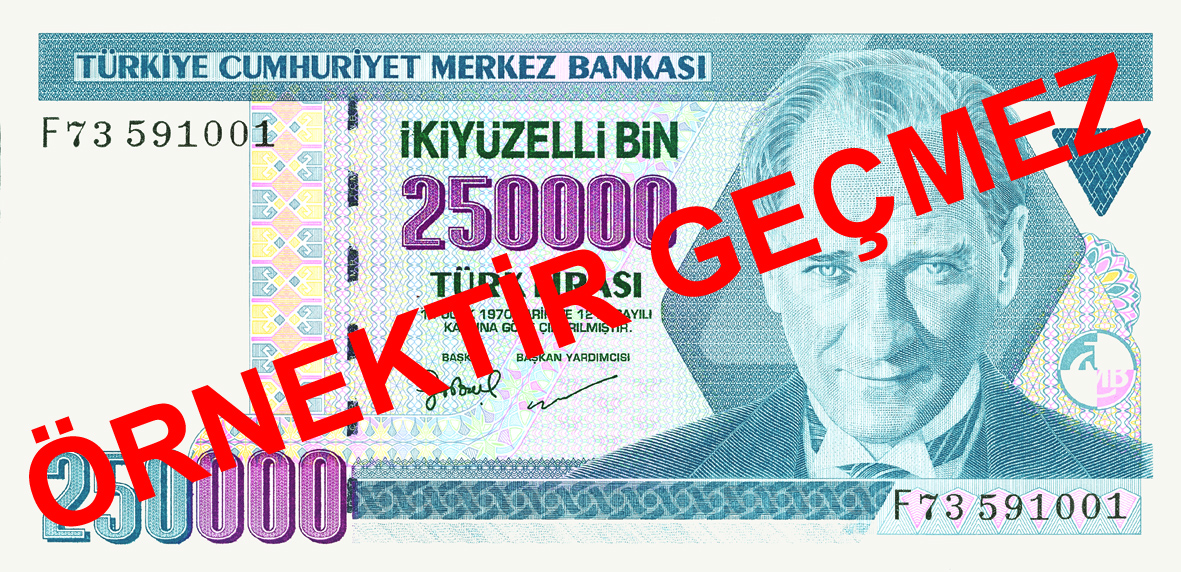
| Issue date | 16.03.1998 |
|---|---|
| Date of withdrawal | 1.1.2006 |
| End of redemption period | 31.12.2015 |
| Signatures | Gazi ERÇEL, Şükrü BİNAY |
| Dimensions | 76x158 mm |
| Front design | A portrait of Atatürk |
| Back design | The historical Red Tower in Alanya |
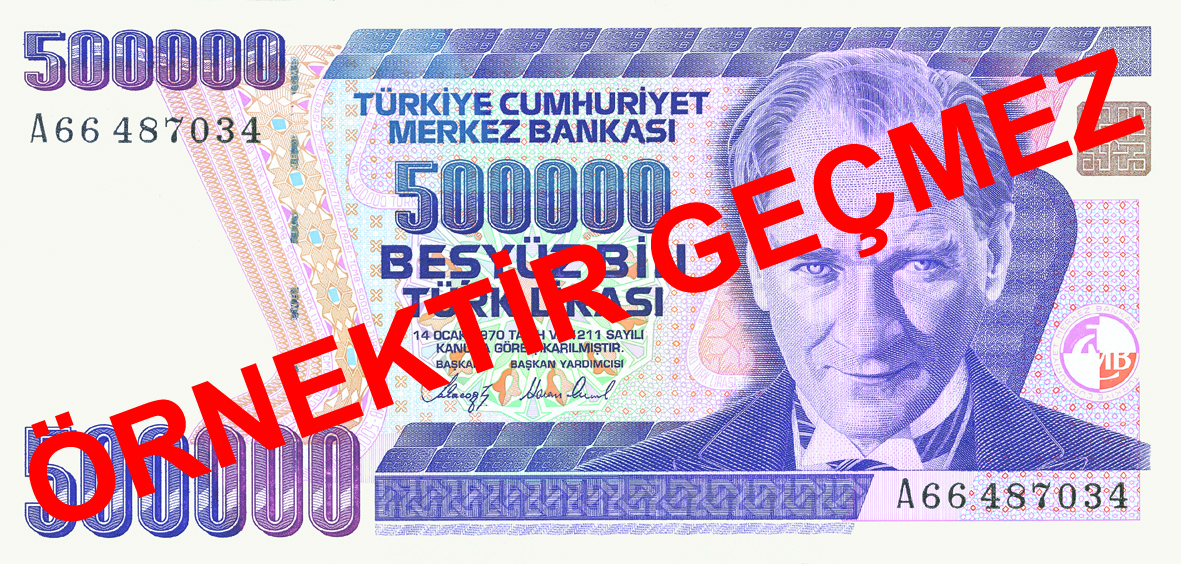
| Issue date | 18.03.1993 |
|---|---|
| Date of withdrawal | 1.1.2006 |
| End of redemption period | 31.12.2015 |
| Signatures | Dr. Rüşdü SARACOGLU, Dr. Hasan ERSEL |
| Dimensions | 76x160 mm |
| Front design | A portrait of Atatürk |
| Back design | A panoramic view of the Monument of Canakkale Martyrs |
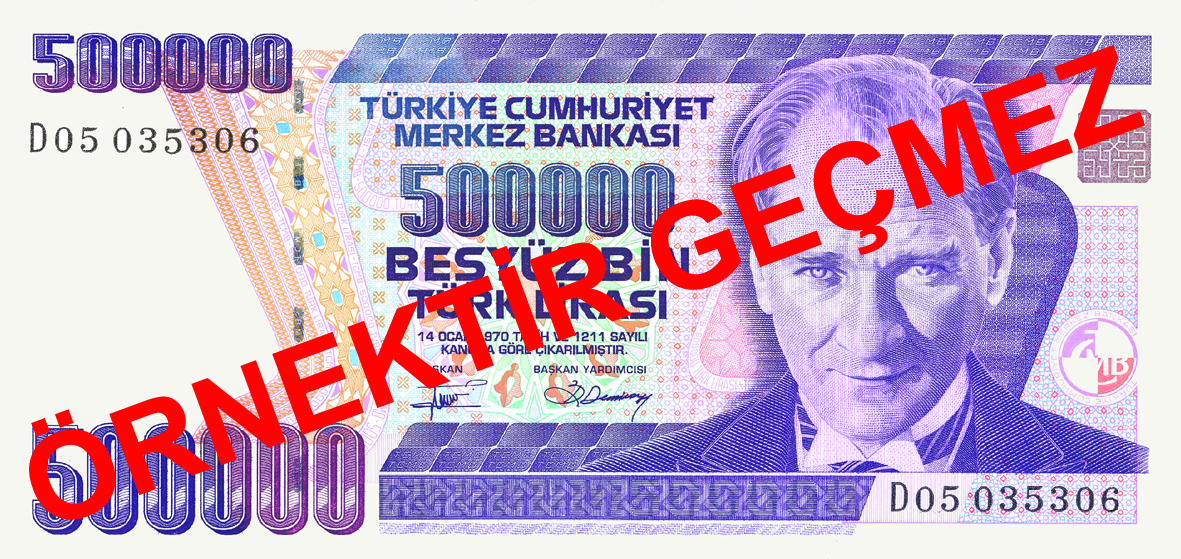
| Issue date | 16.05.1994 |
|---|---|
| Date of withdrawal | 1.1.2006 |
| End of redemption period | 31.12.2015 |
| Signatures | Ş. Yaman TÖRÜNER, Bediz DEMİRAY |
| Dimensions | 76x160 mm |
| Front design | A portrait of Atatürk |
| Back design | A panoramic view of the Monument of Canakkale Martyrs |
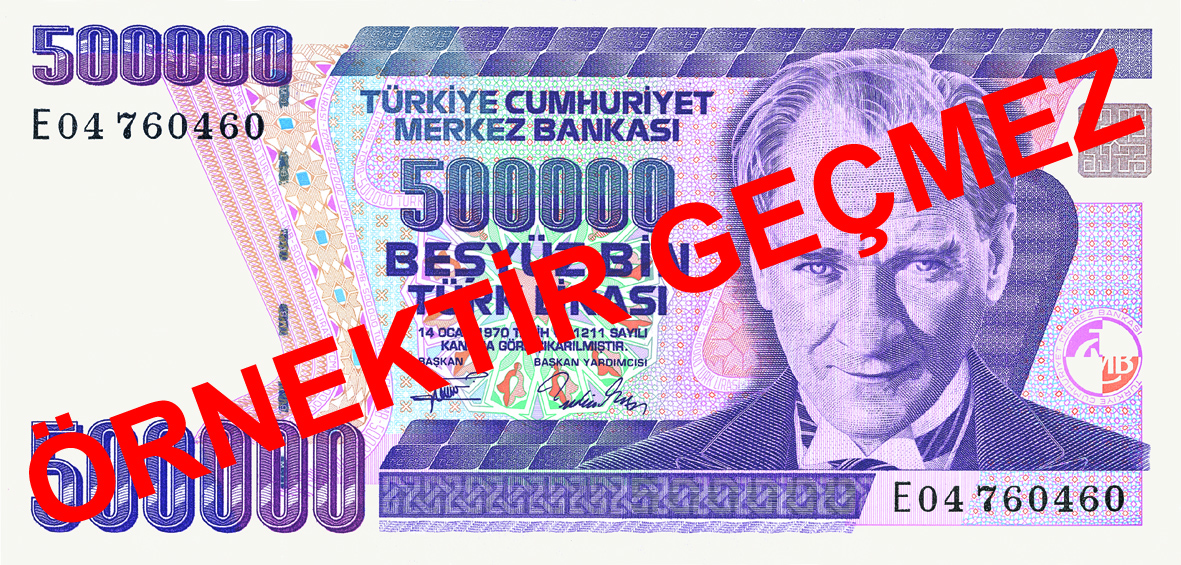
| Issue date | 26.08.1994 |
|---|---|
| Date of withdrawal | 1.1.2006 |
| End of redemption period | 31.12.2015 |
| Signatures | Ş. Yaman TÖRÜNER, Nedim USTA |
| Dimensions | 76x160 mm |
| Front design | A portrait of Atatürk |
| Back design | A panoramic view of the Monument of Canakkale Martyrs |
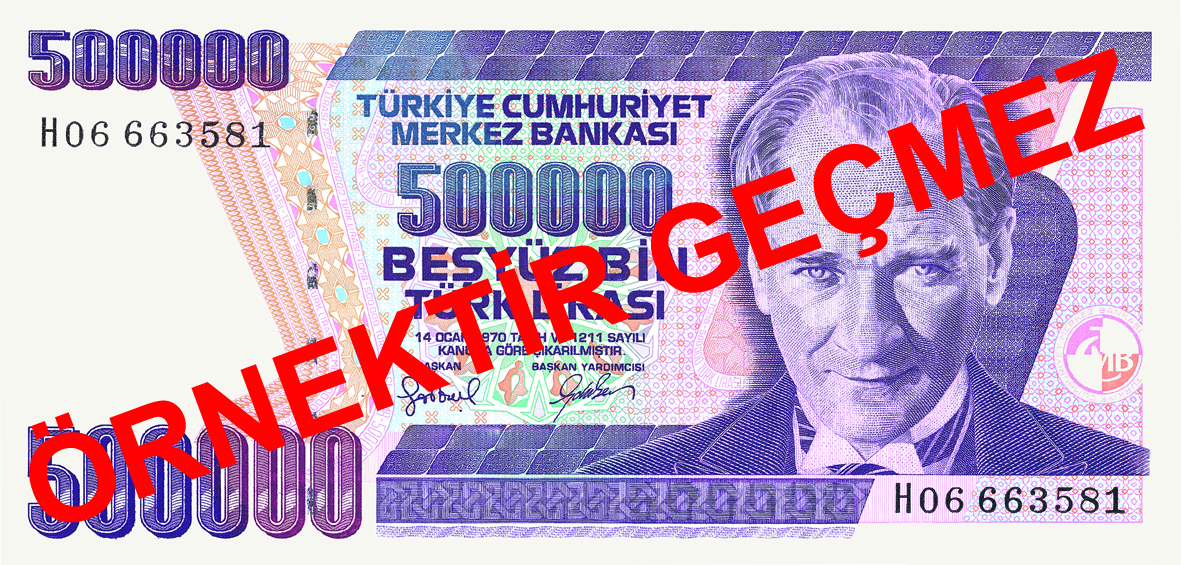
| Issue date | 10.10.1997 |
|---|---|
| Date of withdrawal | 1.1.2006 |
| End of redemption period | 31.12.2015 |
| Signatures | Gazi ERÇEL, Aydın ESEN |
| Dimensions | 76x160 mm |
| Front design | A portrait of Atatürk |
| Back design | A panoramic view of the Monument of Canakkale Martyrs |
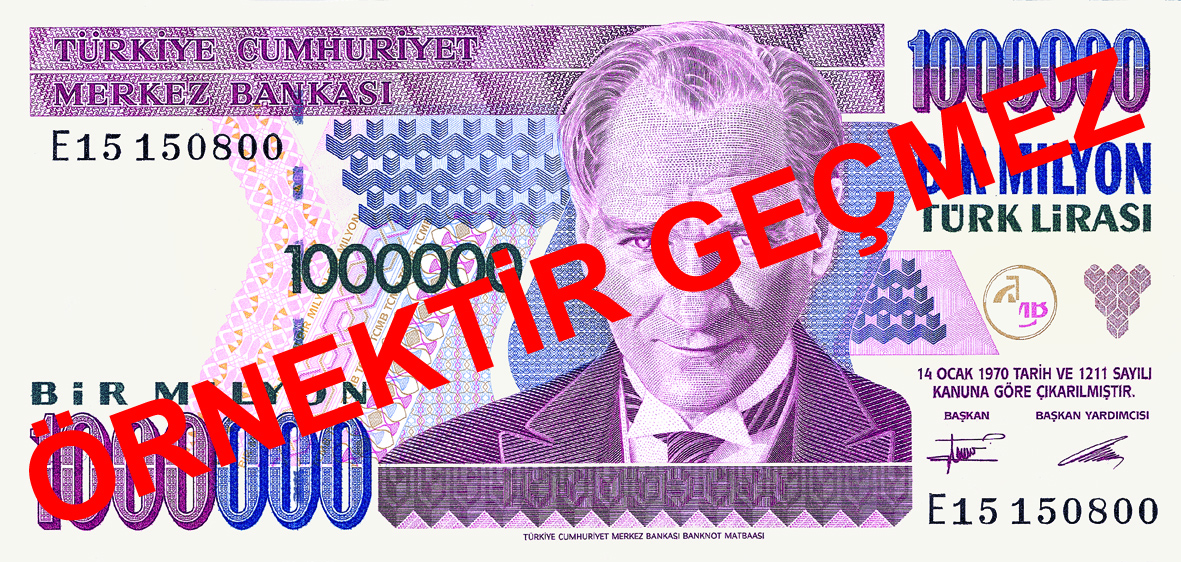
| Issue date | 16.01.1995 |
|---|---|
| Date of withdrawal | 1.1.2006 |
| End of redemption period | 31.12.2015 |
| Signatures | Ş. Yaman TÖRÜNER, Osman Cavit ERTAN |
| Dimensions | 76x160 mm |
| Front design | A portrait of Atatürk |
| Back design | A panoramic view of Atatürk Dam in Sanliurfa |
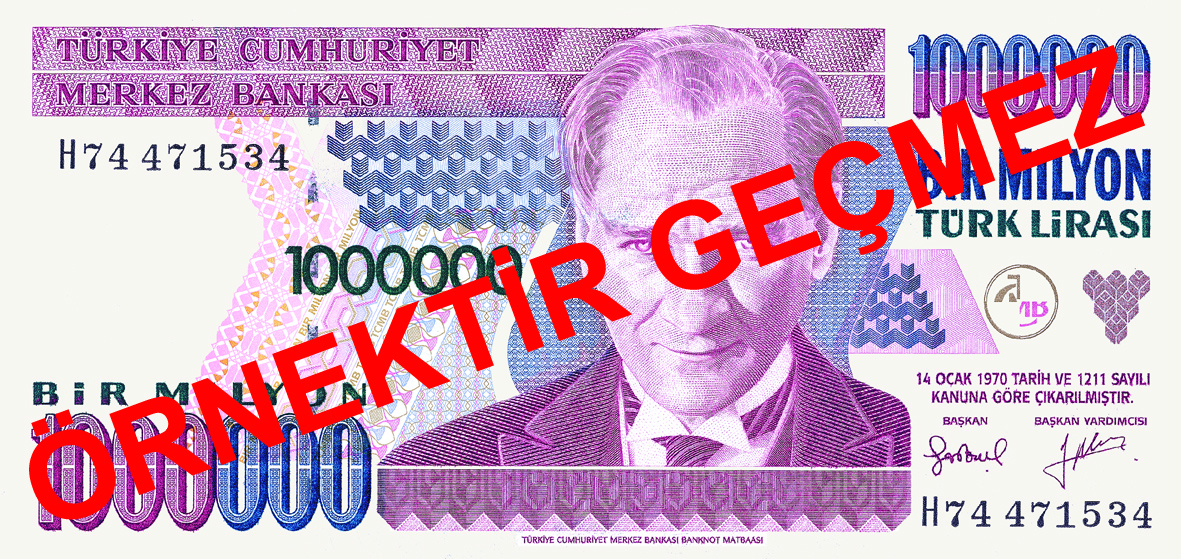
| Issue date | 09.09.1996 |
|---|---|
| Date of withdrawal | 1.1.2006 |
| End of redemption period | 31.12.2015 |
| Signatures | Gazi ERÇEL, Prof. Dr. Selçuk ABAÇ |
| Dimensions | 76x160 mm |
| Front design | A portrait of Atatürk |
| Back design | A panoramic view of Atatürk Dam in Sanliurfa |
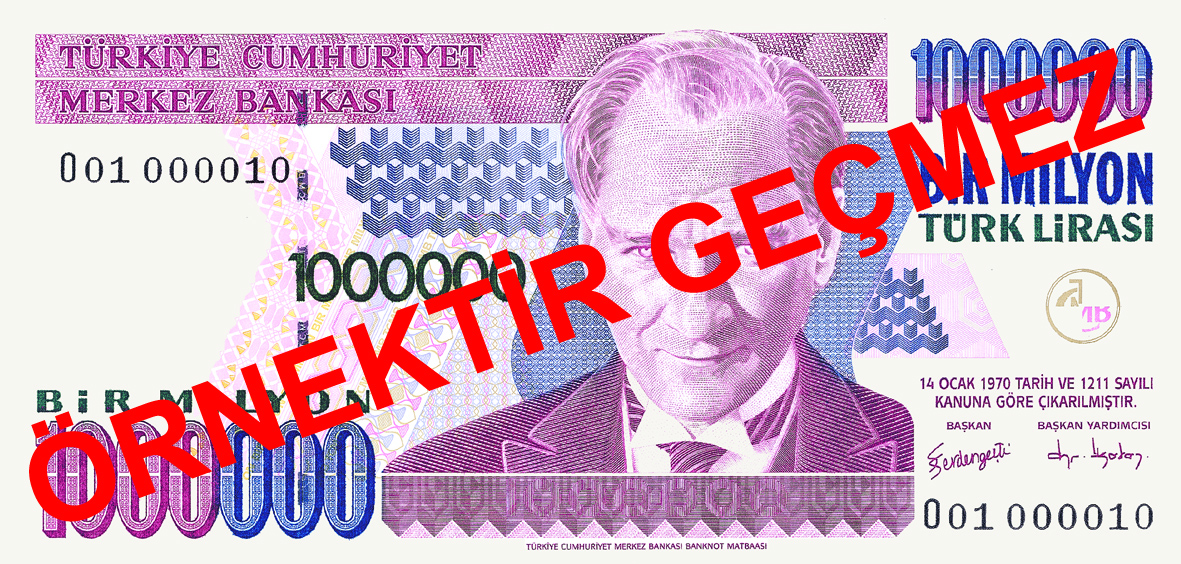
| Issue date | 10.01.2002 |
|---|---|
| Date of withdrawal | 1.1.2006 |
| End of redemption period | 31.12.2015 |
| Signatures | Süreyya SERDENGEÇTİ, Dr. S. Fatih ÖZATAY |
| Dimensions | 76x160 mm |
| Front design | A portrait of Atatürk |
| Back design | A panoramic view of Atatürk Dam in Sanliurfa |
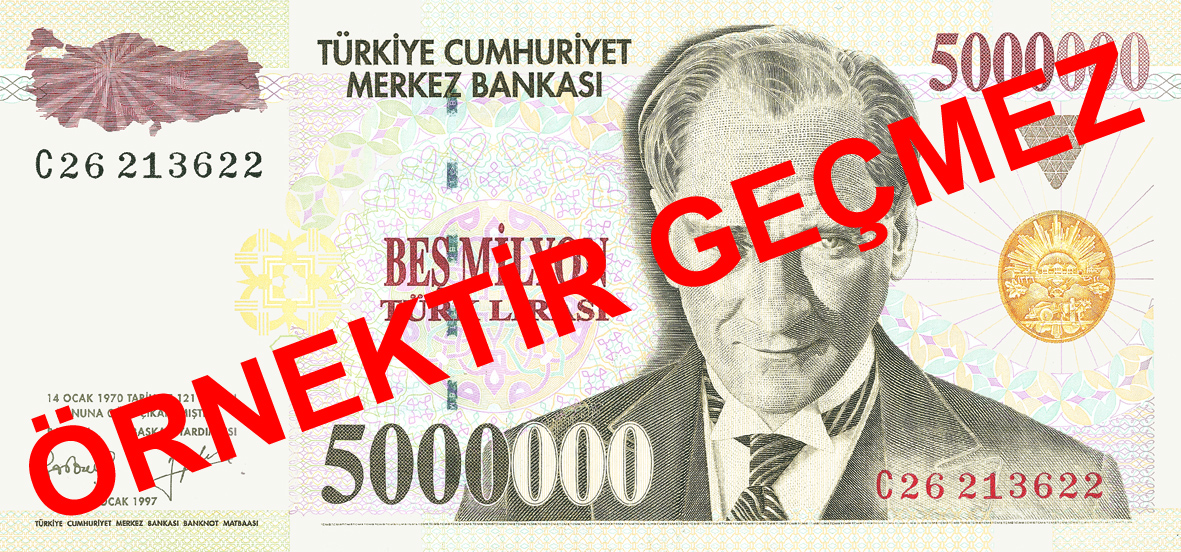
| Issue date | 06.01.1997 |
|---|---|
| Date of withdrawal | 1.1.2006 |
| End of redemption period | 31.12.2015 |
| Signatures | Gazi ERÇEL, Prof. Dr. Selçuk ABAÇ |
| Dimensions | 76x162 mm |
| Front design | A portrait of Atatürk |
| Back design | The Mausoleum of Atatürk in Ankara |

| Issue date | 05.11.1999 |
|---|---|
| Date of withdrawal | 1.1.2006 |
| End of redemption period | 31.12.2015 |
| Signatures | Gazi ERÇEL, Süreyya SERDENGEÇTİ |
| Dimensions | 76x162 mm |
| Front design | A portrait of Atatürk |
| Back design | The World Map of Piri Reis |
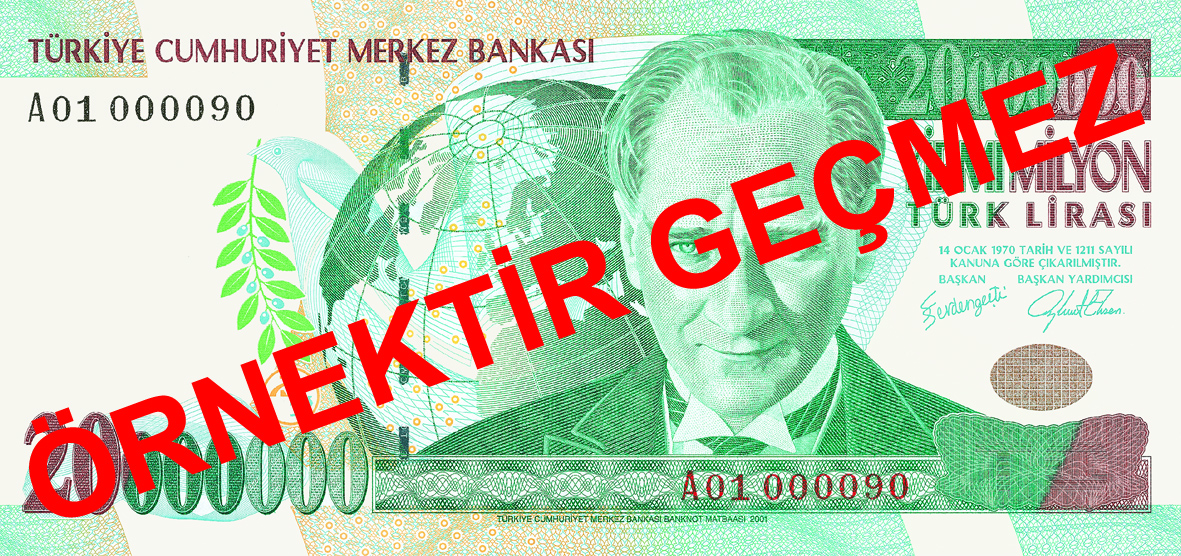
| Issue date | 05.11.2001 |
|---|---|
| Date of withdrawal | 1.1.2006 |
| End of redemption period | 31.12.2015 |
| Signatures | Süreyya SERDENGEÇTİ, Aykut EKZEN |
| Dimensions | 76x162 mm |
| Front design | A portrait of Atatürk |
| Back design | The Ancient City of Ephesus in Selçuk |
The high and chronic inflation prevailing in Türkiye since the 1970s had caused certain economic values to be expressed in billions, trillions and even quadrillions.
During this process, the cash need of the economy was met by putting new higher-value banknotes into circulation approximately every two years since 1981. Consequently, the 20,000,000 Turkish lira banknote became the highest-denomination banknote in the world. This had a negative effect on the credibility of our currency. On the other hand, zero-laden figures were causing troubles in many fields of daily life such as cash transactions, accounting and statistical records, data processing programs, payment systems, price tagging, petrol pumps, and taximeters. Therefore, dropping six zeros from our currency became both a psychological and a technical necessity.

| Issue date | 1.1.2005 |
|---|---|
| Date of withdrawal | 1.1.2010 |
| End of redemption period | 31.12.2019 |
| Signatures | Süreyya SERDENGEÇTİ, Sedef AYALP |
| Dimensions | 76x156 mm |
| Front design | A portrait of Atatürk |
| Back design | Atatürk Dam in Şanlıurfa-Adıyaman |
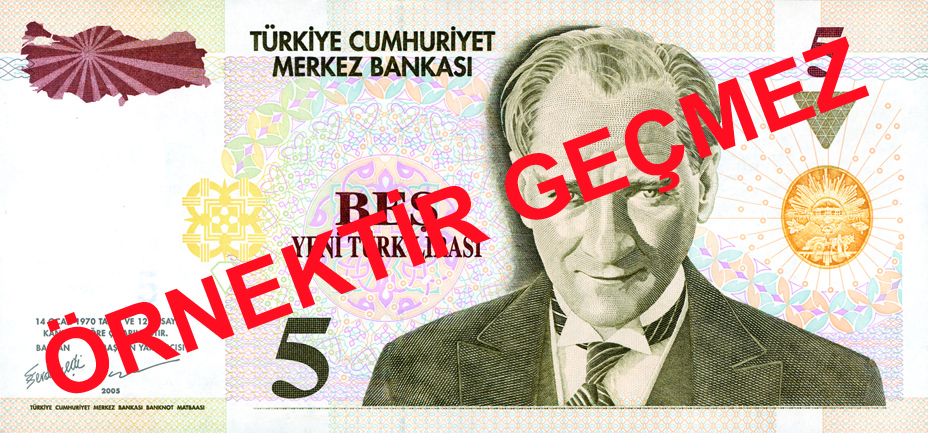
| Issue date | 1.1.2005 |
|---|---|
| Date of withdrawal | 1.1.2010 |
| End of redemption period | 31.12.2019 |
| Signatures | Süreyya SERDENGEÇTİ, Şükrü BİNAY |
| Dimensions | 76x162 mm |
| Front design | A portrait of Atatürk |
| Back design | The Mausoleum of Atatürk in Ankara |
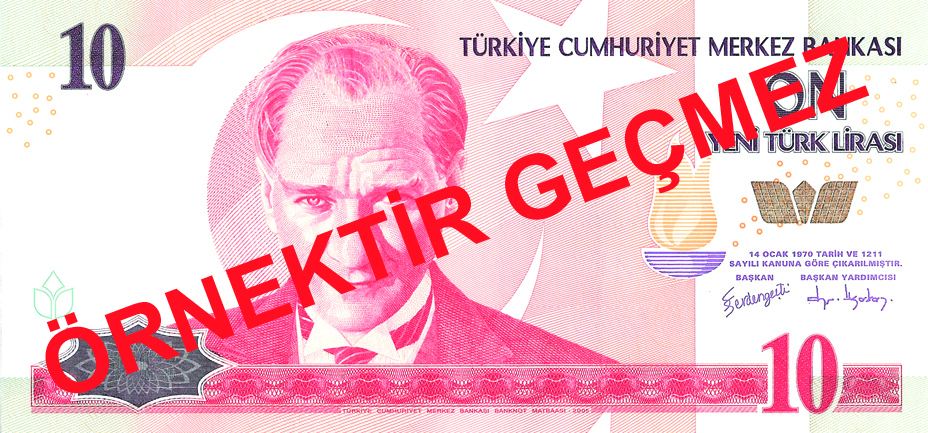
| Issue date | 1.1.2005 |
|---|---|
| Date of withdrawal | 1.1.2010 |
| End of redemption period | 31.12.2019 |
| Signatures | Süreyya SERDENGEÇTİ, Prof. Dr. S. Fatih ÖZATAY |
| Dimensions | 76x162 mm |
| Front design | A portrait of Atatürk |
| Back design | The wold map of Piri Reis drawn in 1513 |
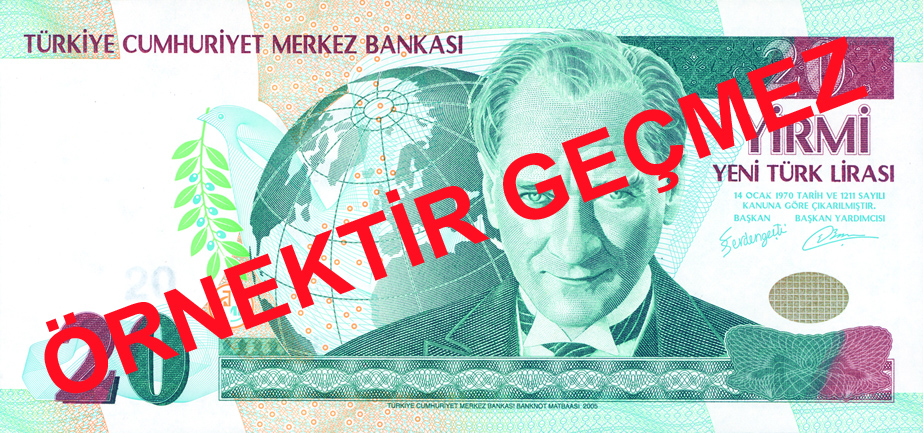
| Issue date | 1.1.2005 |
|---|---|
| Date of withdrawal | 1.1.2010 |
| End of redemption period | 31.12.2019 |
| Signatures | Süreyya SERDENGEÇTİ, Doç.Dr.Erdem BAŞÇI |
| Dimensions | 76x162 mm |
| Front design | A portrait of Atatürk |
| Back design | Ancient City of Ephesus-Selçuk |
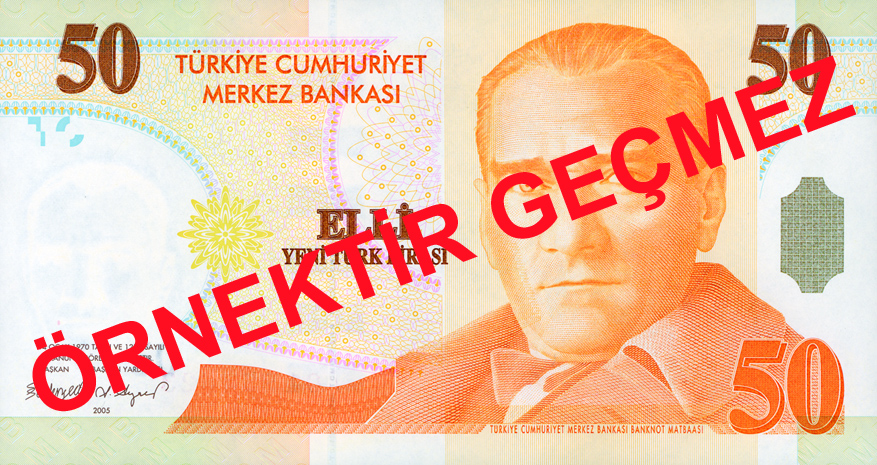
| Issue date | 1.1.2005 |
|---|---|
| Date of withdrawal | 1.1.2010 |
| End of redemption period | 31.12.2019 |
| Signatures | Süreyya SERDENGEÇTİ, Sedef AYALP |
| Dimensions | 81x152 mm |
| Front design | A portrait of Atatürk |
| Back design | Cappadocia |
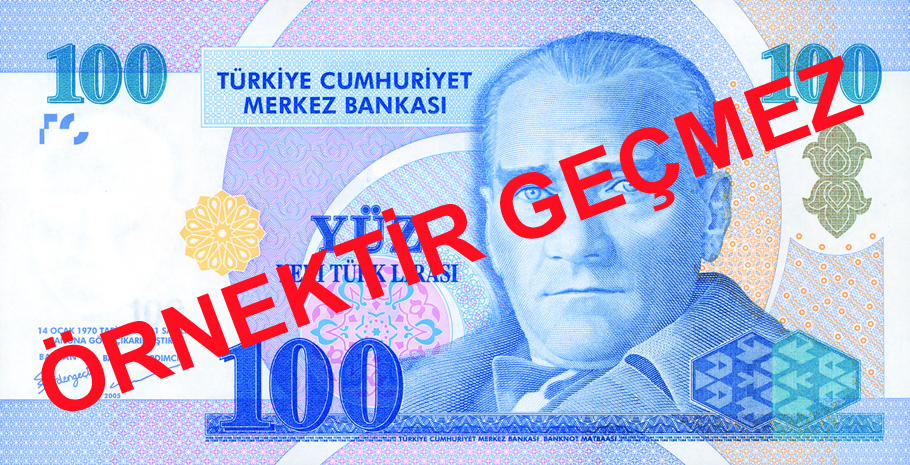
| Issue date | 1.1.2005 |
|---|---|
| Date of withdrawal | 1.1.2010 |
| End of redemption period | 31.12.2019 |
| Signatures | Süreyya SERDENGEÇTİ, Şükrü BİNAY |
| Dimensions | 81x158 mm |
| Front design | A portrait of Atatürk |
| Back design | Ishak Pasha Palace-Doğubayazıt |

A new currency reform was designed to end the complexity caused by the use of many zeros. The Law No. 5083 on the Currency Unit of the Republic of Türkiye dated 28 January 2004 introduced the decision to remove six zeros from the Turkish currency. Under this operation, the prefix “New” was added to the name of Eighth Series (E8) banknotes, and these banknotes were put into circulation on 1 January 2005 to circulate for a temporary period of time.
To avoid any confusion in use, these new banknotes were printed with the same design as the Seventh Series (E7) banknotes. The banknotes were introduced in six different denominations as 1, 5, 10, 20, 50 and 100 New Turkish lira banknotes, all of which were designed and printed in Türkiye. In the Eighth Series, the former 1,000,000 Turkish lira denomination was circulated both as banknotes and coins (1 New Turkish lira) whereas 50 and 100 New Turkish lira banknotes were printed for the first time, as distinct from the E7 Series.
The Law No. 5083 had stipulated that the prefix "New" would be used only in the transition period. The traditional currency unit of Türkiye is the Turkish lira. Many countries that dropped zeros from their currencies also followed the same procedure. Moreover, it was envisaged that after removing the prefix "New", banknotes with enhanced security and other features would be put into circulation to combat counterfeiting.
Accordingly, following the removal of the prefix “New” from the New Turkish lira and New kurus (Turkish coins), the Ninth Series (E9) banknotes in revised designs and different dimensions that incorporated advanced security features were put into circulation on 1 January 2009. E8 and E9 Series banknotes co-circulated throughout 2009.
The most important security feature introduced in Turkish lira banknotes was the holographic stripe. Other new features included the iridescent stripe on the reverse of banknotes and the intaglio printing intended for visually impaired people that uses the Braille alphabet to show the denomination of the banknote.
E9 Series banknotes bear the portraits of prominent people who played a significant role in Türkiye’s scientific, cultural and artistic life.
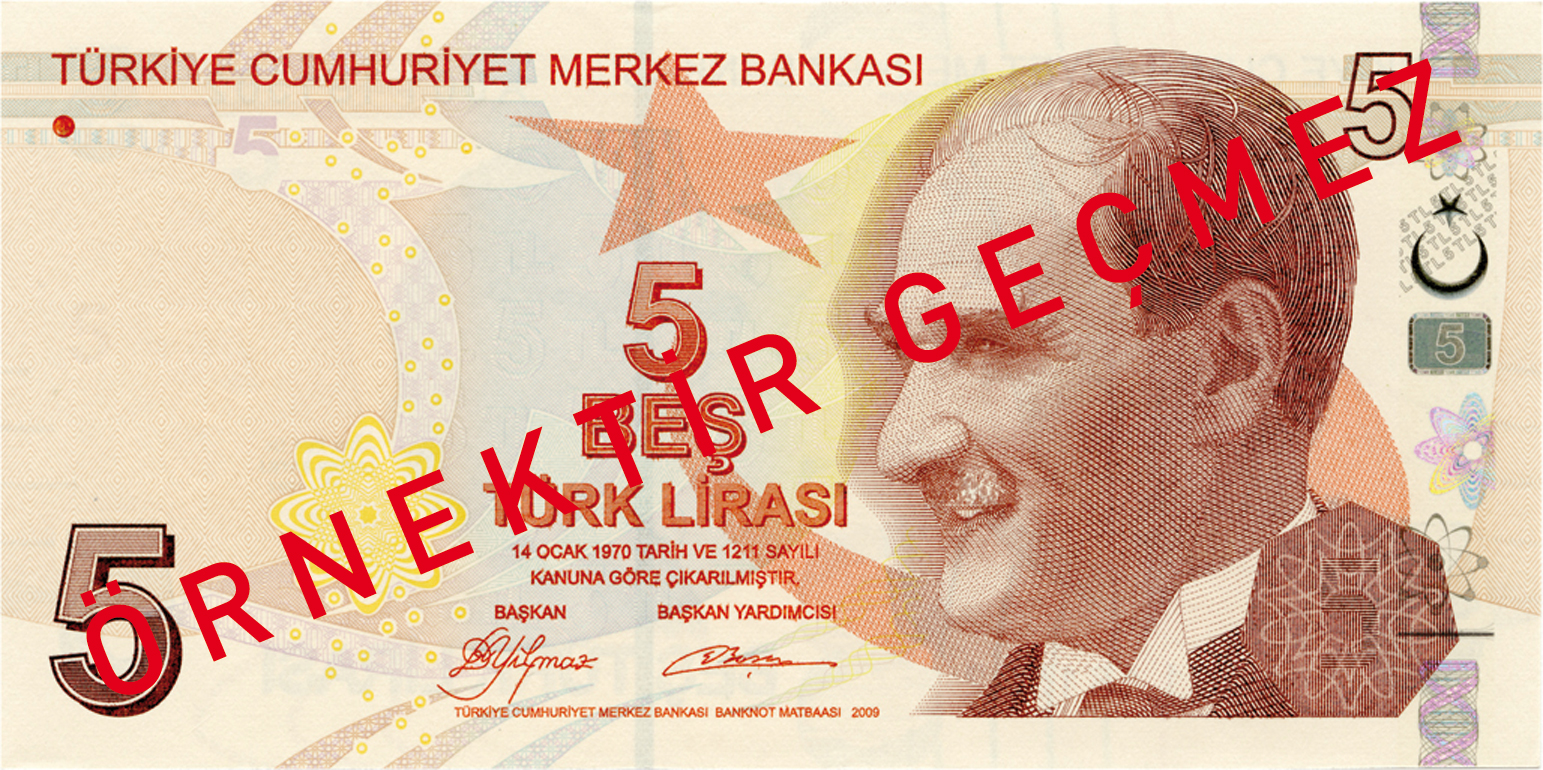
| Issue date | 1.1.2009 |
|---|---|
| Date of withdrawal | - |
| End of redemption period | - |
| Signatures | Durmuş YILMAZ, Doç.Dr. Erdem BAŞÇI |
| Dimensions | 64x130 mm |
| Front design | A portrait of Atatürk |
| Back design | A portrait of Ord.Prof.Dr. Aydın Sayılı |
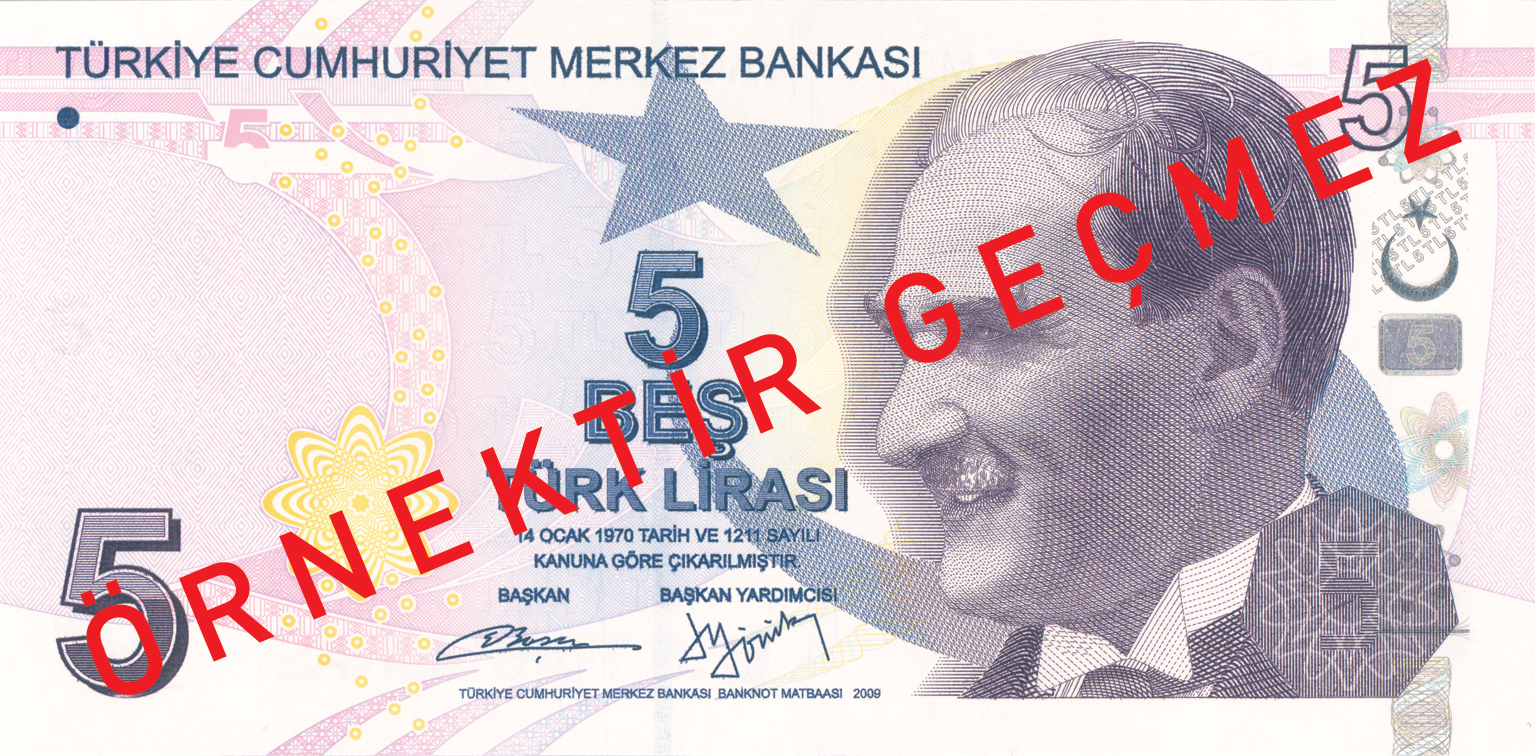
| Issue date | 8.4.2013 |
|---|---|
| Date of withdrawal | - |
| End of redemption period | - |
| Signatures | Doç.Dr. Erdem BAŞÇI, Doç.Dr. Mehmet YÖRÜKOĞLU |
| Dimensions | 64x130 mm |
| Front design | A portrait of Atatürk |
| Back design | A portrait of Ord.Prof.Dr. Aydın Sayılı |
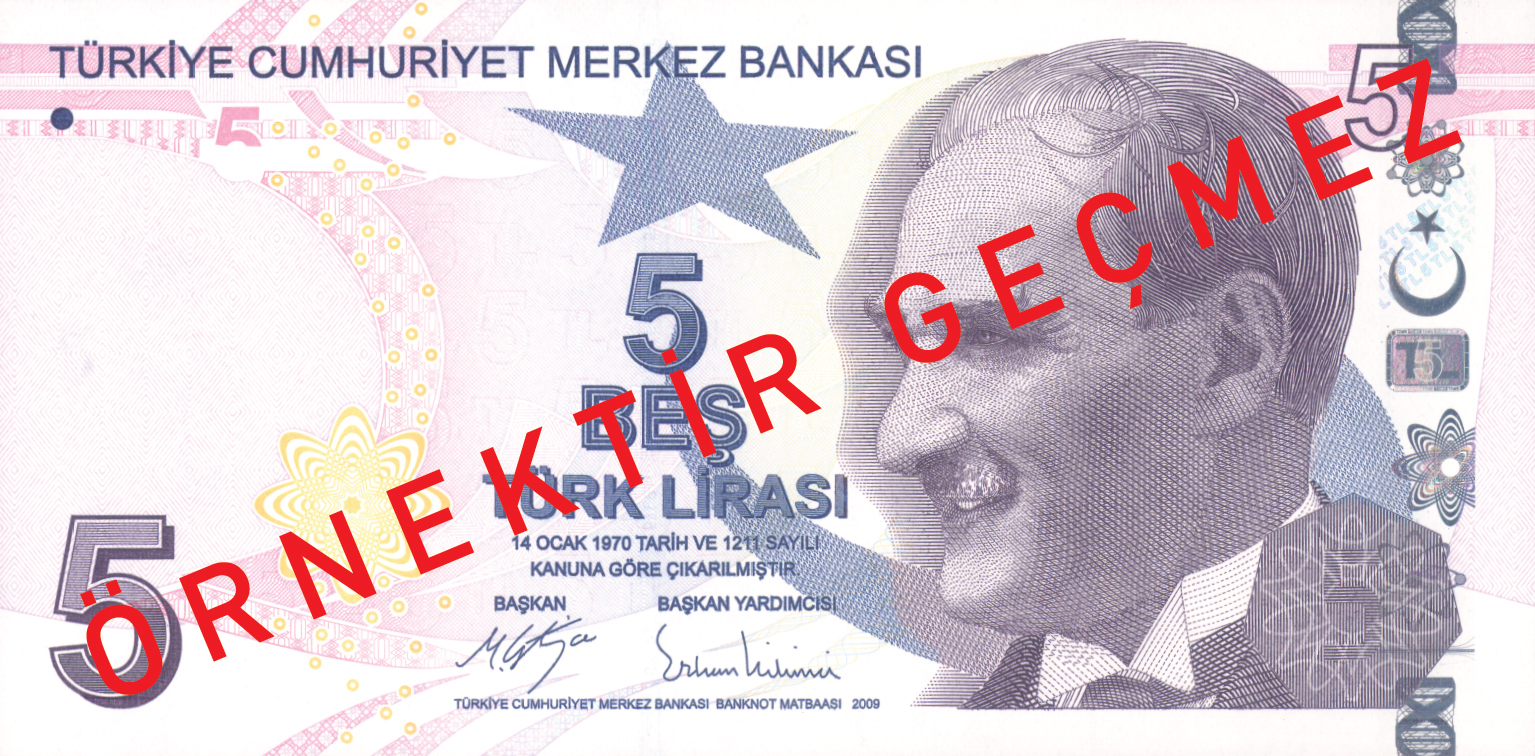
| Issue date | 27.03.2017 |
|---|---|
| Date of withdrawal | - |
| End of redemption period | - |
| Signatures | Murat ÇETİNKAYA, Erkan KİLİMCİ |
| Dimensions | 64x130 mm |
| Front design | A portrait of Atatürk |
| Back design | A portrait of Ord.Prof.Dr. Aydın Sayılı |
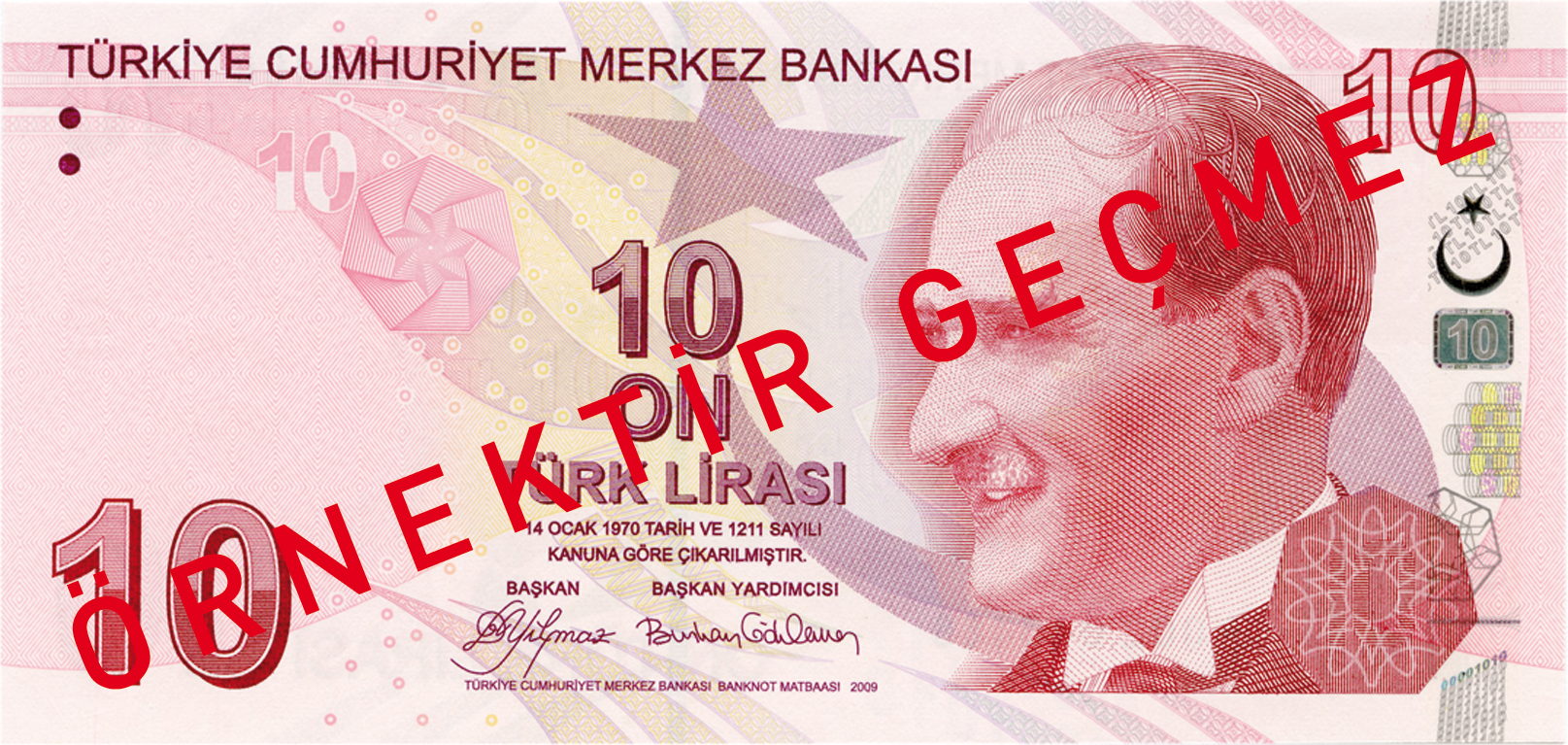
| Issue date | 1.1.2009 |
|---|---|
| Date of withdrawal | - |
| End of redemption period | - |
| Signatures | Durmuş YILMAZ, Burhan GÖKLEMEZ |
| Dimensions | 64x136 mm |
| Front design | A portrait of Atatürk |
| Back design | A portrait of Ord.Prof.Dr. Cahit Arf |
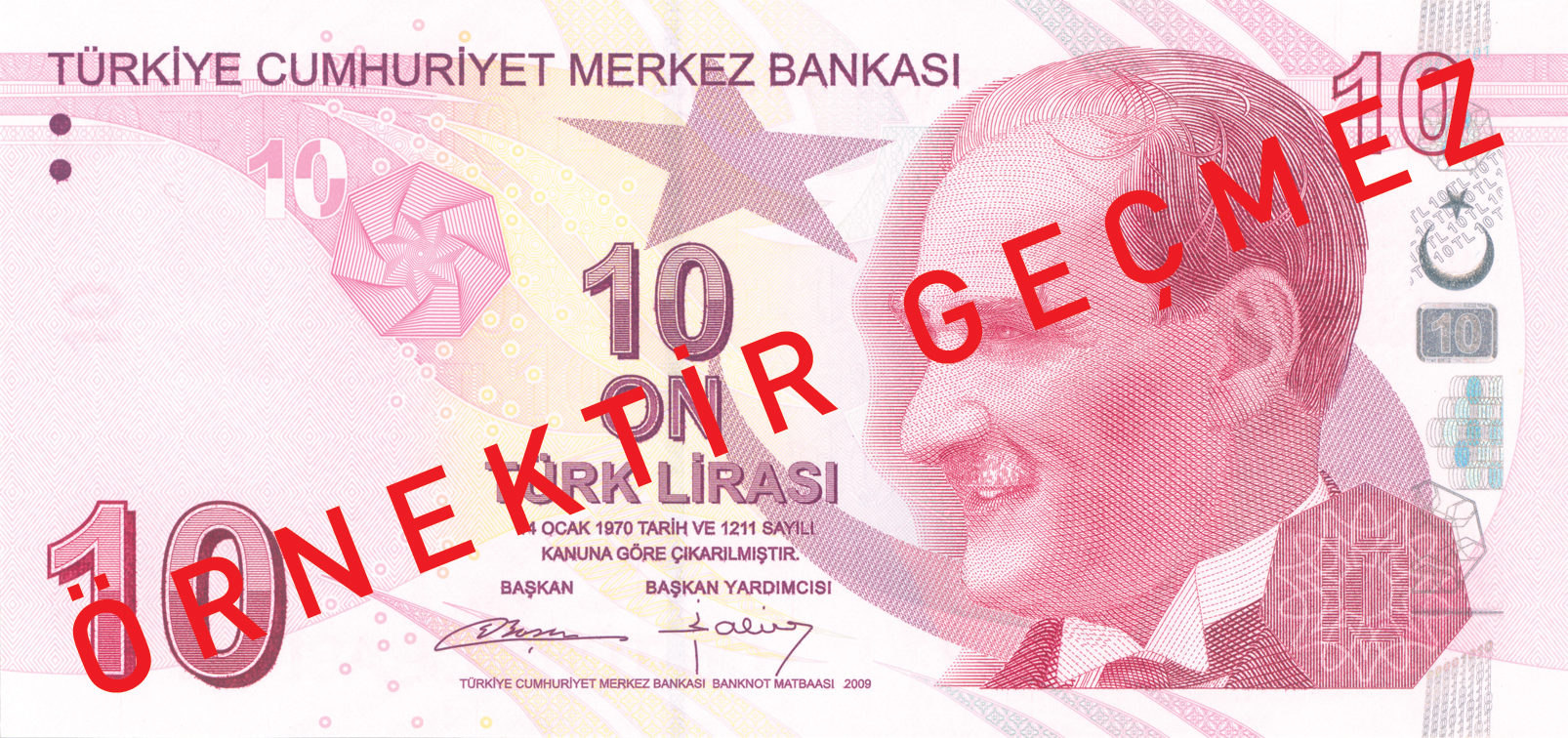
| Issue date | 24.12.2012 |
|---|---|
| Date of withdrawal | - |
| End of redemption period | - |
| Signatures | Doç.Dr. Erdem BAŞÇI, Necati ŞAHİN |
| Dimensions | 64x136 mm |
| Front design | A portrait of Atatürk |
| Back design | A portrait of Ord.Prof.Dr. Cahit Arf |
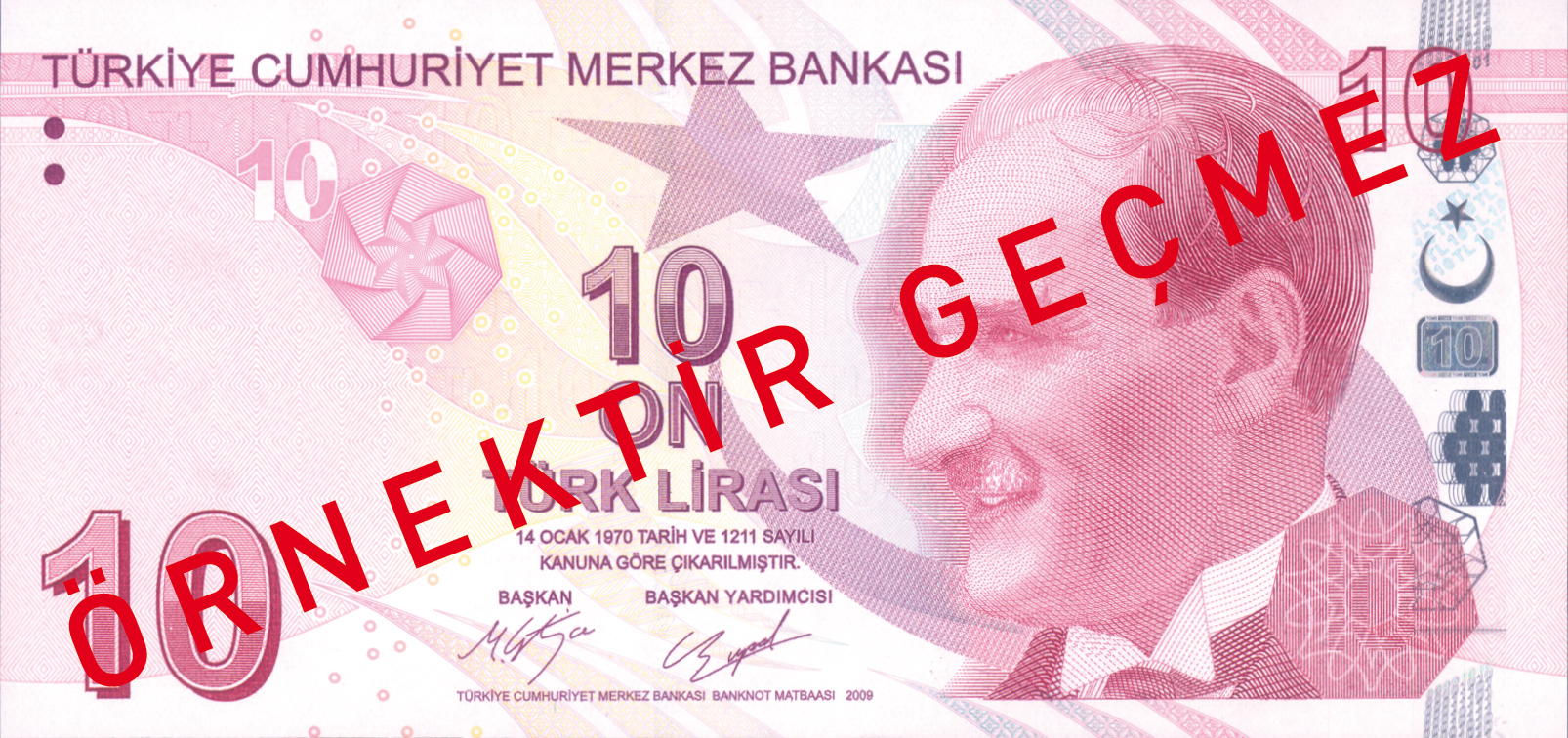
| Issue date | 27.03.2017 |
|---|---|
| Date of withdrawal | - |
| End of redemption period | - |
| Signatures | Murat ÇETİNKAYA, Murat UYSAL |
| Dimensions | 64x136 mm |
| Front design | A portrait of Atatürk |
| Back design | A portrait of Ord.Prof.Dr. Cahit Arf |
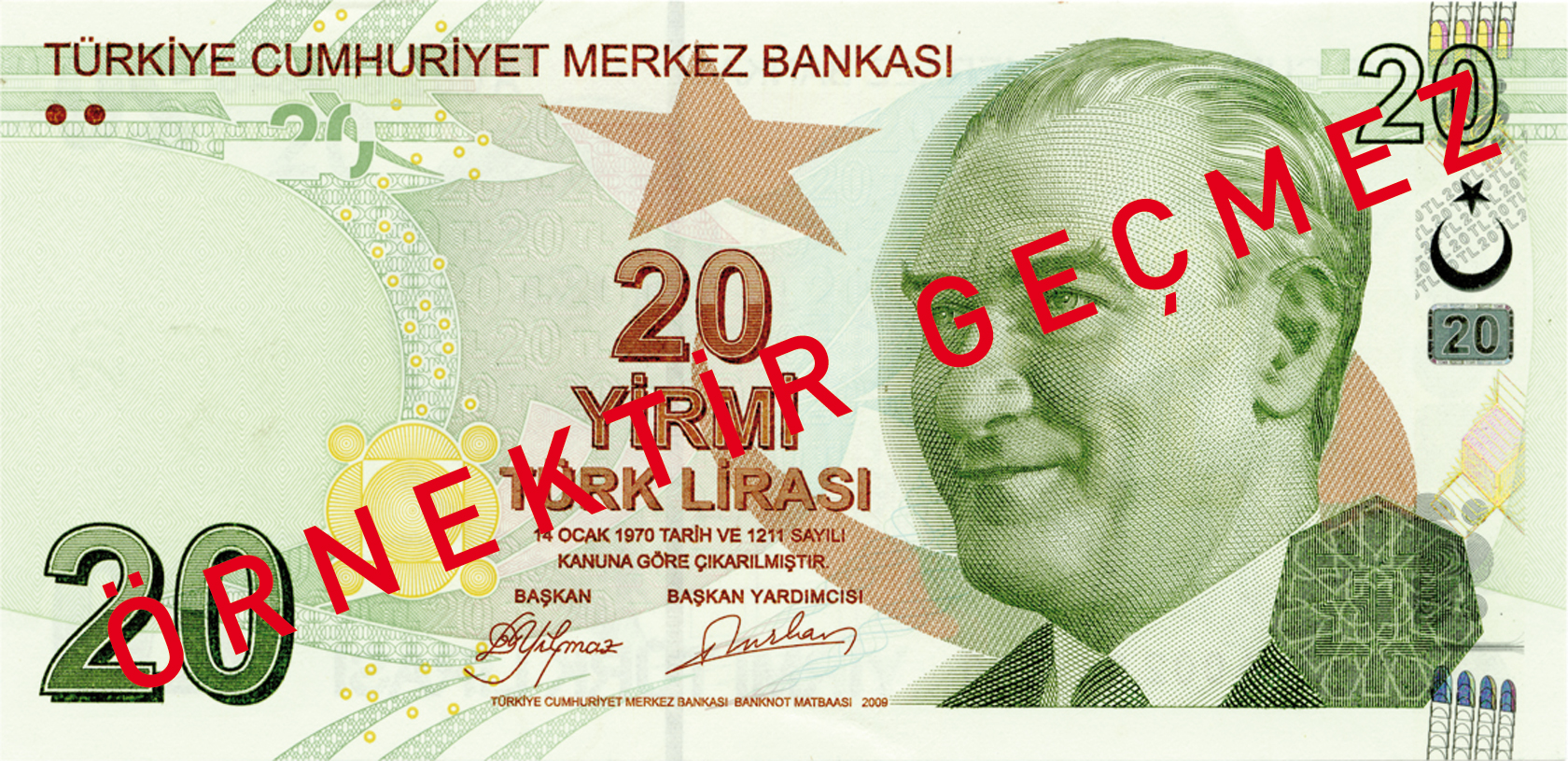
| Issue date | 1.1.2009 |
|---|---|
| Date of withdrawal | - |
| End of redemption period | - |
| Signatures | Durmuş YILMAZ, Dr.M. İbrahim TURHAN |
| Dimensions | 68x142 mm |
| Front design | A portrait of Atatürk |
| Back design | A portrait of Architect Kemaleddin |

| Issue date | 24.12.2012 |
|---|---|
| Date of withdrawal | - |
| End of redemption period | - |
| Signatures | Doç.Dr. Erdem BAŞÇI, Murat ÇETİNKAYA |
| Dimensions | 68x142 mm |
| Front design | A portrait of Atatürk |
| Back design | A portrait of Architect Kemaleddin |
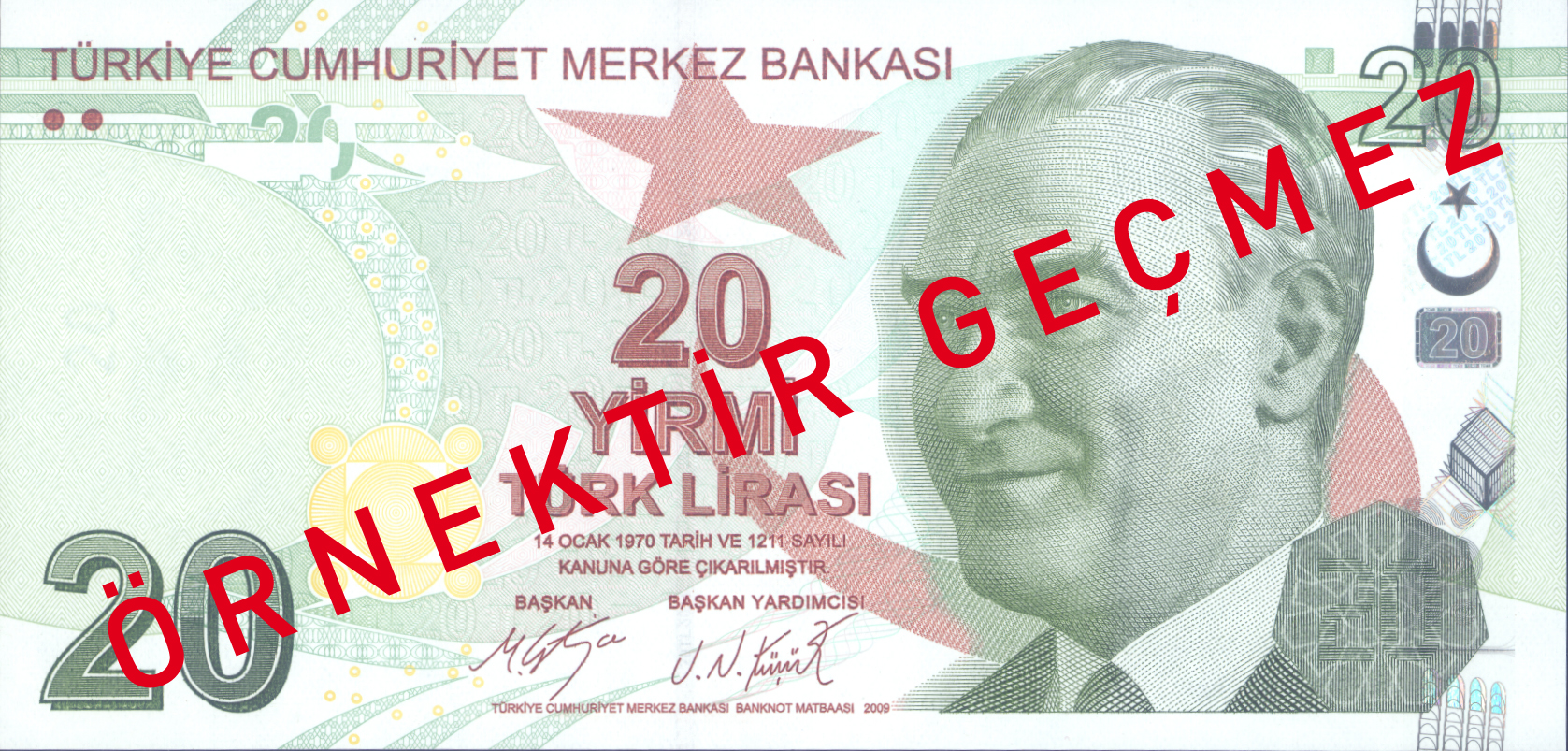
| Issue date | 24.12.2018 |
|---|---|
| Date of withdrawal | - |
| End of redemption period | - |
| Signatures | Murat ÇETİNKAYA, Dr. Uğur Namık KÜÇÜK |
| Dimensions | 68x142 mm |
| Front design | A portrait of Atatürk |
| Back design | A portrait of Architect Kemaleddin |
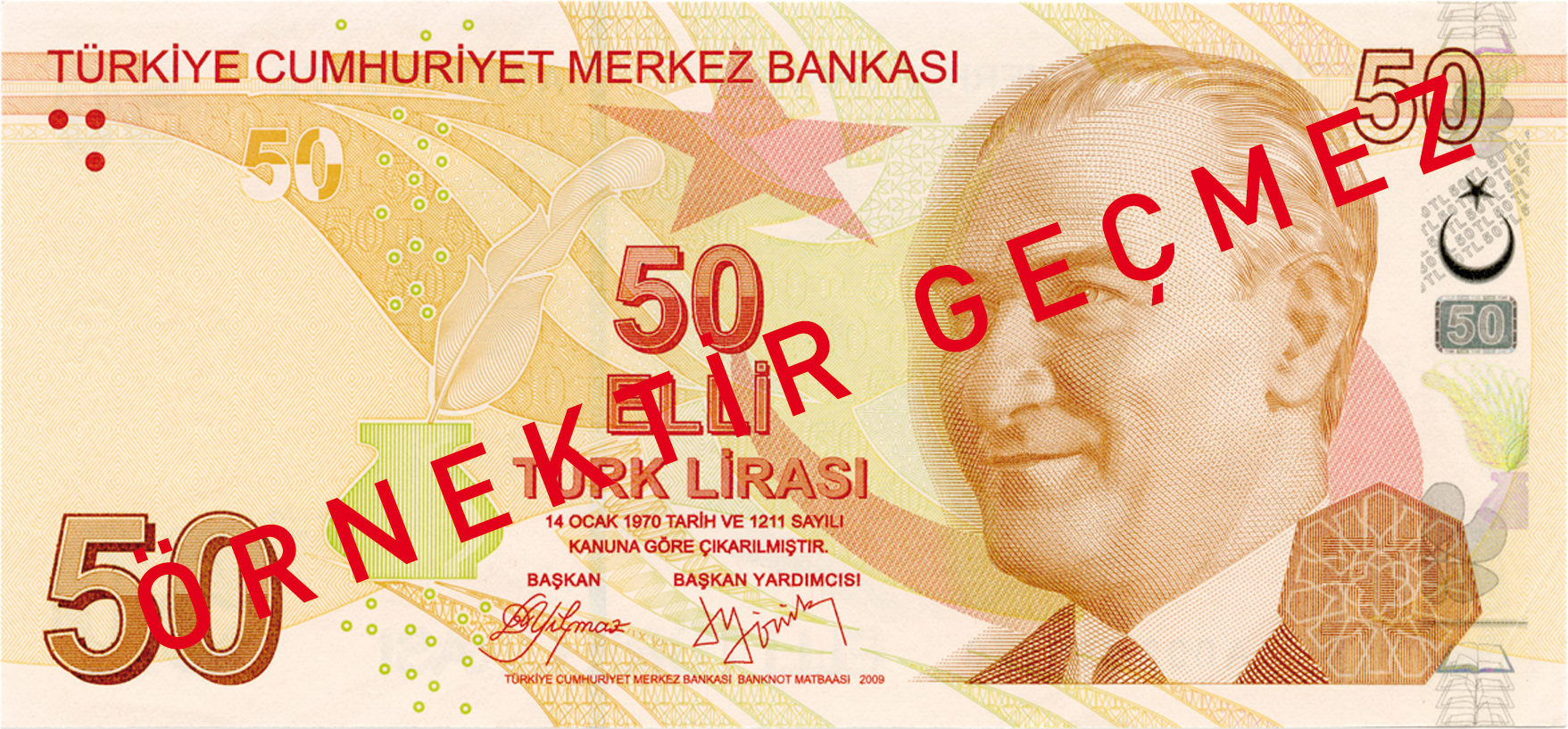
| Issue date | 1.1.2009 |
|---|---|
| Date of withdrawal | - |
| End of redemption period | - |
| Signatures | Durmuş YILMAZ, Doç.Dr.Mehmet YÖRÜKOĞLU |
| Dimensions | 68x148 mm |
| Front design | A portrait of Atatürk |
| Back design | A portrait of Fatma Aliye |
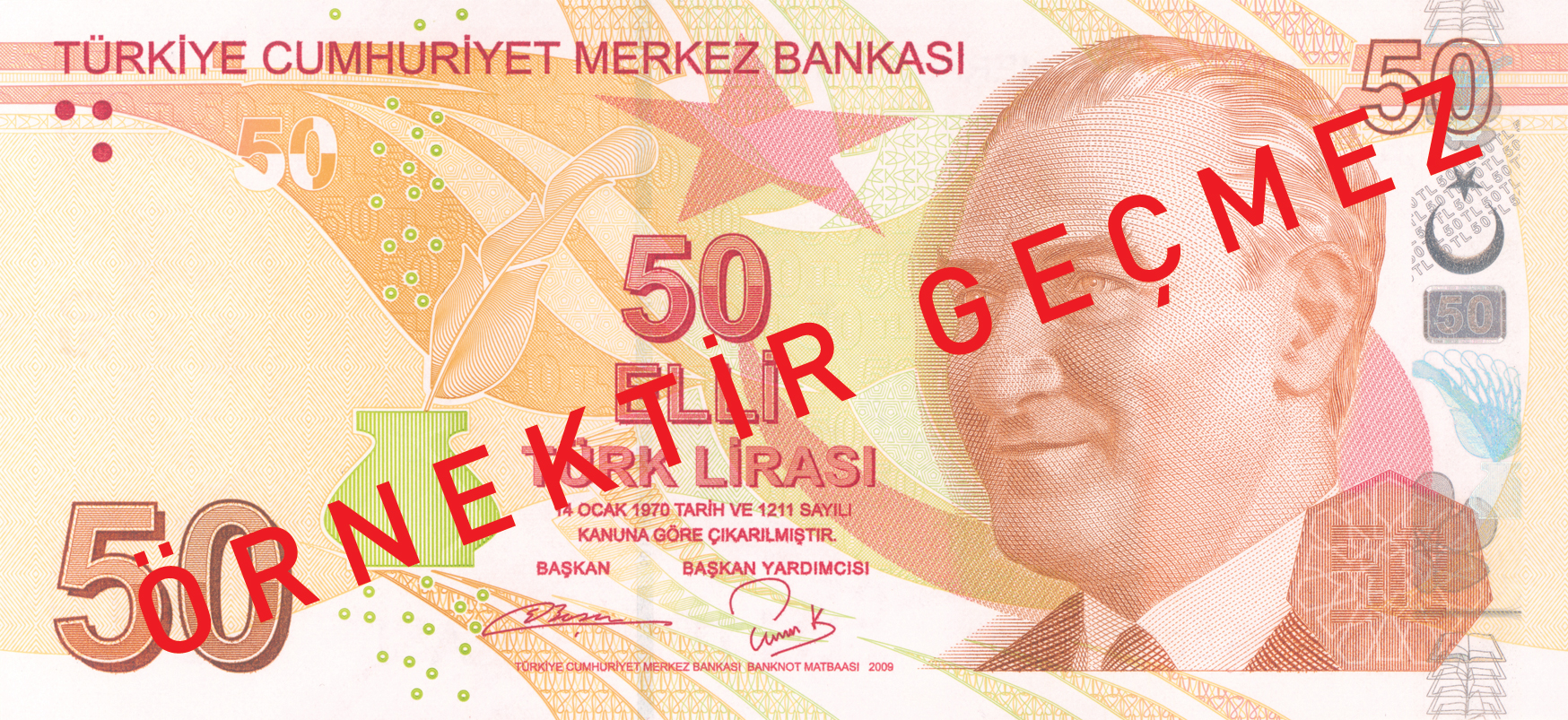
| Issue date | 08.04.2013 |
|---|---|
| Date of withdrawal | - |
| End of redemption period | - |
| Signatures | Doç.Dr. Erdem BAŞÇI, Prof.Dr. Turalay KENÇ |
| Dimensions | 68x148 mm |
| Front design | A portrait of Atatürk |
| Back design | A portrait of Fatma Aliye |
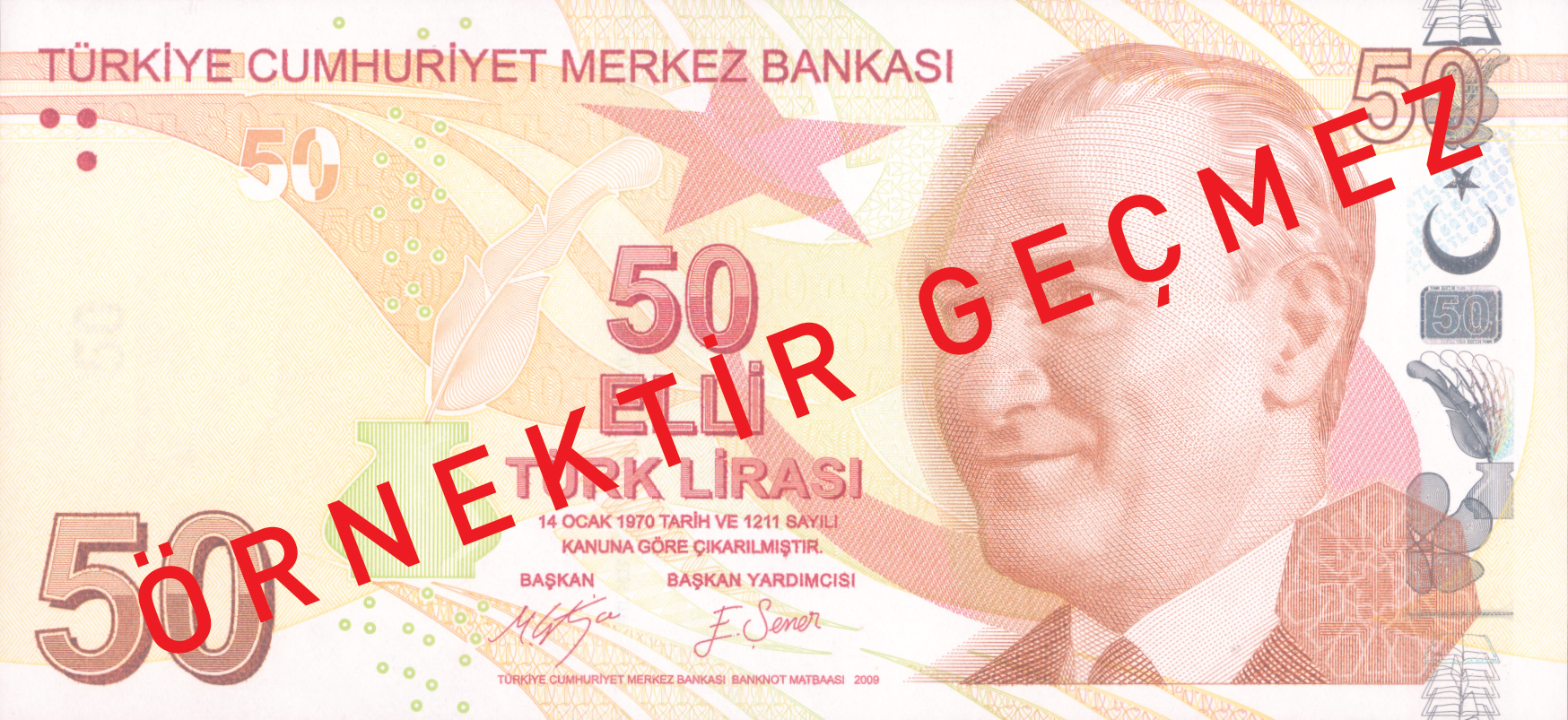
| Issue date | 17.07.2017 |
|---|---|
| Date of withdrawal | - |
| End of redemption period | - |
| Signatures | Murat ÇETİNKAYA, Dr. Emrah ŞENER |
| Dimensions | 68x148 mm |
| Front design | A portrait of Atatürk |
| Back design | A portrait of Fatma Aliye |
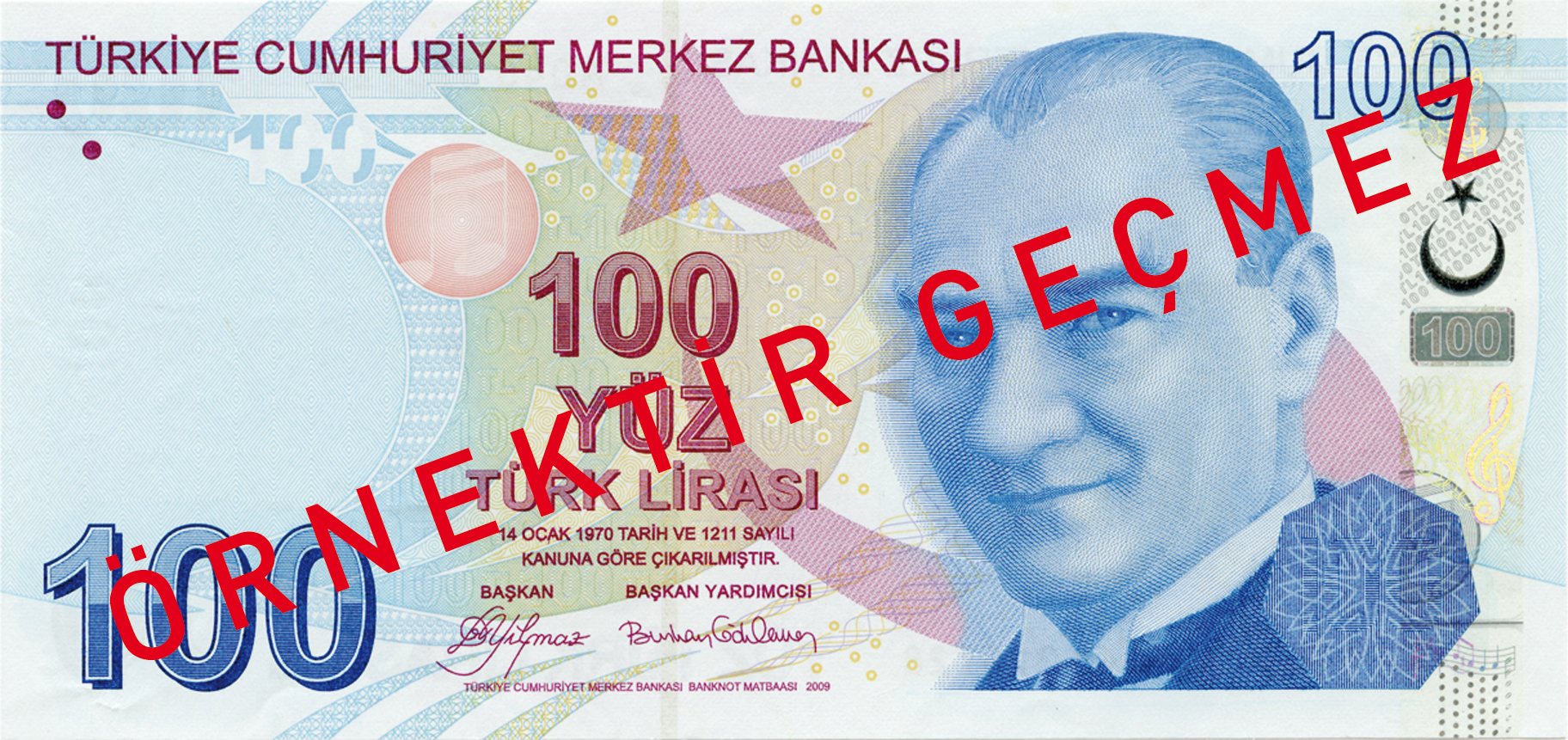
| Issue date | 1.1.2009 |
|---|---|
| Date of withdrawal | - |
| End of redemption period | - |
| Signatures | Durmuş YILMAZ, Burhan GÖKLEMEZ |
| Dimensions | 72x154 mm |
| Front design | A portrait of Atatürk |
| Back design | A portrait of Itri (Buhurizade Mustafa Efendi) |
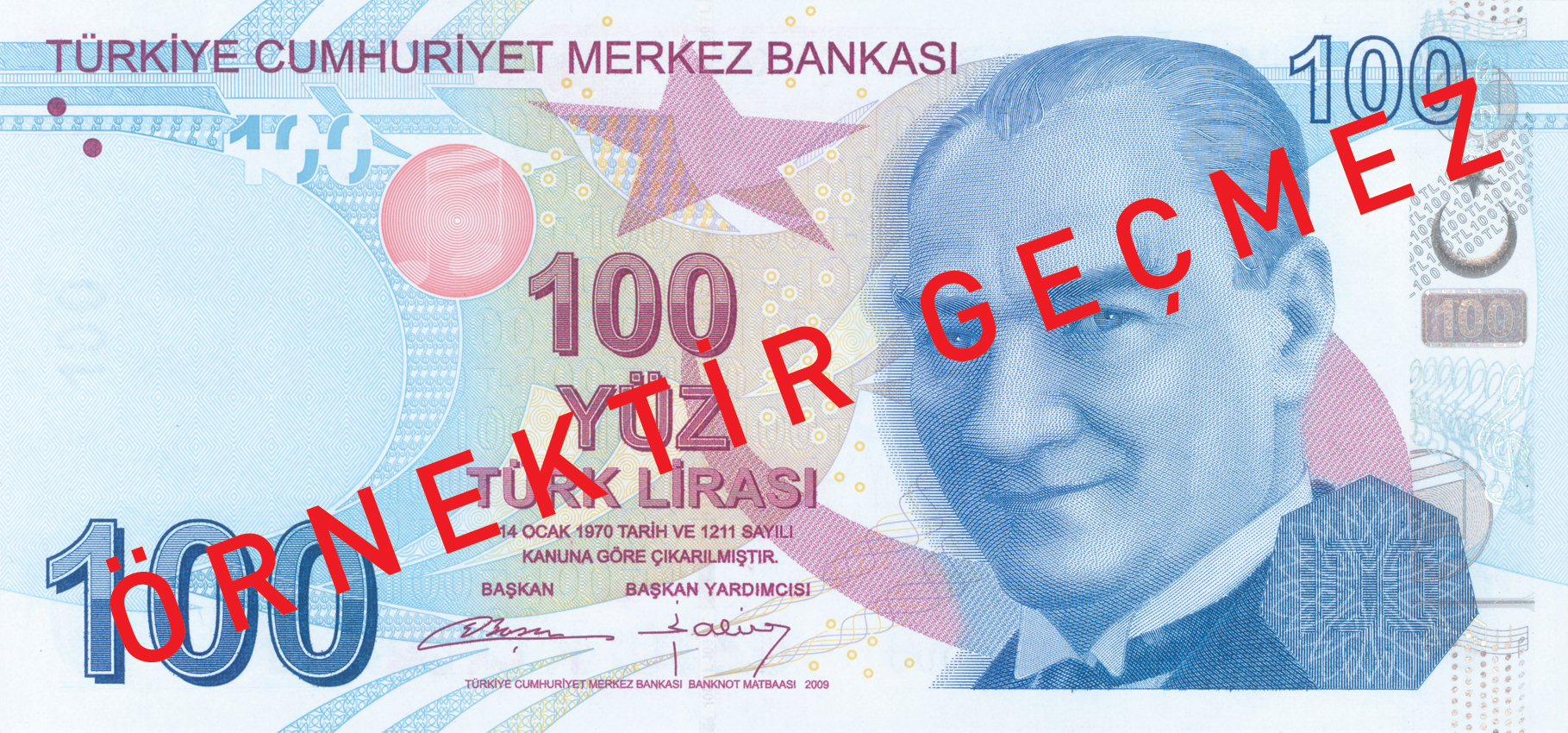
| Issue date | 24.12.2012 |
|---|---|
| Date of withdrawal | - |
| End of redemption period | - |
| Signatures | Doç.Dr. Erdem BAŞÇI, Necati ŞAHİN |
| Dimensions | 72x154 mm |
| Front design | A portrait of Atatürk |
| Back design | A portrait of Itri (Buhurizade Mustafa Efendi) |
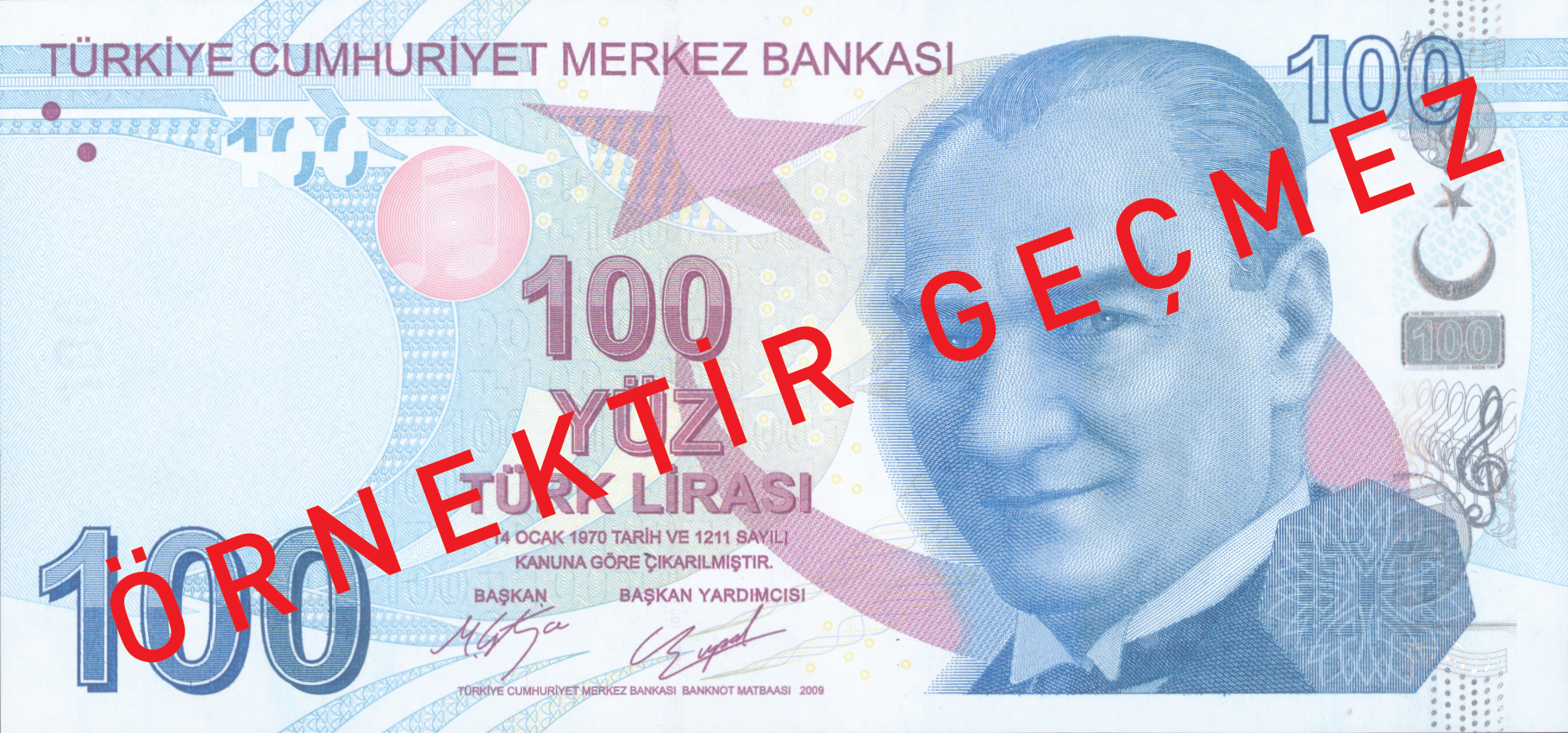
| Issue date | 17.07.2017 |
|---|---|
| Date of withdrawal | - |
| End of redemption period | - |
| Signatures | Murat ÇETİNKAYA, Murat UYSAL |
| Dimensions | 72x154 mm |
| Front design | A portrait of Atatürk |
| Back design | A portrait of Itri (Buhurizade Mustafa Efendi) |
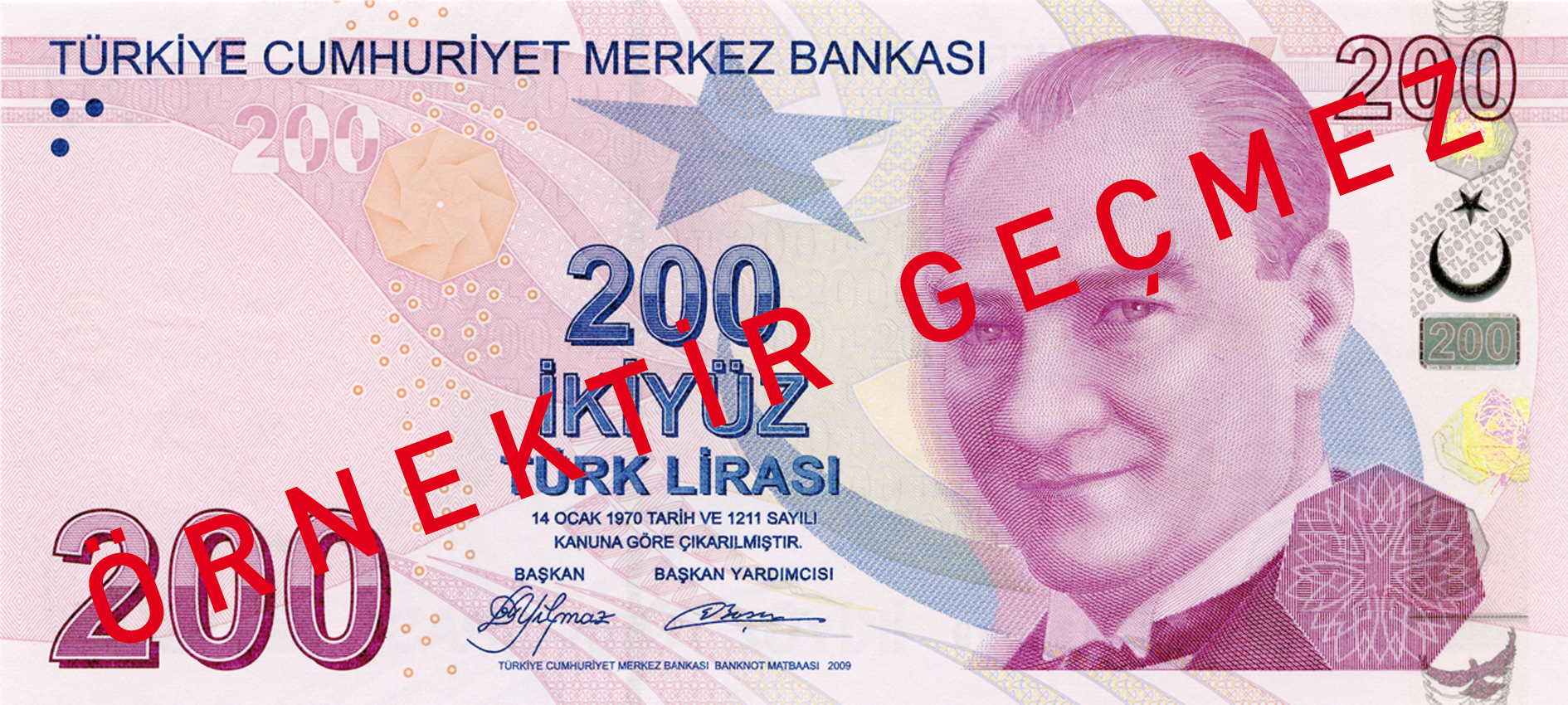
| Issue date | 1.1.2009 |
|---|---|
| Date of withdrawal | - |
| End of redemption period | - |
| Signatures | Durmuş YILMAZ, Doç.Dr. Erdem BAŞÇI |
| Dimensions | 72x160 mm |
| Front design | A portrait of Atatürk |
| Back design | A portrait of Yunus Emre |
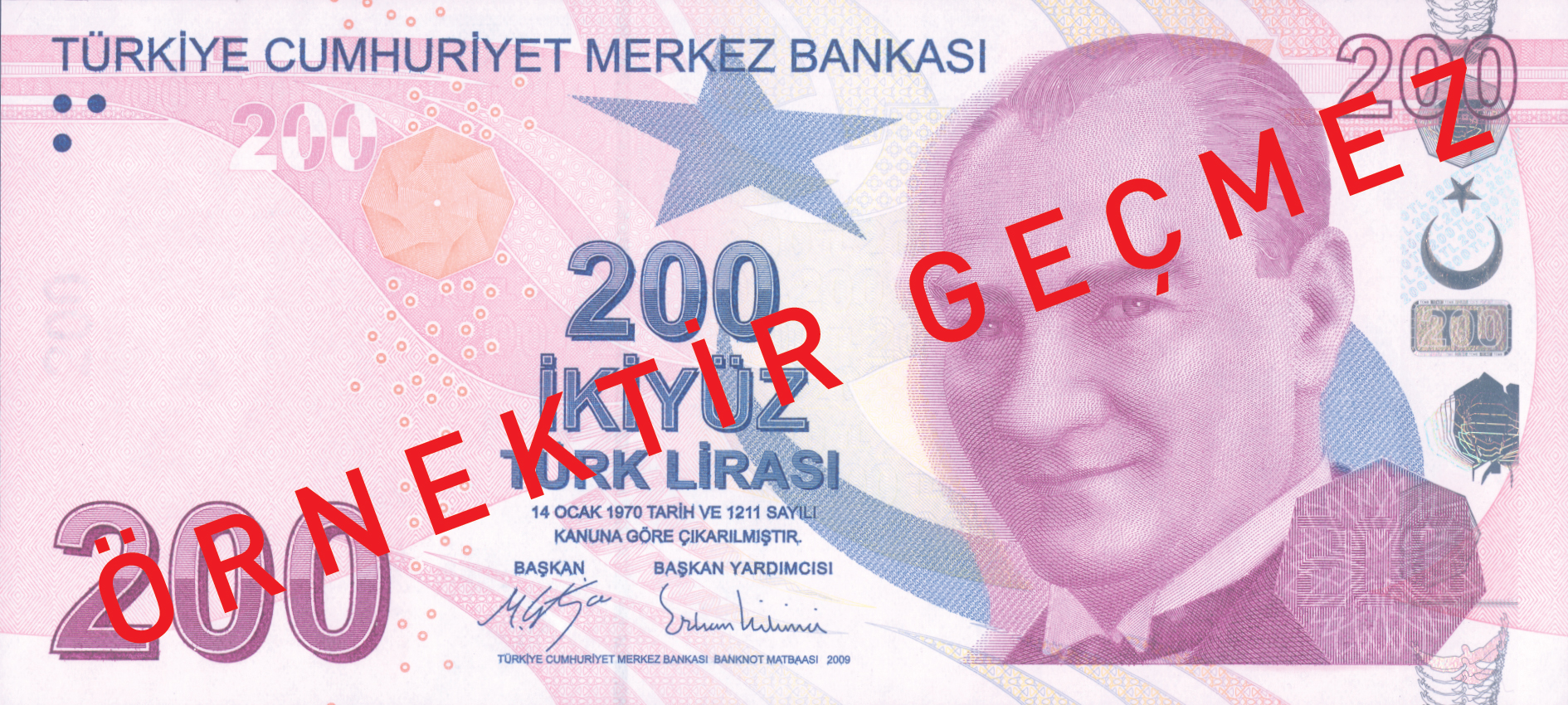
| Issue date | 27.03.2017 |
|---|---|
| Date of withdrawal | - |
| End of redemption period | - |
| Signatures | Murat ÇETİNKAYA, Erkan KİLİMCİ |
| Dimensions | 72x160 mm |
| Front design | A portrait of Atatürk |
| Back design | A portrait of Yunus Emre |
